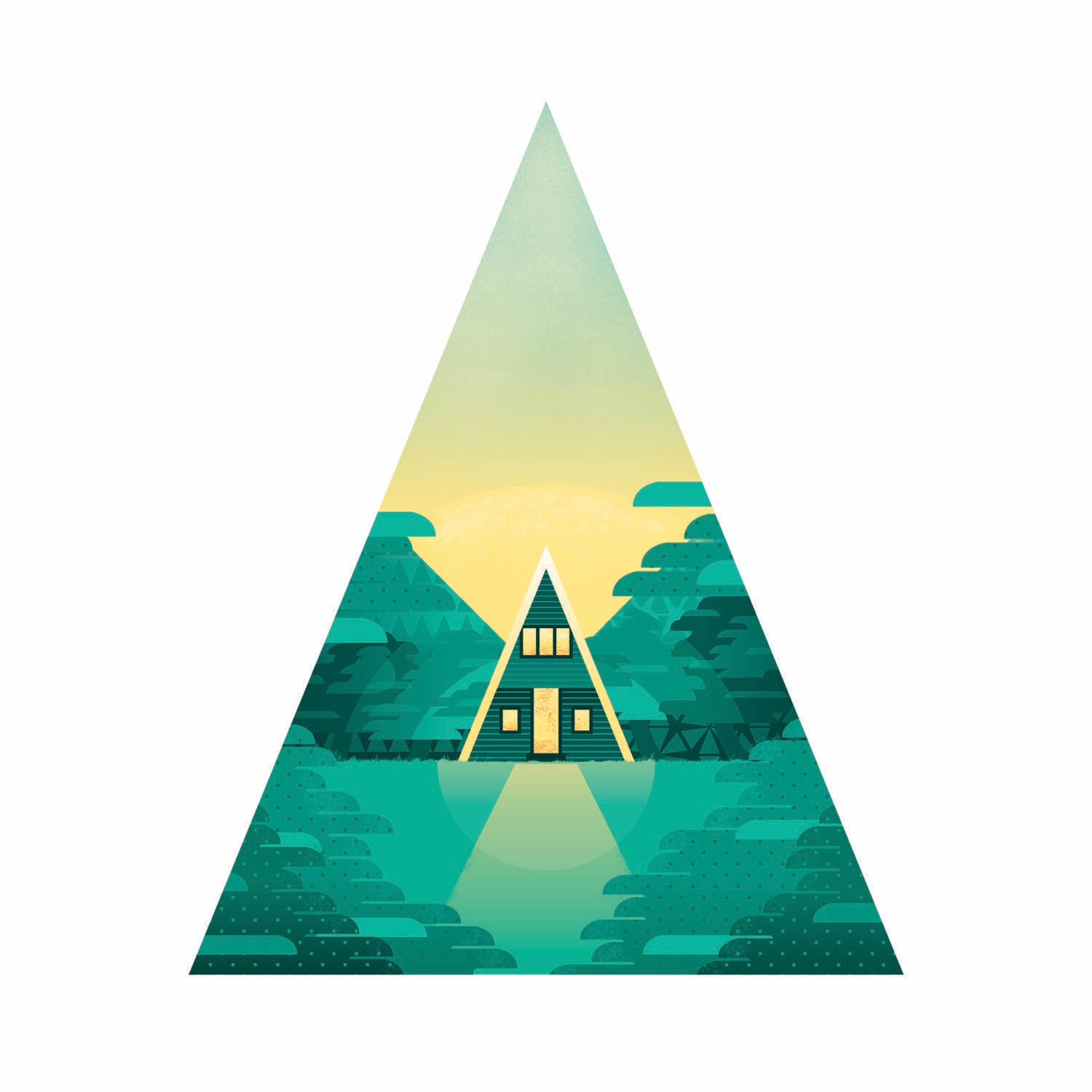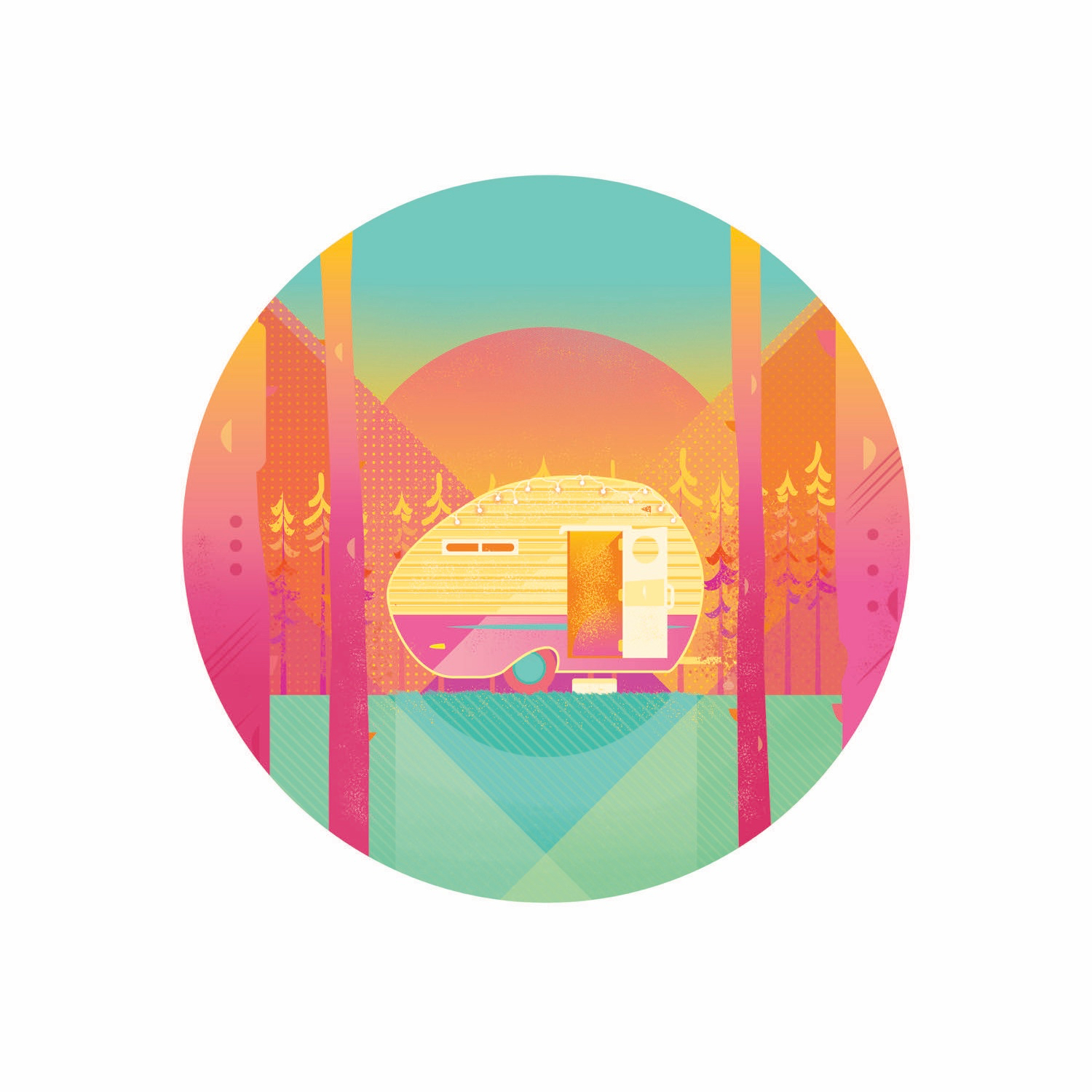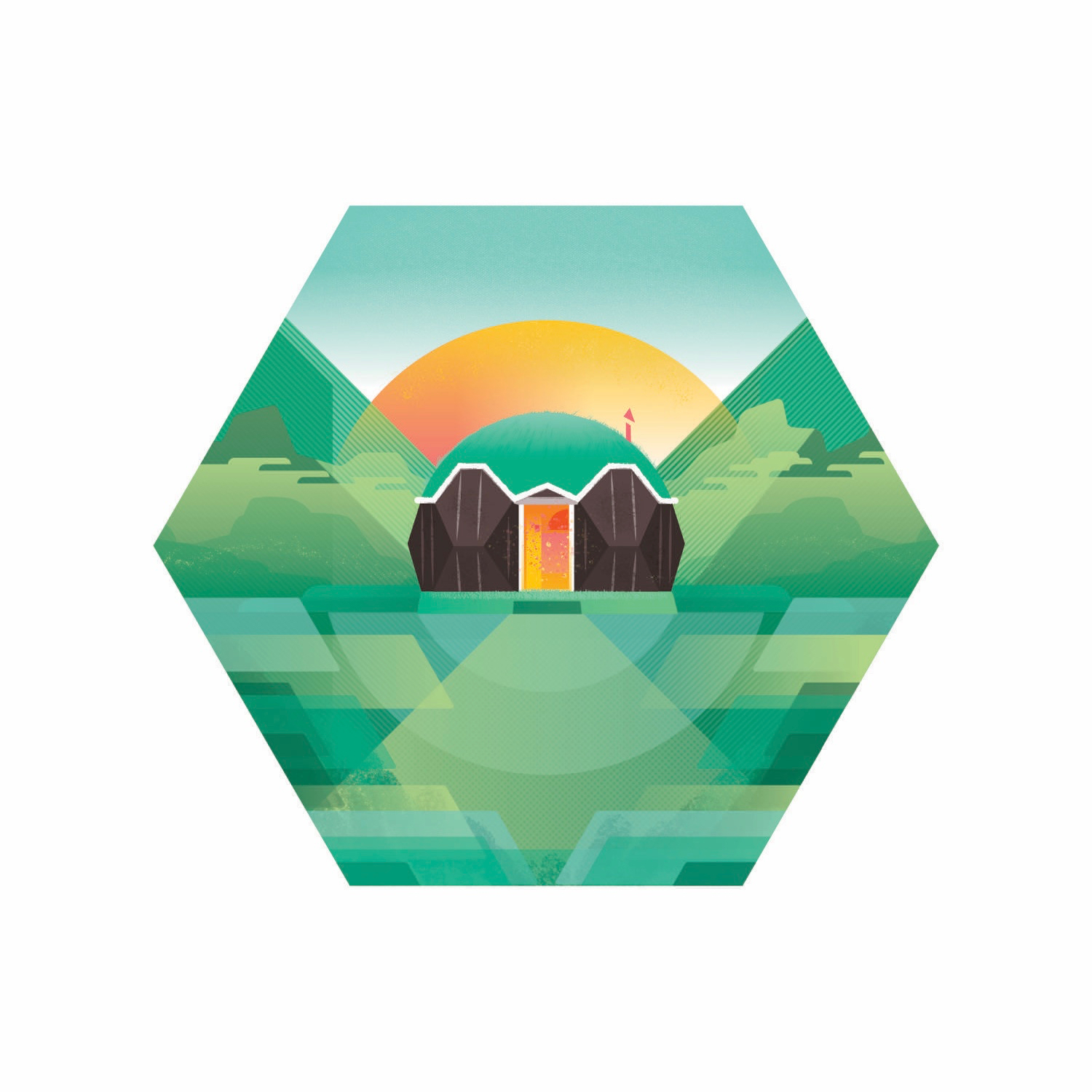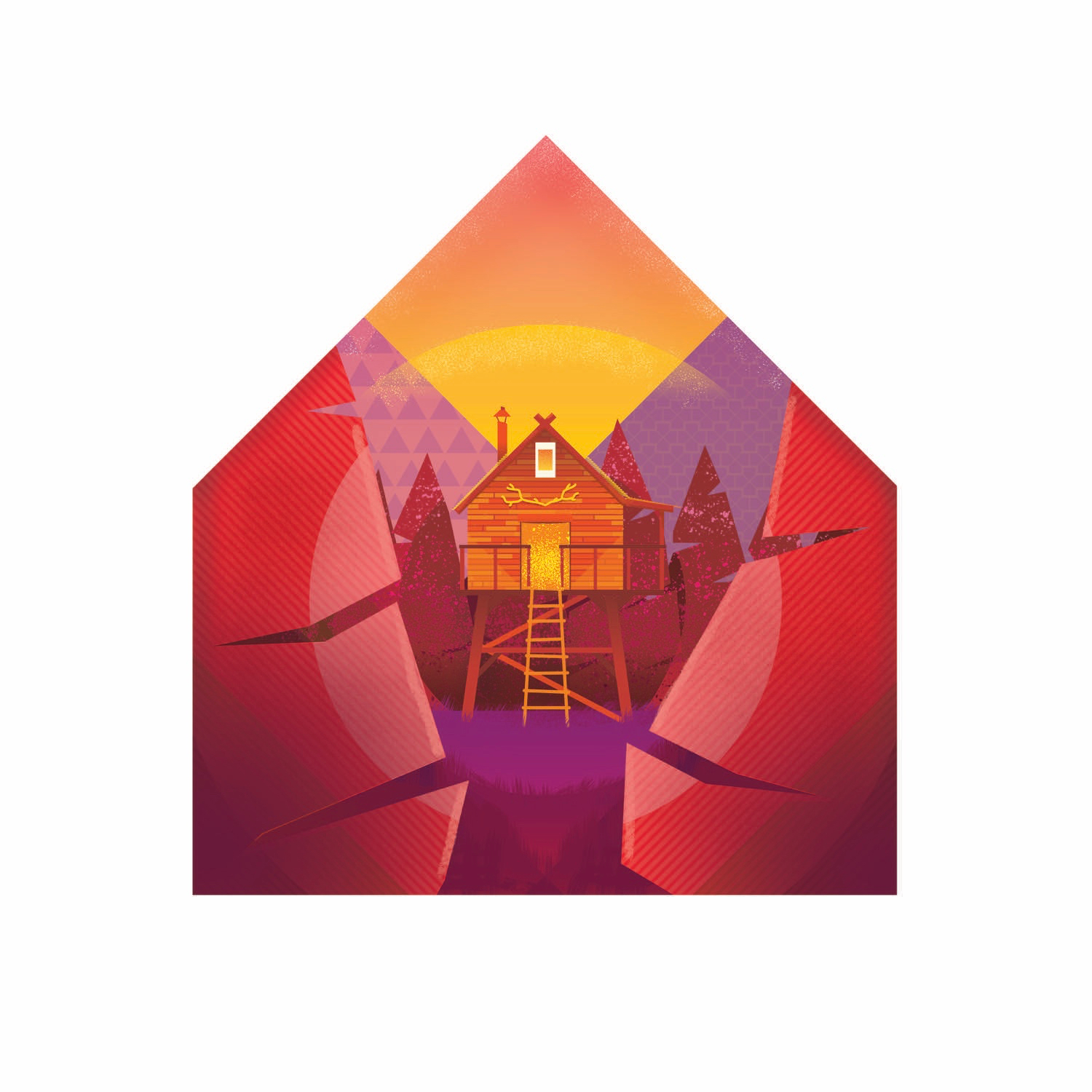
Inspirations
Explore the elevated life in the mountains. This content debuted in 2015 with Alpine Modern’s printed quarterly magazine project.
Pictorial Road Trip—Peaks and Lakes in Colorado
Denver filmmaker and photographer Grant Lemons experiences seasonal Colorado landscapes from behind his lens
Born in Salem, the rainy capitol of Oregon, as he calls it, filmmaker and photographer Grant Lemons currently lives in Denver, Colorado, where his sense of adventure awakened. From here, he ventured out into Colorado’s beautiful—and at time mysterious—landscapes of fall and winter.
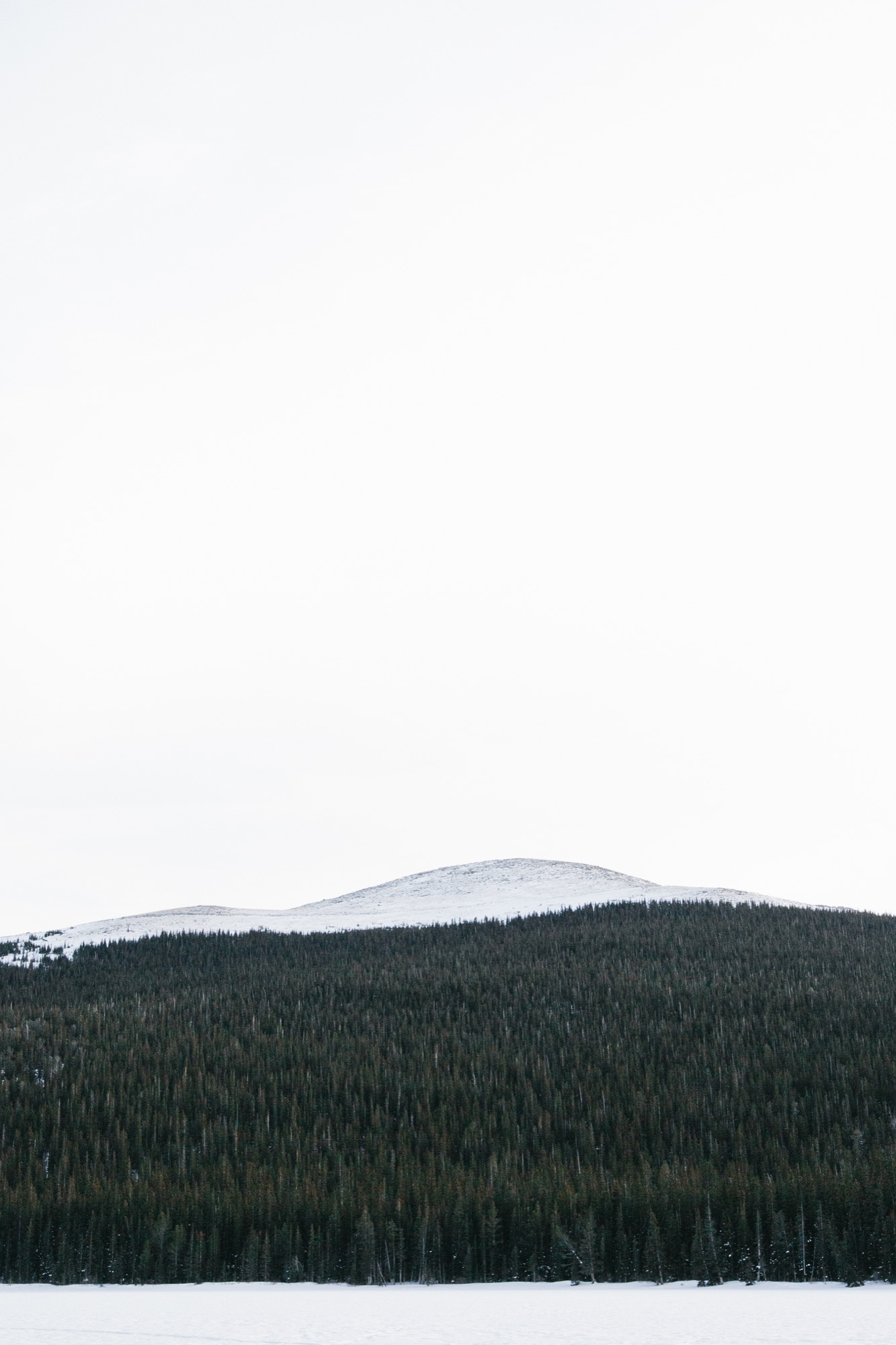
Lemons majored in journalism at the University of Oregon and plans move to Portland this summer.
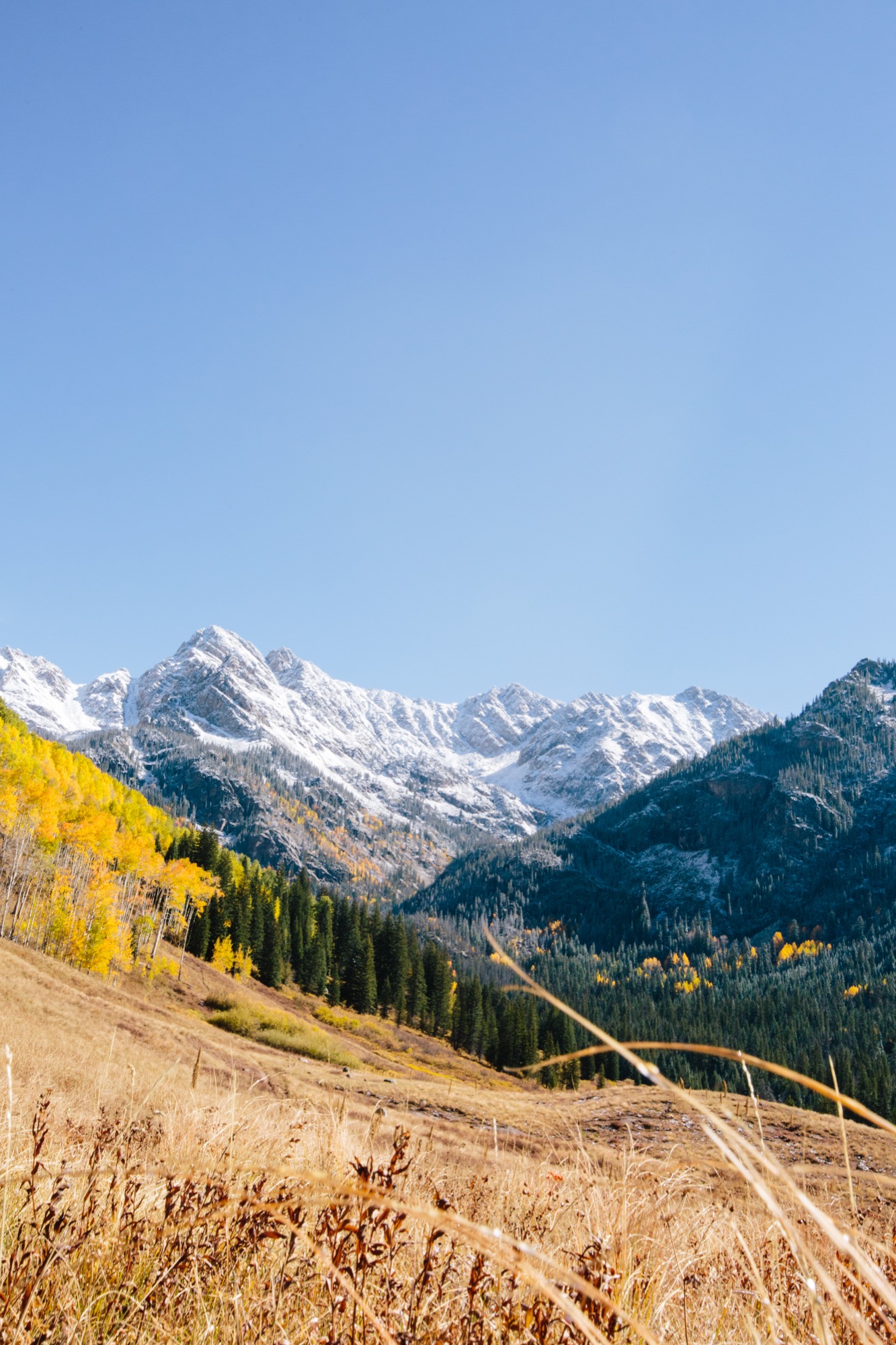
A conversation with filmmaker and photographer Grant Lemons
AM Who are you, in a nutshell?
GL I’m a high-energy guy who loves to capture new places and people... all while listening to hip-hop. I try to run whenever possible, too.
AM When and how did you know you wanted to pursue photography?
GL Simply put, making videos drove me to photography. Like many other people in my industry, I obsessed over telling stories with my camcorder at a young age. Over time, as new gear came and went, and I fell in love with the craft of making films and this passion for the technical aspects began to translate to photography. That initial pivot toward taking photos only happened a couple years ago, and now I find that I spend my days doing somewhere around 70% photo and 30% film. The photo bug bit me, and I've been hooked ever since.
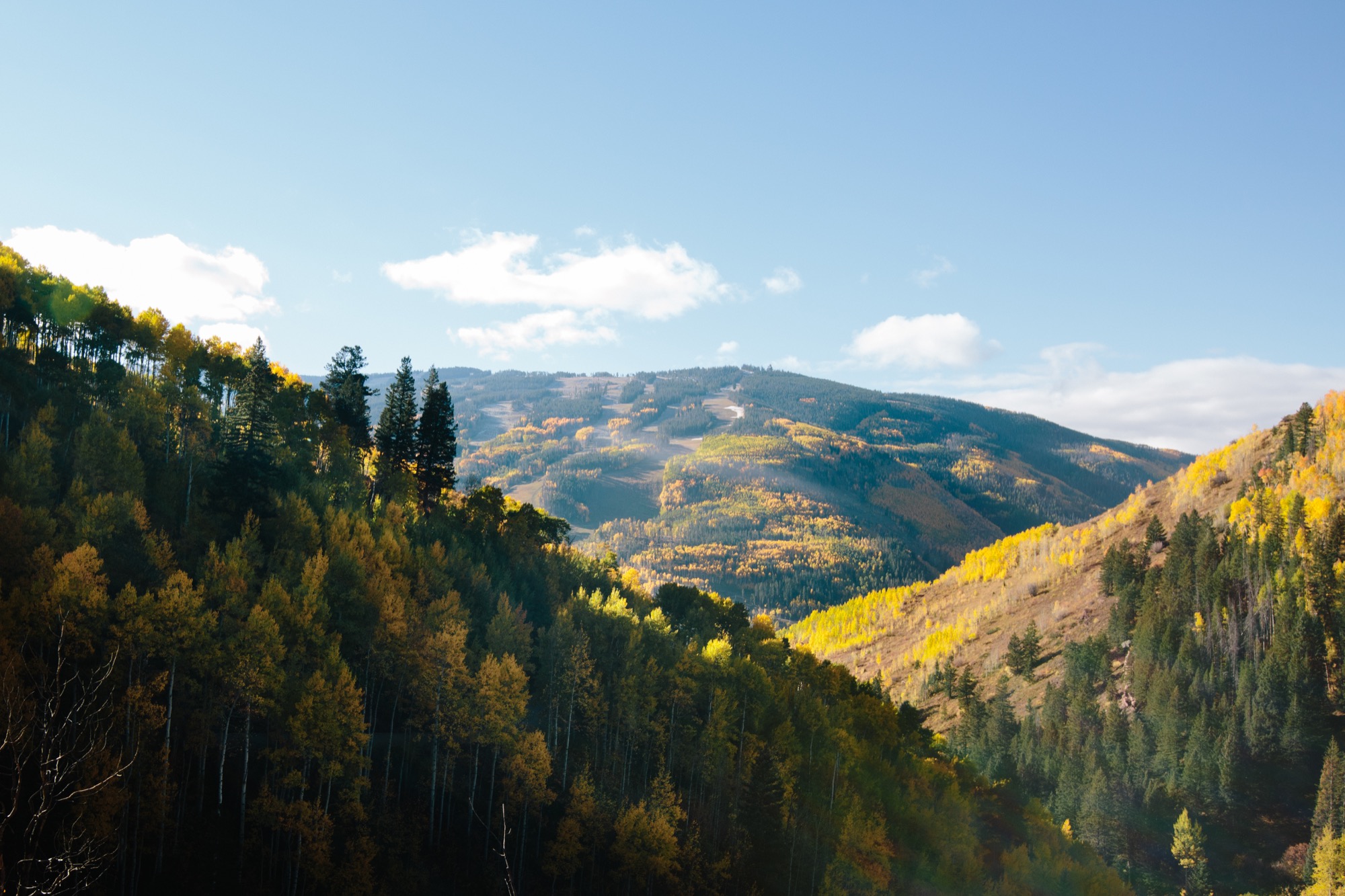
AM How did you learn to be a photographer?
GL Ironically, I never took a photography class while in school. Instead, I learned about the documentary approach to film and to telling stories the entire time. I really learned photography by spending as much time as possible with people who are ten-times the photographer I am. I went on adventures with them and experienced their differing styles. I'm always looking for more opportunities like that. YouTube tutorials are a plus, too.
AM What inspires your work?
GL My friends, my family, and the everyday environments that I find myself in. I try to find inspiration at every possible turn. Additionally, moving to Colorado spurred a real yearning for adventure within me. It's a surreal feeling capturing all you can at 10,000 feet and above.
AM What do you hope people experience when they look at your photography?
GL Wanderlust is an overused word for the feeling many people get when looking through photographs. With that being said, what I hope people get out of my work is a sense of exploration in a really broad sense of the word. No matter where you are, there are interesting moments and places to capture. That's what I seek to do every day when I can, no matter what place I find myself in. I hope when people see my work, they feel motivated to do the same—whether it's in the city or the mountains.
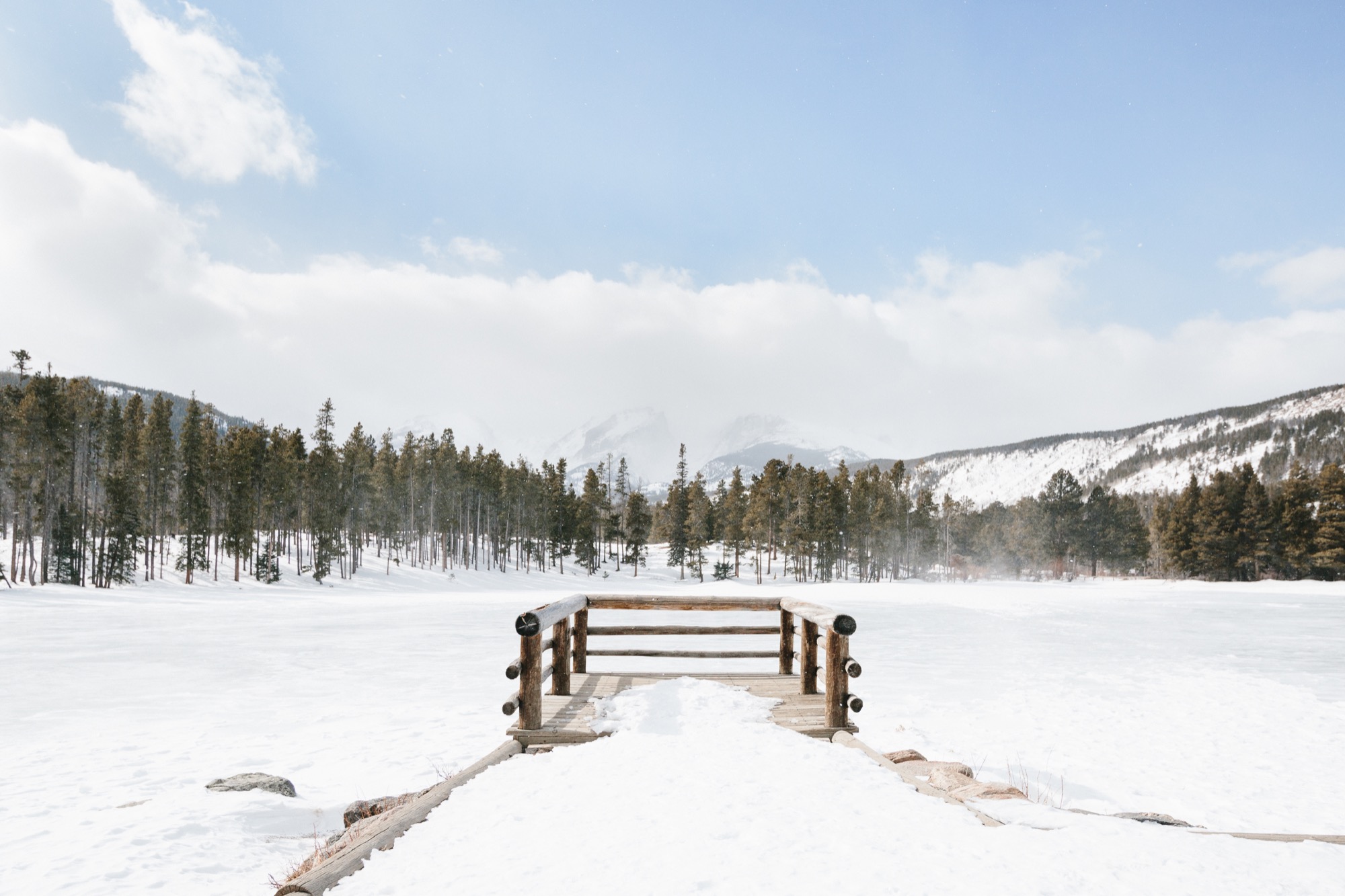
AM What makes you an alpine modernist?
GL At my very core I am a simple person. I don't keep many possessions in my orbit, and I enjoy a strong cup of coffee every morning while the sun rises. As it stands right now, my ideal day is an early wake up at 5:00 AM, heading west to the Rockies, and snow-shoeing in fresh powder to capture the early morning light shining on the mountains.
AM What do the mountains mean to you?
GL Growing up in Oregon, we held the mountains we do have in the state with high esteem—and we do have some remarkable peaks. When I visited Colorado for the first time the enormity and sheer amount of peaks that surrounded me blew me away. Here in Colorado, the mountains represent everything that is good in life, and it would be hard to escape them. Having the wild right at my doorstep with the Rockies took things to the next level for me, and the mountains are a constant blend of fun, adventure, and wonderment.

AM What is special about photography in the mountains?
GL Unlike other environments or subjects, time moves differently in the mountains. On one hand, I feel acutely aware of time and its shifting presence on the landscape in front of me. On the the other hand, I have no grasp on how time is moving when I begin to get in the flow of it all. Hours peel away. It's both a calming and challenging experience when considering the conditions that can come up in the winter, too. A lot of paradoxes, to be certain. It's one of the most rewarding landscapes to conquer and capture.
AM What’s your favorite place in the world?
GL At this point in my life, Portland is my favorite place in the world. An energy kicks into my system every time I touch down there, and it's stacked to the brim with people creating cool things. I really feel like I'm a part of the city in every way. My hometown of Salem, Oregon, is on the come-up, so I have to give it a big shout out too.
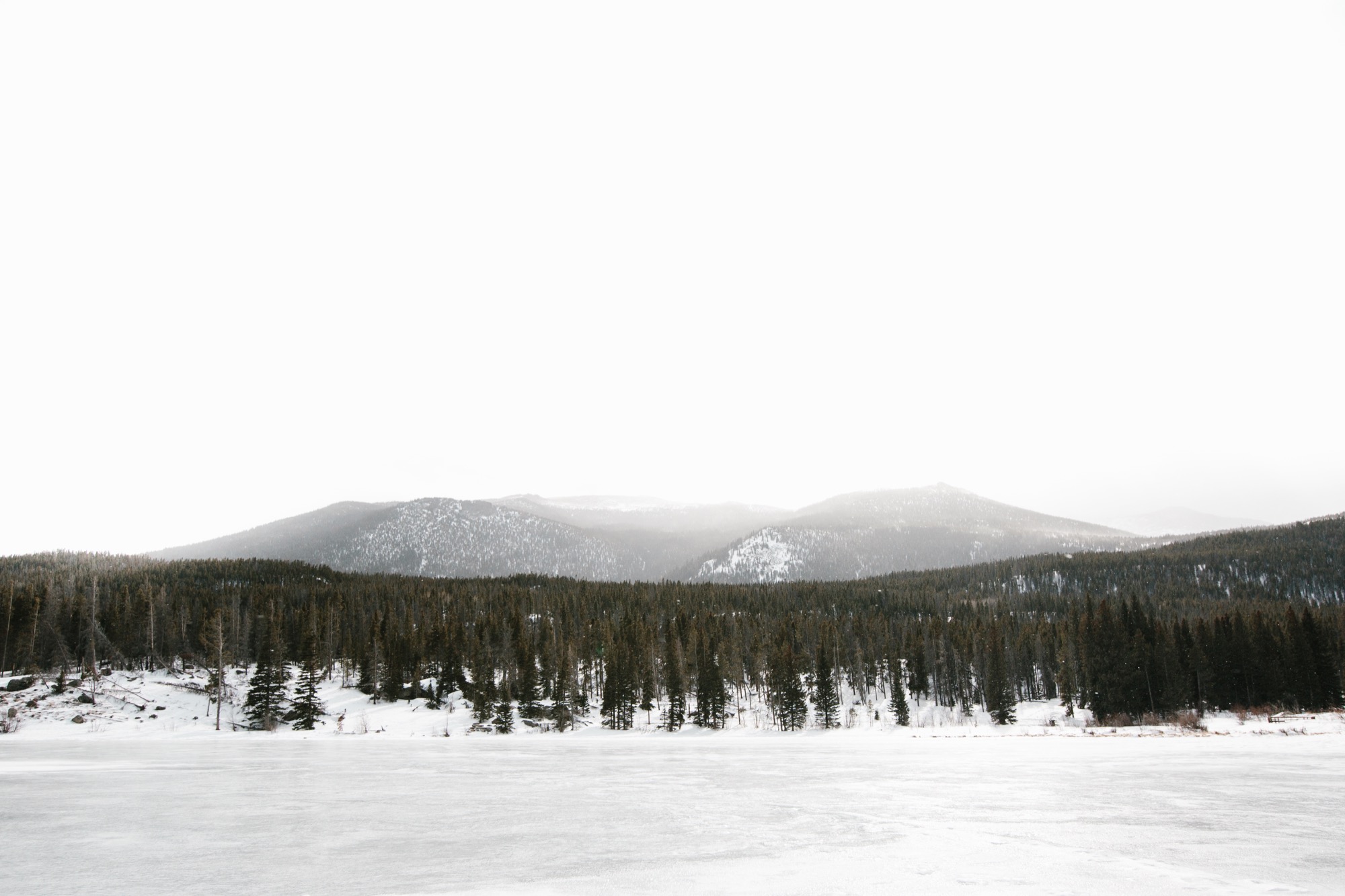
AM What are you working on these days?
GL I'm prepping to capture a short music tour in Europe in March. Recently, I've been lucky enough to have extra time to work on passion projects, which coincidentally, leads me to the mountains. I'm trying to use every day as an opportunity to capture a different Coloradan moment as my time to move away approaches. I'm really thankful to be around for another (somewhat) snowy winter. △
After It, Covered
After a cold night stranded in their van, Wylie Robinson and his friend and co-founder Nick Polinko created Rumpl, a sleeping-bag blanket.
After a cold night stranded in their van, Wylie Robinson and his friend and co-founder Nick Polinko created Rumpl, a sleeping-bag blanket.
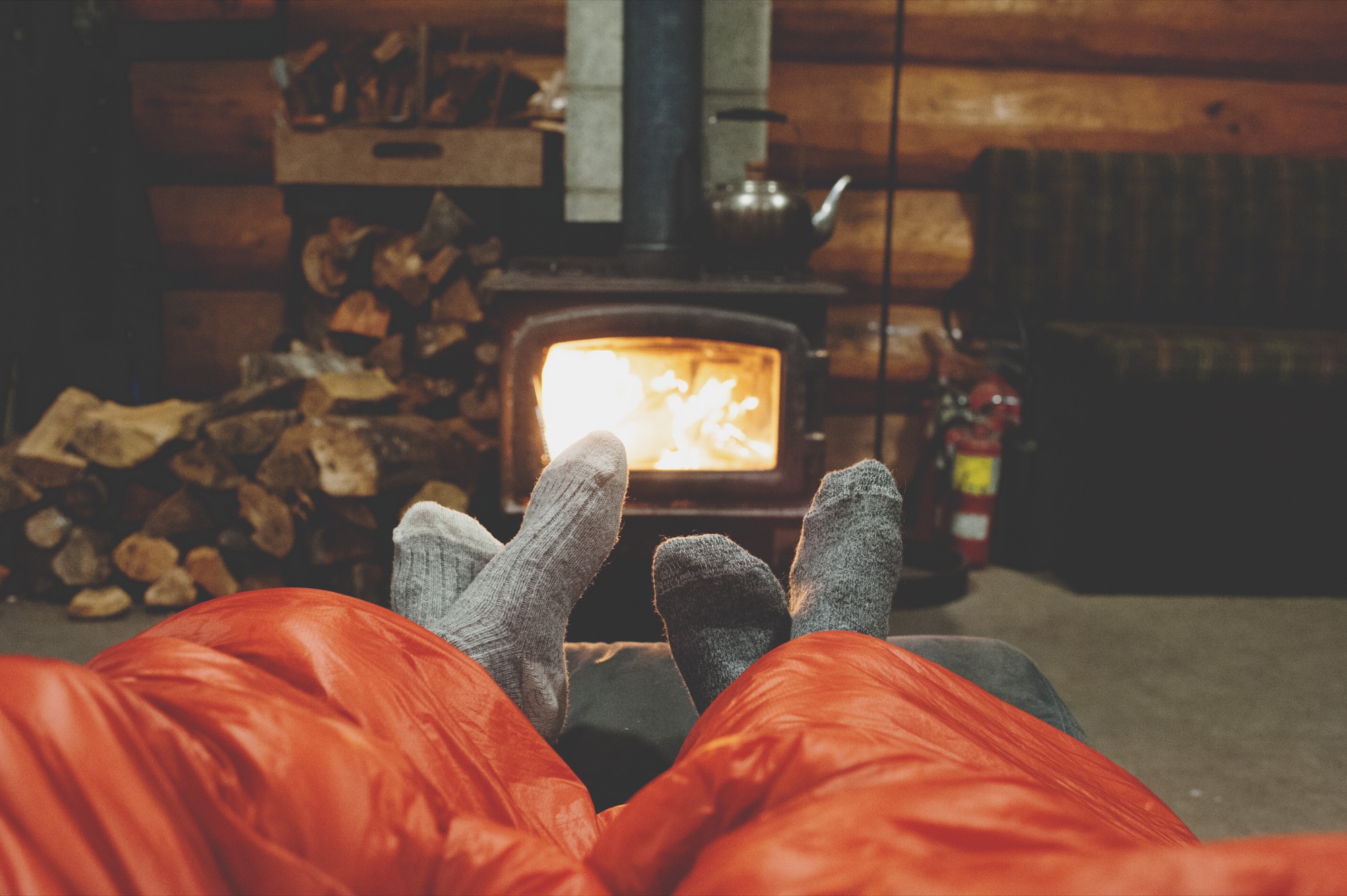
The San Francisco native studied environmental design at the University of Colorado Boulder and graduated in 2007 with an emphasis in architecture and business. Robinson stayed in Boulder, where he worked as a designer at Communication Arts for a couple of years, before returning to California to work for MKTG and later for Landor Associates. Today, the thirty-one year old lives at Ocean Beach in San Francisco with his fiancé.
Alpine Modern caught up with the entrepreneur to talk about the making the first Rumpls, what “home” means to the designer, and the little things in life that make him happy.
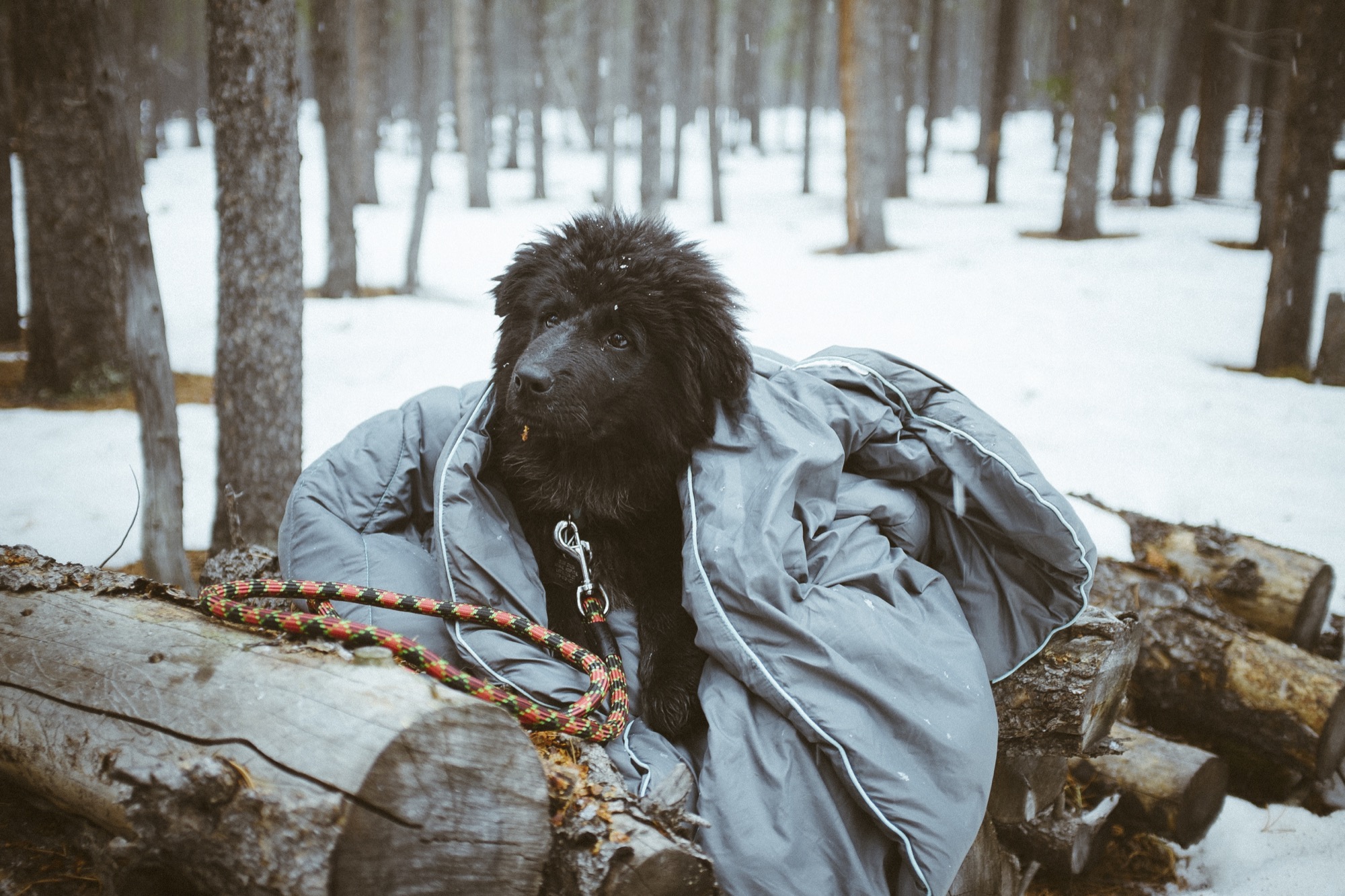
A conversation with Rumpl Founder Wylie Robinson
AM Who are you, in a nutshell?
WR I am an easily inspired creative person who loves the outdoors. I spend most of my time obsessing over my business while fantasizing about being in remote places with no internet. And one does not help the other!
AM Along your path, what experiences and encounters made you who you are today?
WR Growing up in San Francisco and living in Colorado for seven years was huge. In San Francisco, there is so much creative energy and entrepreneurship, and in Colorado there is such passion for healthy living and access to the outdoors. These places have both heavily influenced my personality. I’ve met so many people in both places who inspire me to carve my own path and blend my work with my hobbies.
AM What’s the story behind Rumpl?
WR The idea for Rumpl began with two dudes trapped in a frozen van. My friend Nick and I were on a surf trip down in San Diego in December 2012, when we got word of a big storm coming through Mammoth. We happened to have our ski gear with us, so we decided to head east into the Sierras for some early-season backcountry skiing. We camped out at some hot springs near Bishop, California, and woke up the next morning to a car that wouldn’t start. Too far from the main road and without cell phone service, we had to wait around for someone to show up at the hot springs, so we bundled up in our sleeping bags and started drinking whiskey.
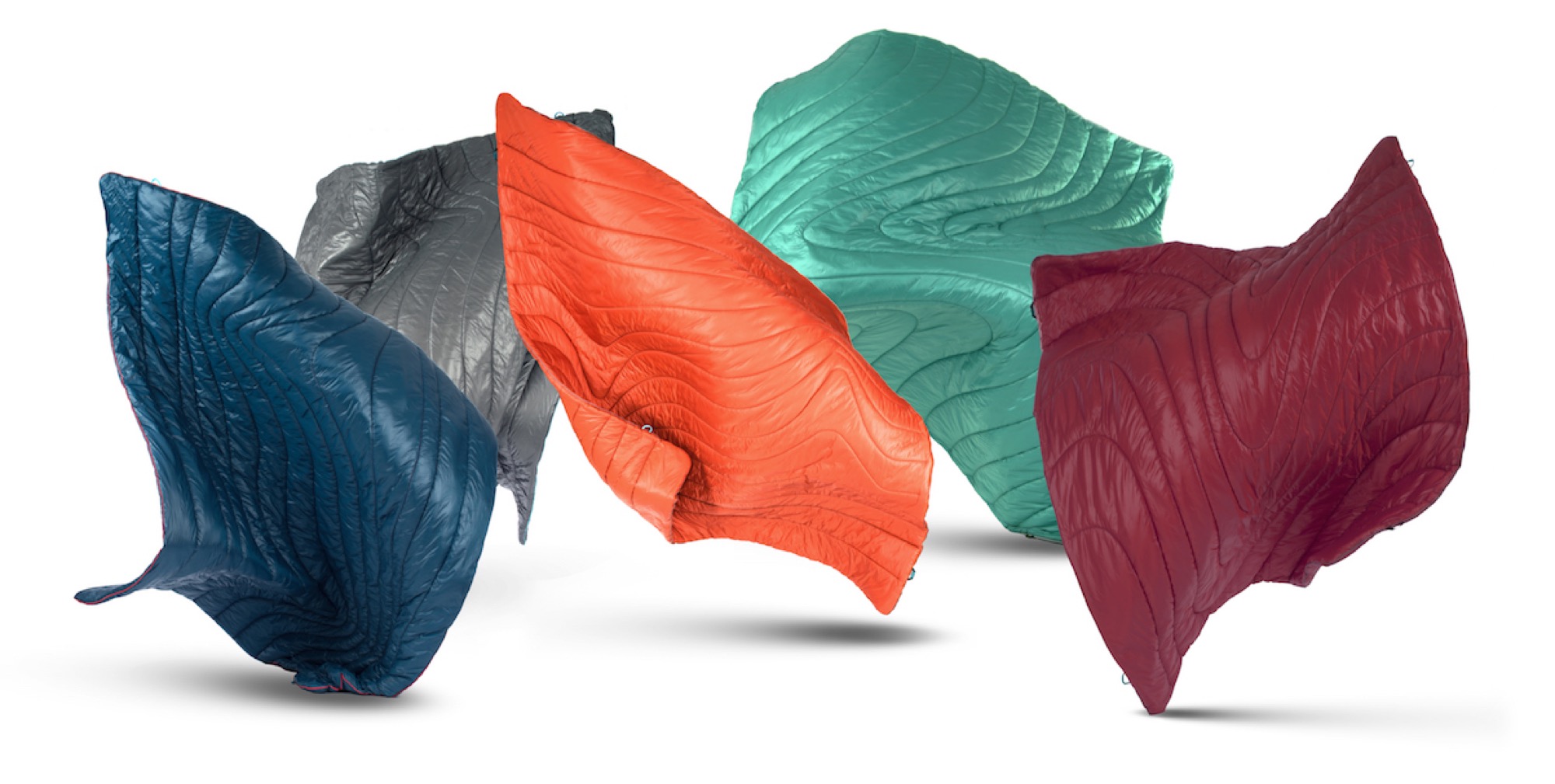
After several hours, the conversation turned to the unlikely subject of bedding. We both realized that we liked our sleeping bags more than our comforters back home. We decided that once we got out of our situation, we’d make “sleeping-bag blankets” to replace the comforters on our beds.
Once we got back to San Francisco, we met with a few friends who worked for companies like Mountain Hardwear, Patagonia, and Marmot to get more info about construction and material specs. They helped us pick materials and sew up our first blankets by hand. Still unsure if the idea was viable, we turned to Kickstarter, where we had a really successful crowdfunding campaign. That validated the idea and allowed us to quit our jobs to pursue Rumpl full-time.
“We decided that once we got out of our situation, we’d make ‘sleeping-bag blankets’ to replace the comforters on our beds.”
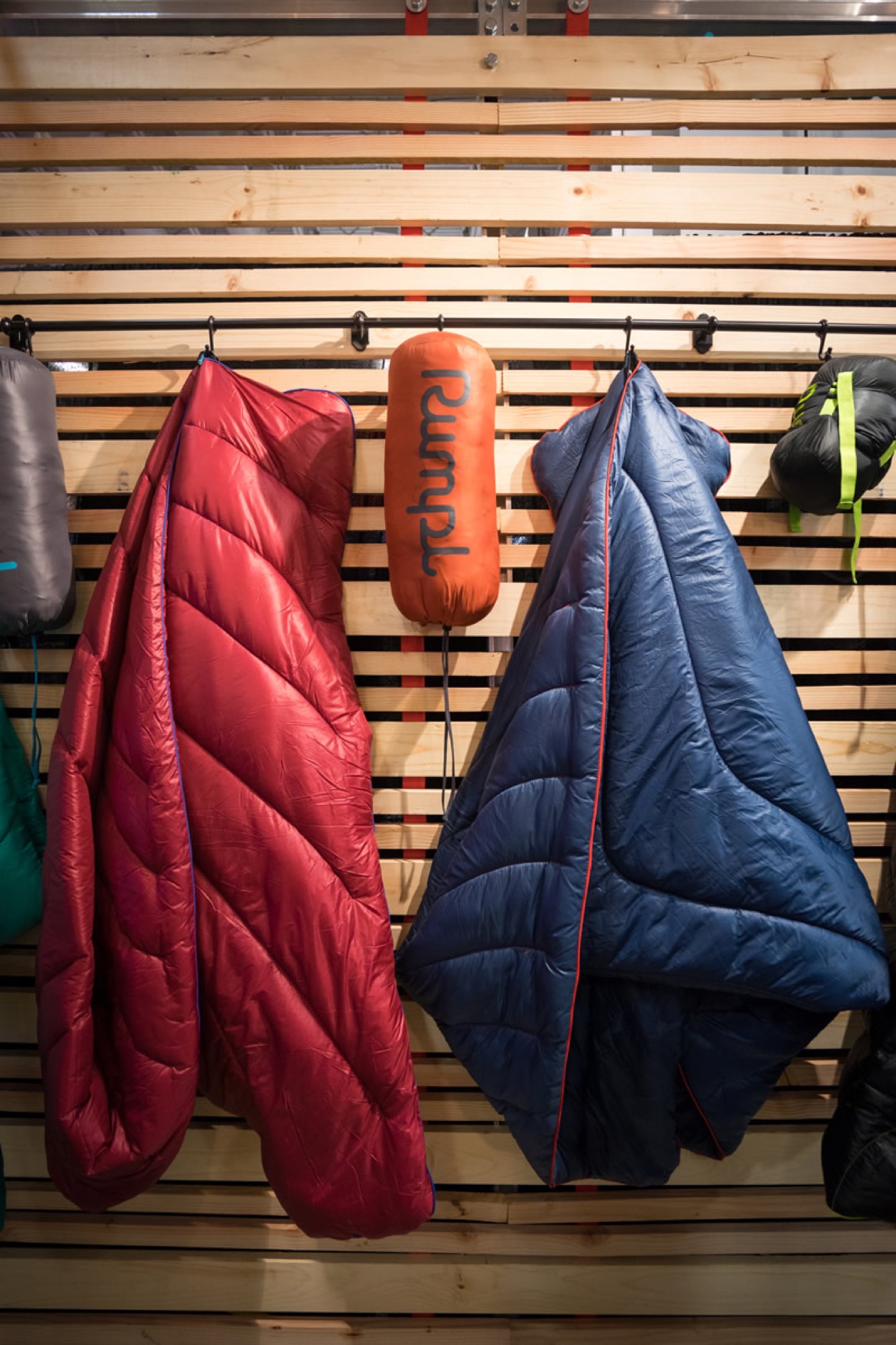
AM Why blankets, and why no other products?
WR More will come out of Rumpl that goes beyond blankets, but for now we’re just focusing on doing blankets really well and familiarizing people with our brand.
In general though, I think, consumers like and appreciate brands that focus on owning one thing. It sends a really clear message and makes every action by the brand intentional.
AM What’s the story behind the brand name?
WR It’s an onomatopoeia—“Rumpl” sounds like how the product behaves. You’d never neatly fold a Rumpl blanket, you just kinda crumple it up and stuff it in the stuff sack. We’ve also developed the word to mean a few things when spoken from our brand voice. “Rumpl” can be a noun, a verb, and an adjective… My Rumpl stays in my car, I rumpl under the stars, I keep my bed messy and rumpled.
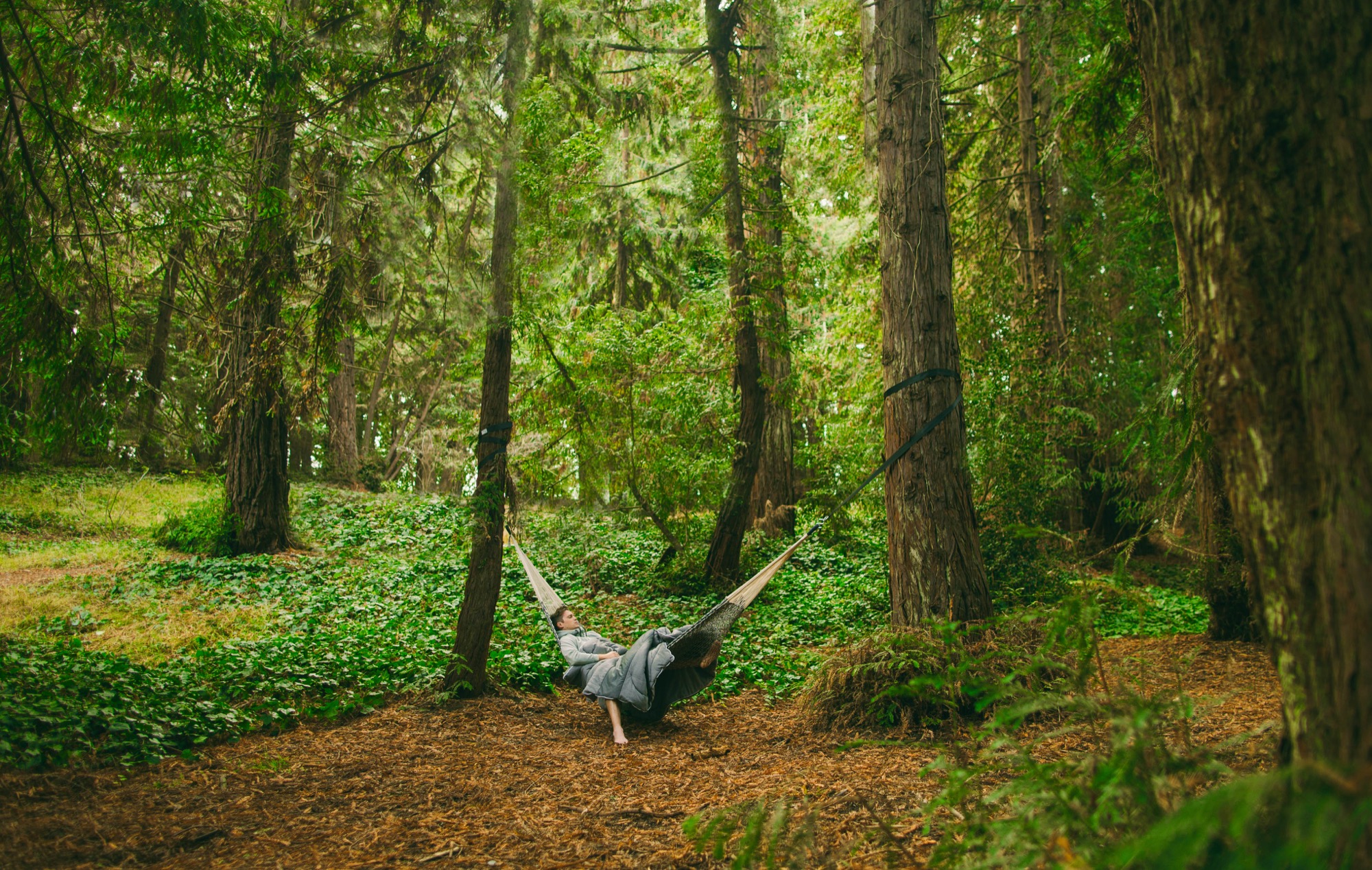
AM In what traditions are your modern products rooted?
WR The nostalgic feeling of cozy warmth that you’d find in a sleeping bag. We all know the feeling of being toasty warm in a sleeping bag, with just the tip of your nose poking out and feeling the chilly air. The tactile experience with Rumpl blankets takes you back to those moments outside, cuddled up under the stars.
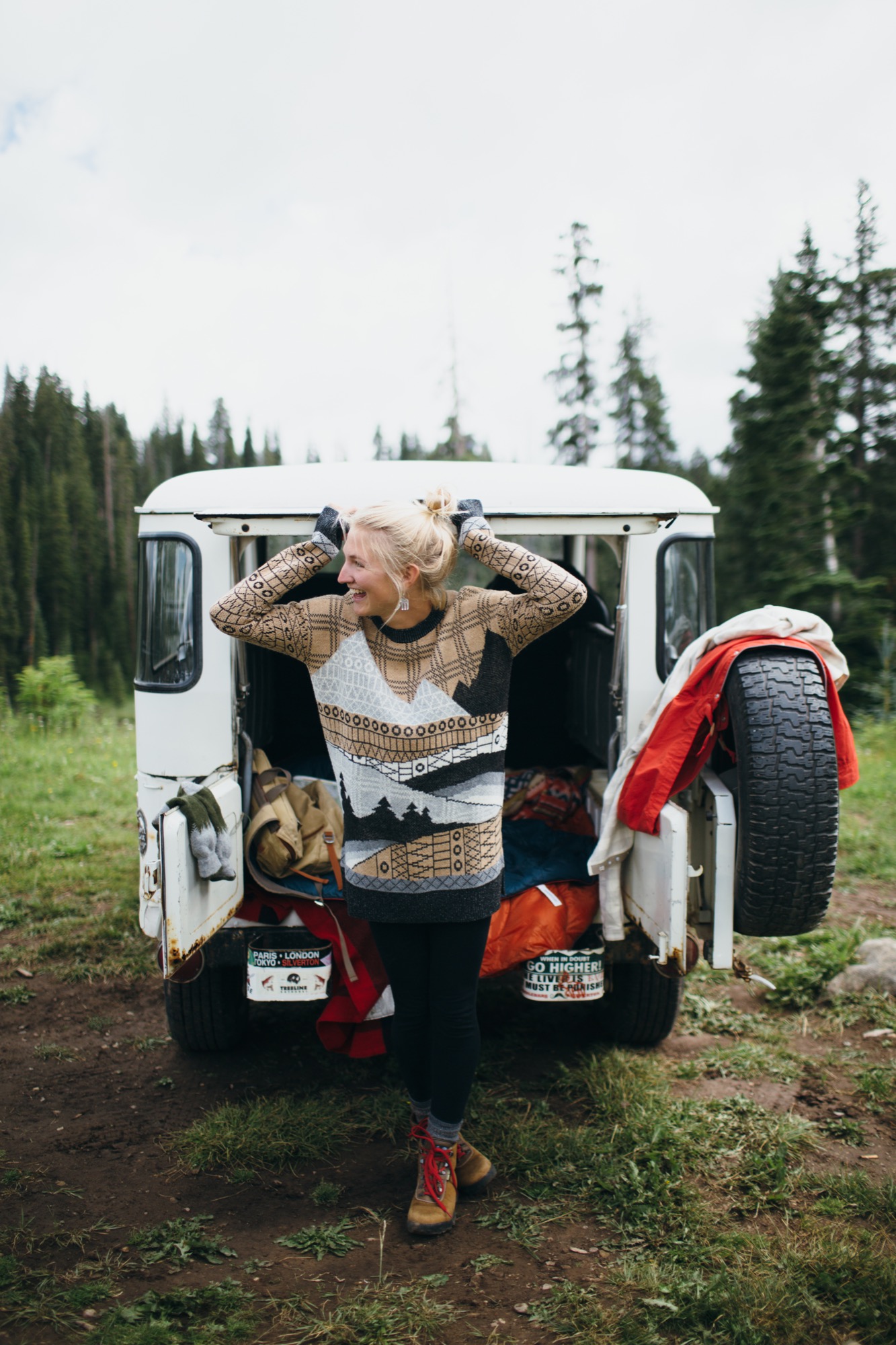
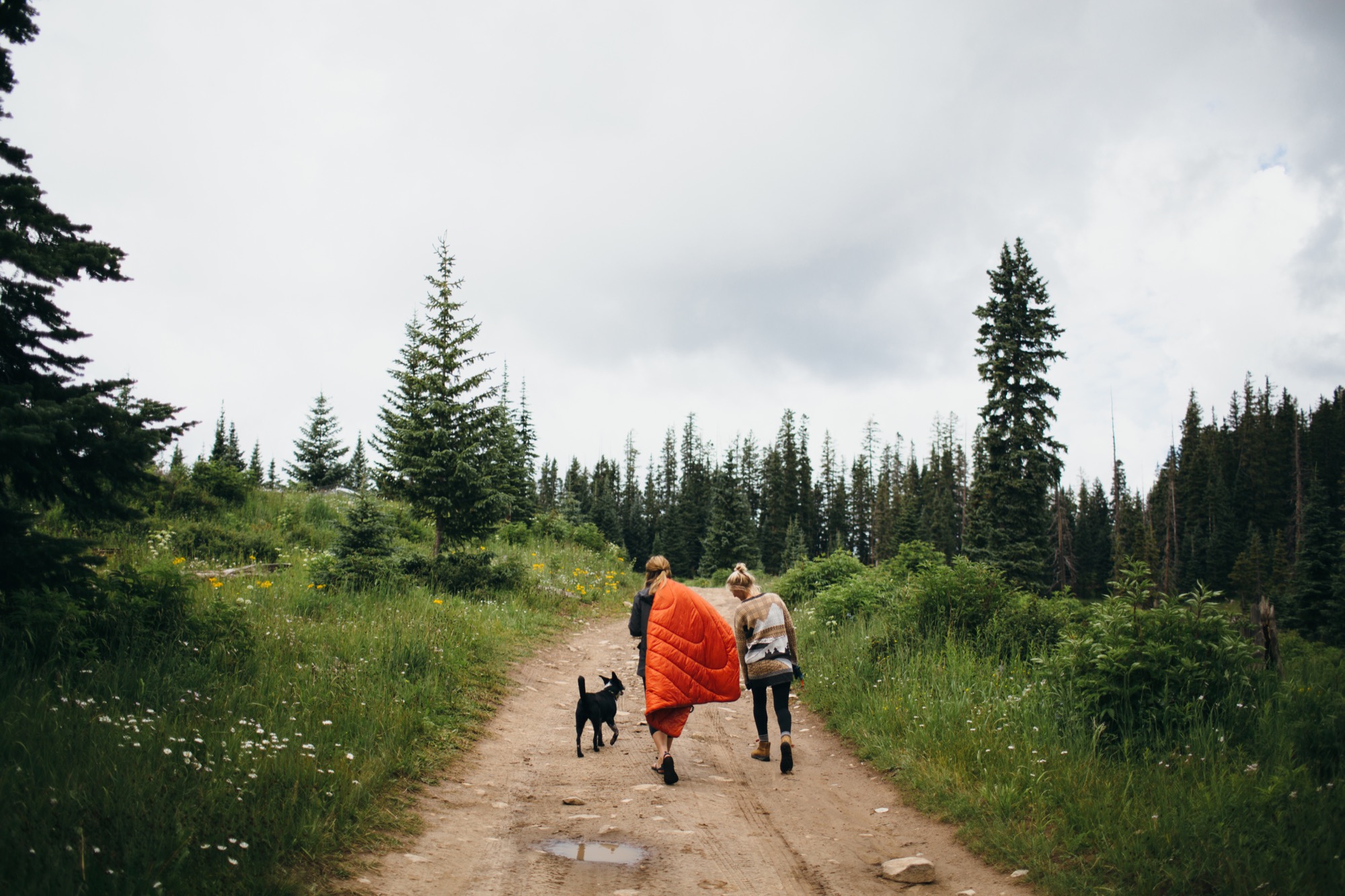
AM How do you choose and source your materials?
WR Beyond the nostalgic tactile factor, the materials work really well. We source a really nice insulation that was developed by our factory and regulates temperature perfectly, so you’re never too hot. The nylon shell is super durable and sheds water. The whole thing is machine-washable.
We have an amazing factory partner that sources materials from over 200 different mills in Asia. We’ve visited them in China a number of times and their facility is beautiful and spotless. Workers are treated very well, and everyone we spoke with was excited about working with us. We tell them what our goals are, and they find several materials that suit our needs. We narrow that down based on hand-feel and costing and move forward with the right tool for the job.
AM What makes Rumple alpine modern?
WR Rumpl is a modern take on everyday homewear as seen through the eyes of an outdoor enthusiast. We find inspiration from the gear we use to stay comfortable outside and apply the same design principles to our blankets. The whole project is a blend of equal parts alpine style, modern design, and lifestyle communication.
“The whole project is a blend of equal parts alpine style, modern design, and lifestyle communication.”
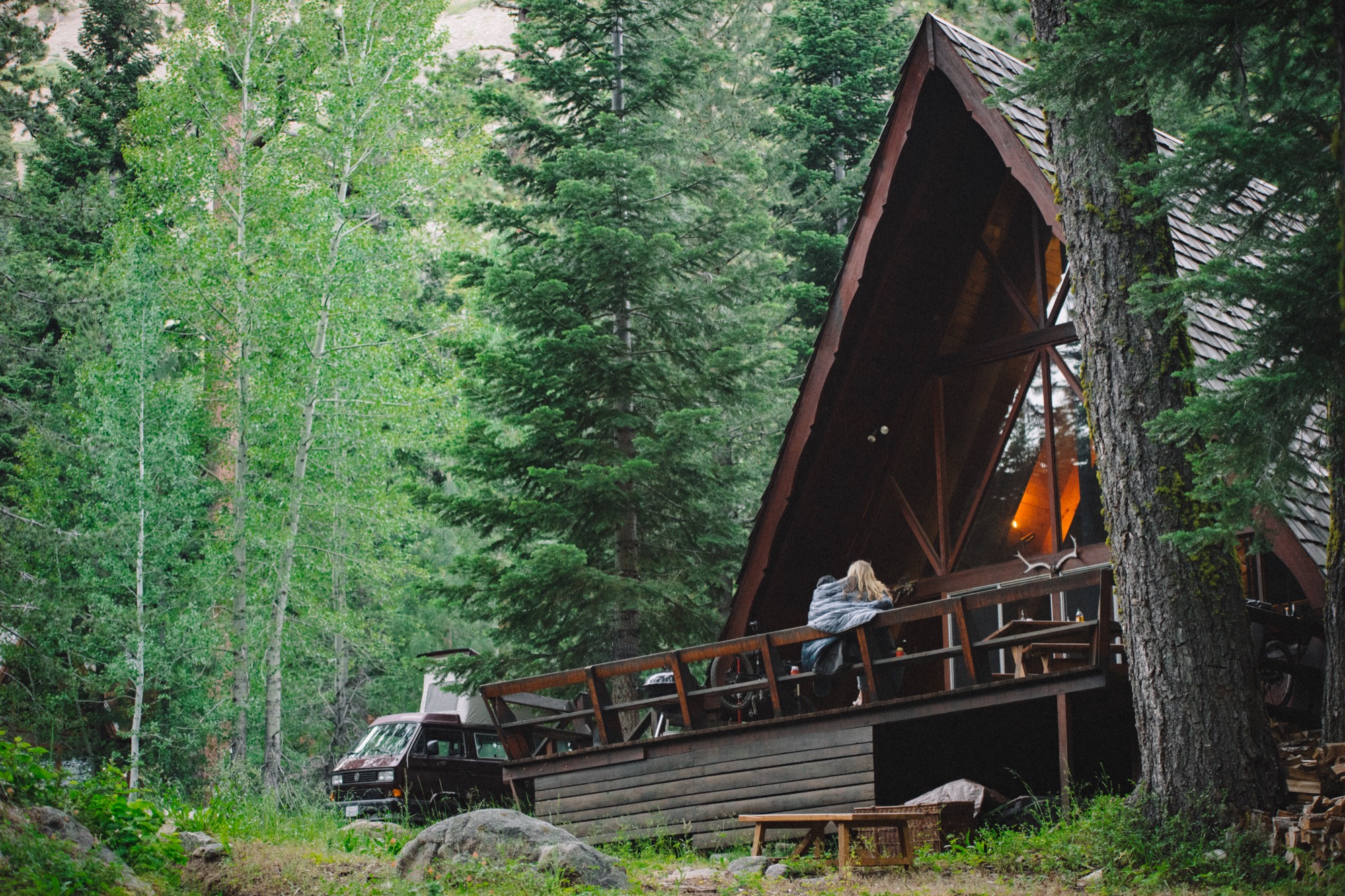
AM What makes you an outdoorsman at heart?
WR My simple love for being outside and connected to nature. I can get the feeling of interacting with nature from being just about anywhere. Whether I’m gardening in my yard in San Francisco or I’m twenty-five miles deep in the backcountry, I can still smell, taste, hear, and feel my surroundings, and that brings me joy.
AM What do you do when you’re in the mountains?
WR While I was in school at CU Boulder and working at CommArts in Boulder, I raced downhill mountain bikes pretty seriously. I raced on the school’s team and eventually raced in the pro category throughout the United States, so mountain biking is really close to my heart. I also camp, hike, ski, climb, and surf whenever possible.
AM What does quiet design mean to you?
Design that is so well done you don’t even notice it.
AM What’s your favorite place in the world, and why?
WR Whistler, British Columbia. The mountains are huge, the terrain is amazing, the town is so fun, the locals are super nice, and the overall vibe is so positive. It’s not the most exotic or distant place on Earth but the good energy is second to none.
AM What does “home” mean to you?
WR We talk about “home” all the time at Rumpl. To us, it’s a headspace, not a physical location. Home is where you’re comfortable. Whether that’s indoors sitting in a comfy chair with a cup of coffee, sticking your toes out the back of a van on the side of a desolate road overlooking an expansive valley, or deep in the backcountry rested up on a rock next to a campfire, it’s where you feel comfortable, relaxed, and safe.

AM What’s most important to you in life?
WR Trying to stay balanced between working and taking time away from my desk. It’s really tough for me because I can get pretty obsessed with what I’m working on—but I’m improving. That and surrounding myself with good people who energize me.
AM What makes you happy?
WR Lots of little things… My fiancé’s dimples, being alone on my bike in the mountains, a cold beer after a surf, a hot cup of coffee on a wintery morning. Generally speaking, very small things make me happy.
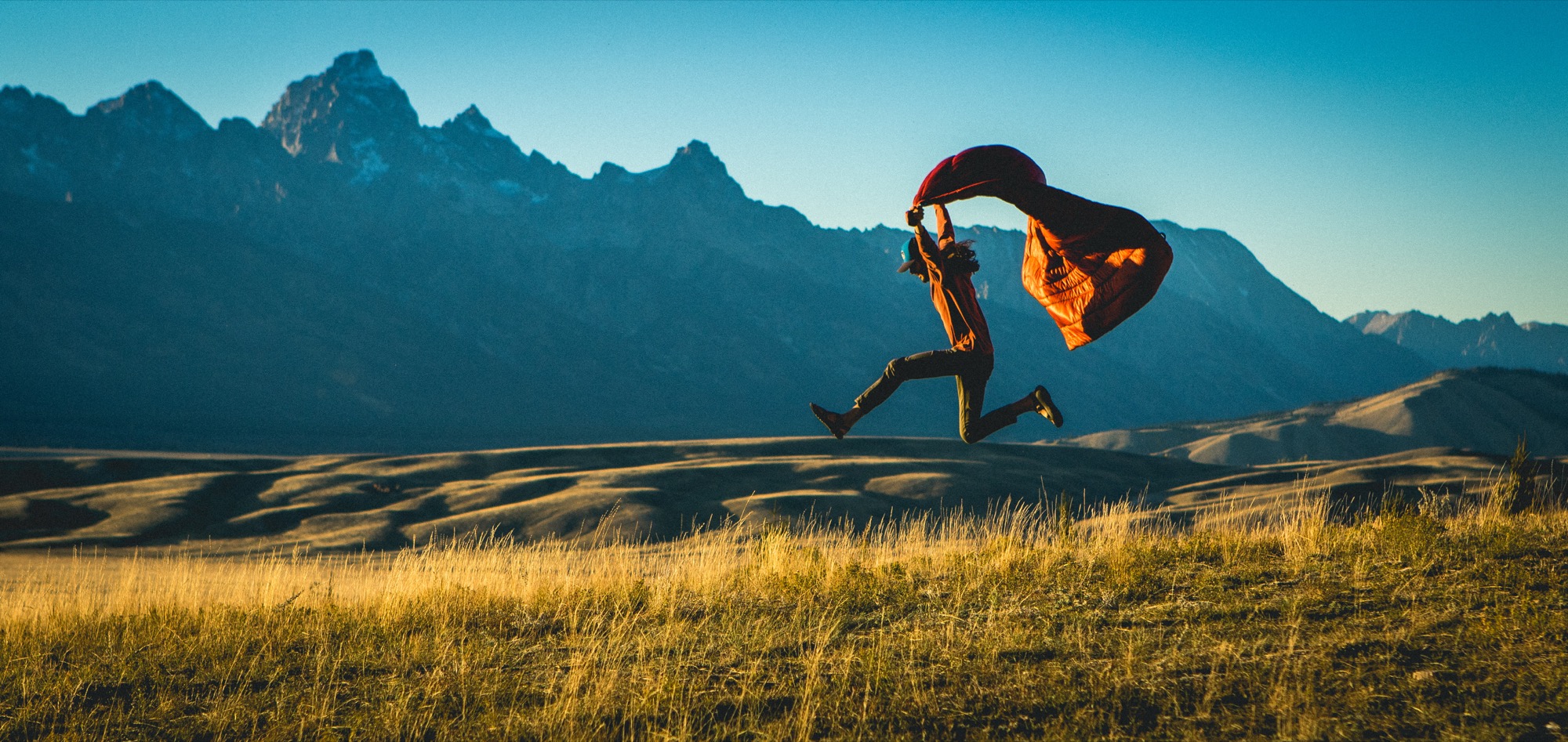
AM Who is your design icon, and what do you admire about her/him?
WR Tim Brown of IDEO is pretty inspiring to me. Before learning his interpretation of the creative process I thought it was bad to let ideas flow off-track. He made me realize that’s OK—to let your mind wander in directions that may not perfectly relate to the problem you’re trying to solve. A tangential train of thought will still teach you something that can be used to better inform the final solution. I recommend his book Change By Design to any young designer or entrepreneur.
AM What are you working on these days?
WR Rumpl keeps me busy 24/7. There’s just so much to do at a small company with limited resources. Specifically though my biggest goal for 2017 is to make the company more automated and scheduled. Right now we’re shooting from the hip in a lot of ways and I want to set clearer goals and work off a more defined calendar. That means saying no to a lot of opportunities and only focusing on the main objectives. It’s tough to say no to great opportunities but in order to grow up, every company needs to do that. △

Waking Up to Adventure
Zack Giffin, professional freeskier and cohost of the television series Tiny House Nation, builds himself a mobile 112-square-foot (10-square-meter) ski-in, ski-out chalet so winsome it wipes out the ski bum stigma.
Zack Giffin, professional freeskier and cohost of the television series Tiny House Nation, builds himself a mobile 112-square-foot (10-square-meter) ski-in, ski-out chalet so winsome it wipes out the ski bum stigma.
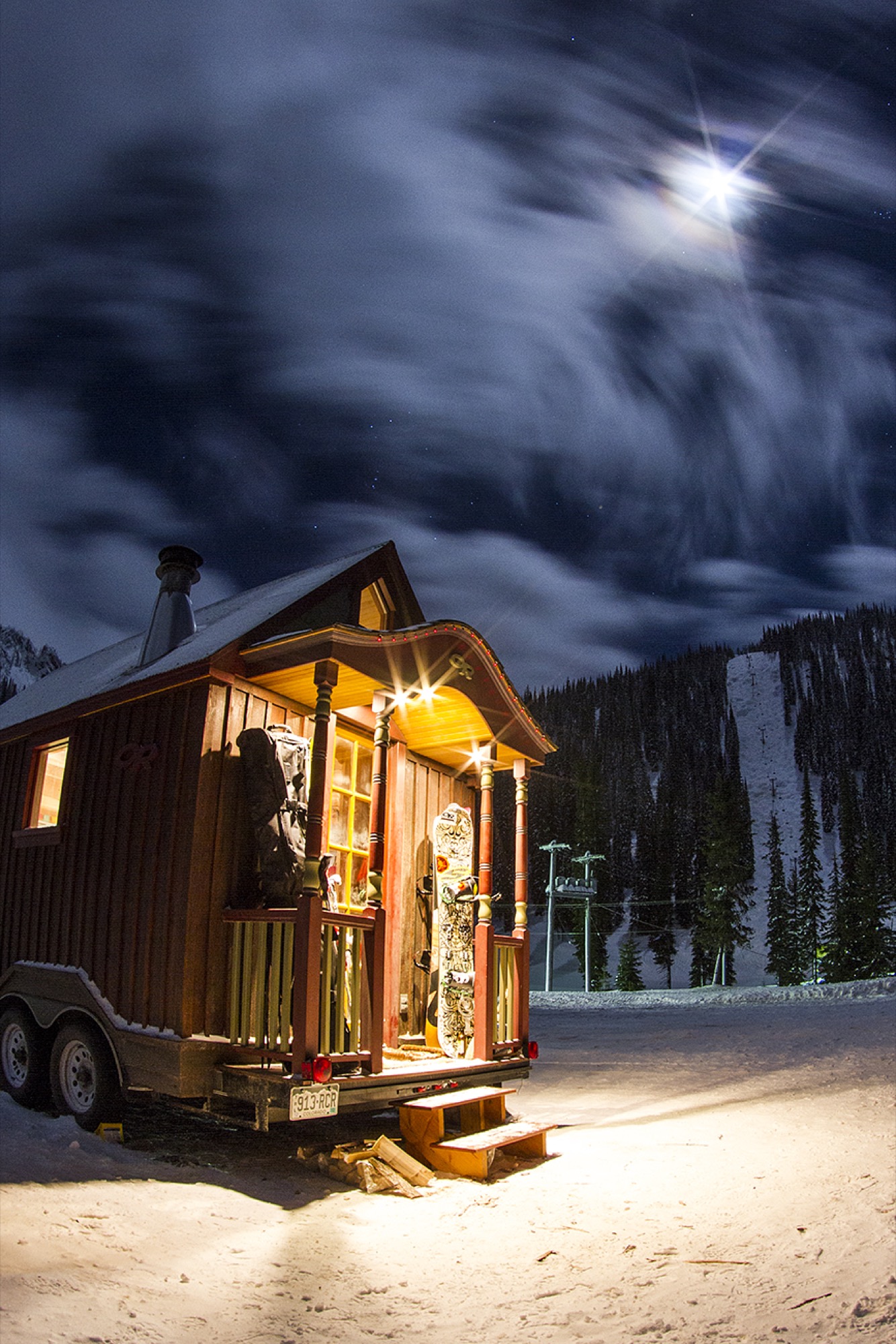
“My love for the mountains comes from my family. My whole identity was to be that mountain kid,” Zack Giffin says about growing up in Gold Hill, Colorado. His parents had moved to the tiny mountain community ten miles above Boulder to raise their three sons (Zack is the middle child) to revere the outdoors as much as they did. His mother, a university professor, was an avid backpacker. His father, a ceramics artist and prolific inventor, was a fisherman and a rock climber.
The parents’ plan worked. Giffin blossomed into a professional skier, hungry for adventure and romantic evenings in the mountains.
Young Giffin embraced another passion of his father’s: working with wood. Like Giffin Senior, Zack is not a carpenter by trade. Nevertheless, “My dad instilled in me that you can make things yourself, and that you are the only one you can really rely on.”
That paternal sagacity resonates with Giffin whether he builds tiny houses or is about to drop down the face of a glacier. “The development in both those areas is in learning how to believe in yourself, to trust you’re making the right call.” He’s had mentors on the snow and in the shop, but he, like everyone, came to a point when there was no one to reference. “When you are on your own, that’s when a lot of growing up happens.”
“My dad instilled in me that you can make things yourself, and that you are the only one you can really rely on.”

Alone
The tragedy that changed Giffin’s life in an instant happened neither on the big mountain nor on television. It happened in the home he shared with a roommate in Boulder. It forever altered what home meant to him. “I had a gnarly incident with a friend,” Giffin reveals, his voice suddenly somber. The young man who had been like a little brother to Giffin, accidentally shot himself to death. “It was pretty dramatic. I was in the house, and all of a sudden I no longer felt the security of home in that space.”
He no longer wanted to live there. “It was this catalyst in my life for making a change. There was sadness, and I really wanted to pursue my dream of being a skier.” All at once grasping life’s preciousness, Giffin bought an RV and persuaded his little brother to move to Mount Baker, Washington—a place he was “absolutely in love with” at the time. “That was a big shift, and I experienced a lot of stigmatism.” He’s talking about being perceived as “the guy who lives in an RV.” No soul asked him about his motivation to uproot and chase his dream. The following winter, Giffin pushed himself yet nearer the fringe of venal bourgeoisie. He moved into a van that he outfitted with a wood stove.
Boyfriend material
Then, he fell in love with fellow snow gypsy Molly Baker, who is also a professional skier. “She was so cool and totally would have done it, but I had experienced that stigma and couldn’t bring her into that world with a good conscience,” he admits. “No girl wants to go back to her parents and explain that her new boyfriend actually lives in a van.”
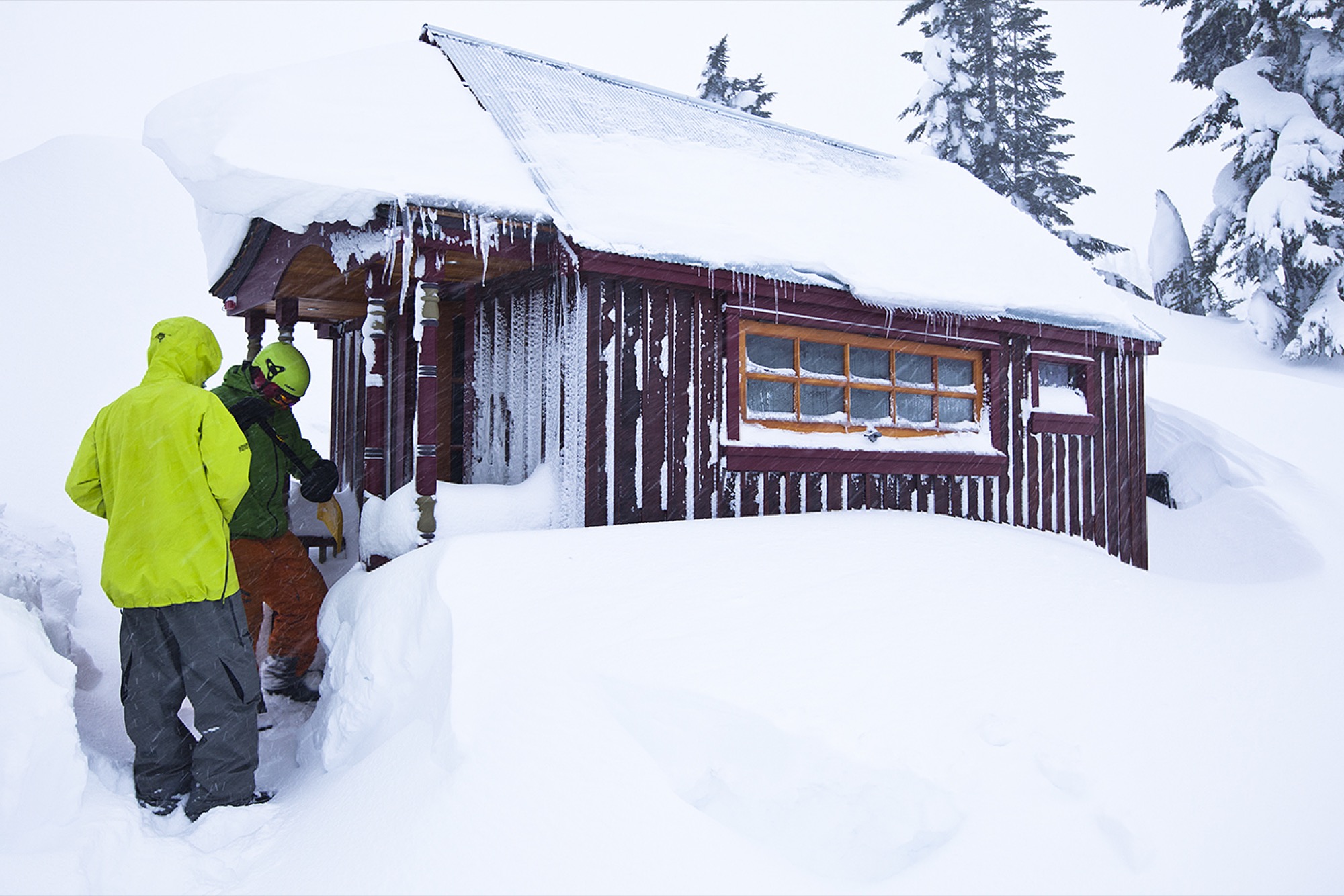
So he built a 112-square-foot (10-square-meter) tiny house on wheels for Baker and himself. It became more than a vehicle to keep living expenses low. Giffin once again owned a place he wanted to come home to and could take pride in. “It’s human nature. It’s a disorienting feeling to be out there, floating around, and not have this idea of where home is,” he says. “With a tiny house, you can provide that for yourself with a lot less money and without this ridiculous classist stigma.”
Looking back on how differently people reacted to his RV or van compared with the tiny house, Giffin is astounded. “I would park my RV at a friend’s, and the neighbor would come over within a day, asking me how long it’s going to be there,” he remembers. “Now, the neighbors still come over. But now they want a tour. They want to meet the person who’s built such a cool thing.”
“No girl wants to go back to her parents and explain that her new boyfriend actually lives in a van.”
Returning time, restoring pride
Keen on helping others feel that sense of pride, Giffin, in his mid-thirties, now builds tiny houses all across the country on his television show Tiny House Nation. The movement hits a nerve with the nation. Along with irrepressible concerns about the environment and the economy, Giffin senses a growing disdain for global materialism, amplified in increasing average home sizes. Living minimally speaks to all those fears. “I see that pendulum swinging back in the tiny house movement.”
He passionately wants to help people get out of the trap of imbalanced wages versus home prices. “So many people in my generation are going through school and have all these dreams and passions, and then economic reality forces them into jobs that have nothing to do with what they studied,” he says. “As time goes on, that turns into their reality, and hopes get left behind.”
Leaving behind material things and abundant living space instead of dreams, on the other hand, has one tremendous reward: returned time. “I love to watch people make that transition, because it’s not just about the physical detachment from the things that were controlling your life, it’s also this big decision that takes a lot of courage. And you can be so proud of yourself for making it through to the other side.”
Free-skier
Freedom from being forced to work longer hours to afford a bigger house is one important appeal of tiny-house living. The other one is mobility. When Giffin is not filming, he pulls his ski chalet on wheels right up to the mountain. “The desire to wake up where your next adventure is, this immediacy, is a universal understanding within the ski culture,” he says. “With skiing, half of the process is the commute. Only unbelievably rich people get to stay right at the mountain.”
Or, you’re living in the parking lot.
“The desire to wake up where your next adventure is, this immediacy, is a universal understanding within the ski culture.”
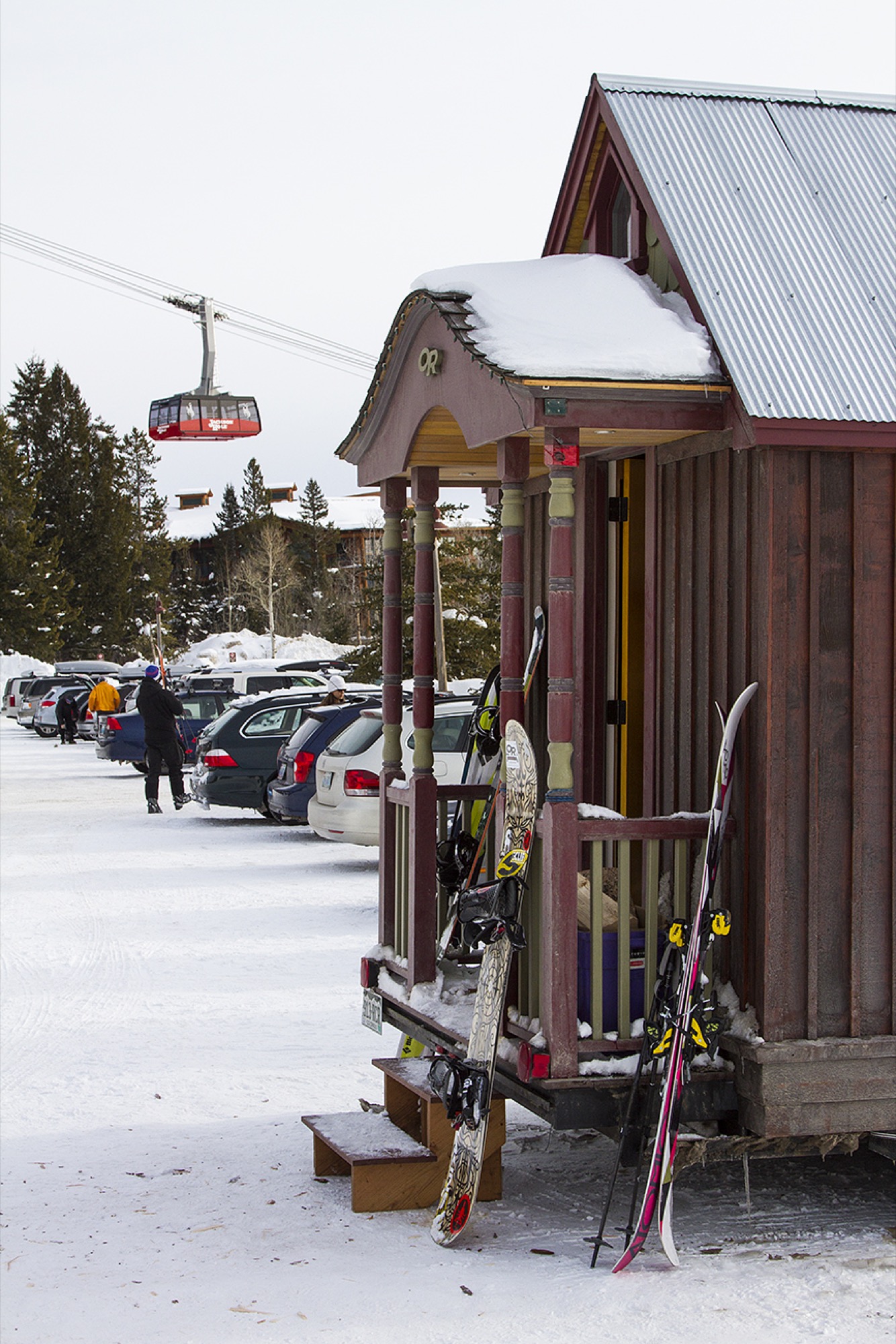
Giffin values being on the mountain before anyone else, and, at the end of the day, not being stuck in traffic, sitting in the car in his wet gear. Instead, he skis right up to the place he calls home. “One of the most beautiful things about tiny-house living are these incredibly romantic situations. You’re collecting all these little tidbits of extra time. It’s the end of a beautiful ski day, and it’s such a satisfying feeling to be in a place you love, that feels like home, and that’s in the mountains. But you have to fill that time or you are going to experience this crazy thing called boredom. And that’s just beautiful. It turns into my time for reading books, stretching, playing guitar, and having intense conversations with Molly . . . or a dance party. All these things lead into a quality of life worth living for.” △
“One of the most beautiful things about tiny-house living are these incredibly romantic situations. You’re collecting all these little tidbits of extra time.”
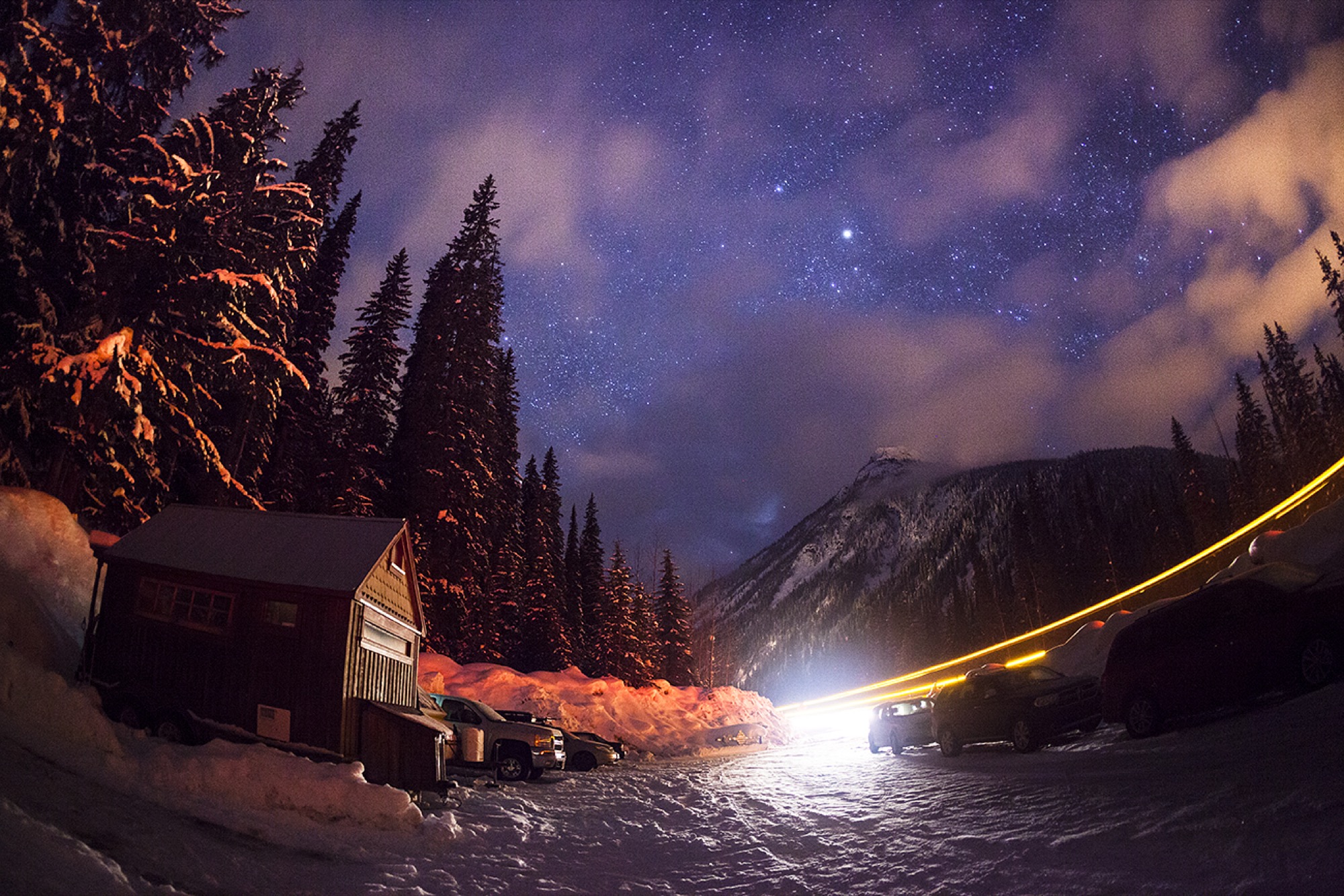
This story was originally published in winter 2014/15, in our printed Alpine Modern quarterly.
Alps // 40
An unfiltered, low-speed journey across Swiss peaks in words and images by Boulder photographer Jamie Kripke
Slowing down gives us more time to look. Having more time to look changes how we see. I wanted to slow down.
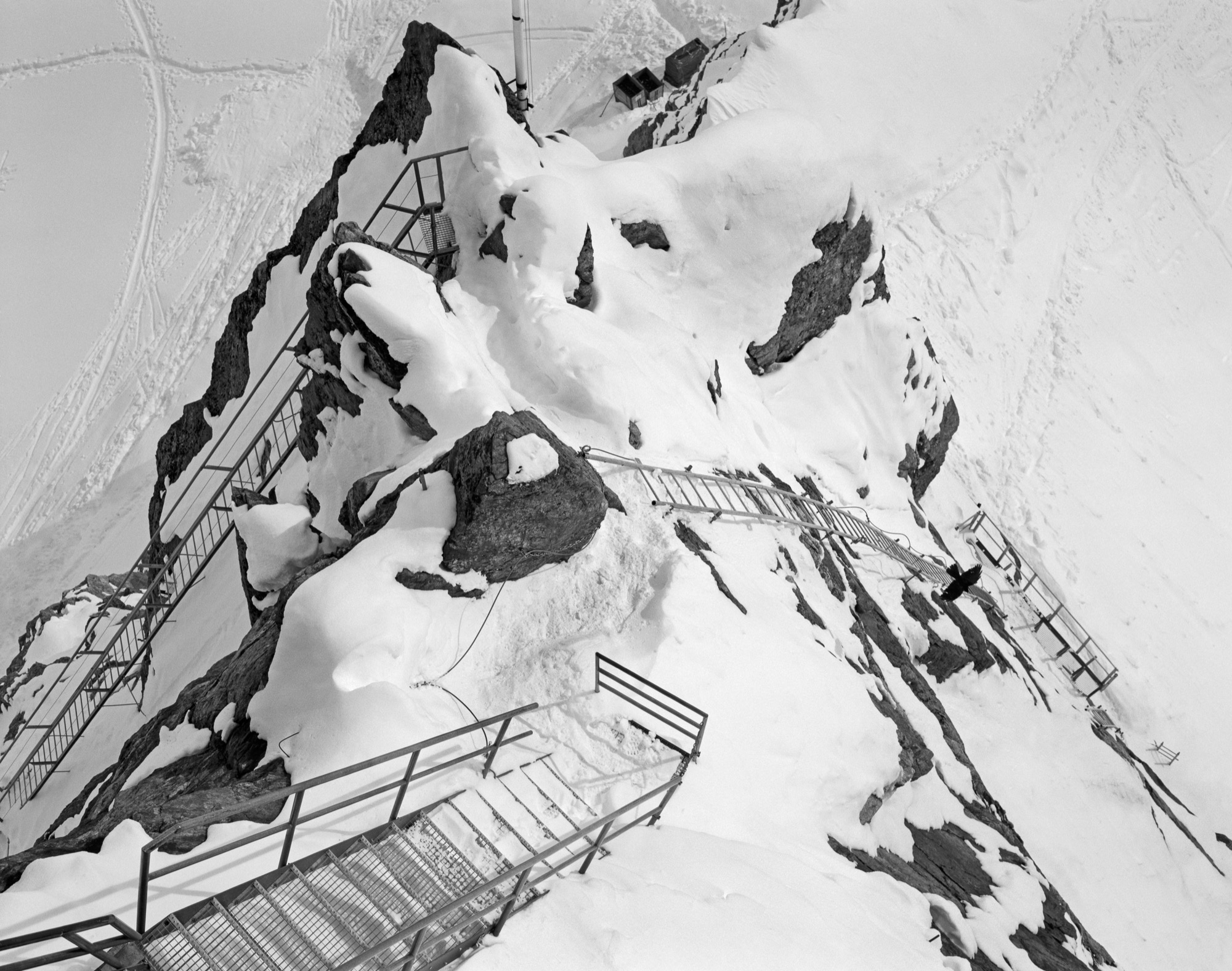
Using alpine touring skis, a small backpack, a folding medium-format camera, and twelve rolls of black-and-white film with ten exposures per roll, I set out to traverse and photograph a high route across the Alps. Each piece of equipment for this trip was chosen for its simplicity as well as its limitations—and for the extra time, attention, and patience it requires.
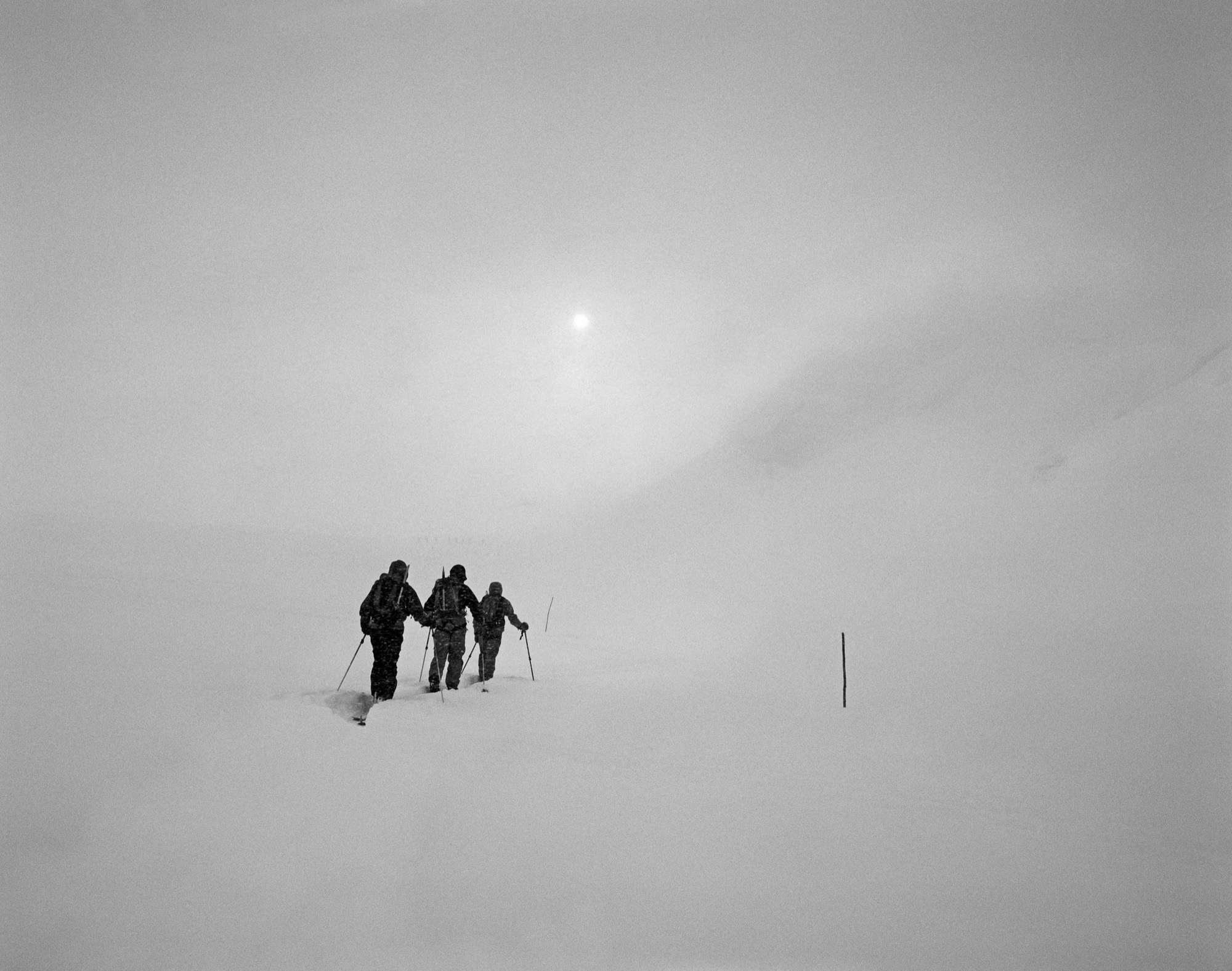
Traveling up and over mountains by skis has a way of shifting time away from something that is measured in minutes, hours, and days. Ascending one step at a time through untracked snow, the units become ski lengths, pole plants, breaths, sips of water, bites of food, daydreams, changes in weather or light.

The physical limitations of low-speed film in a mechanical camera call for a heightened attention to composition, exposure, and technique. Every frame becomes its own unique experience—one that builds gradually with each precise movement of the camera, each small adjustment for focus, aperture, or shutter speed.
"Every frame becomes its own unique experience."
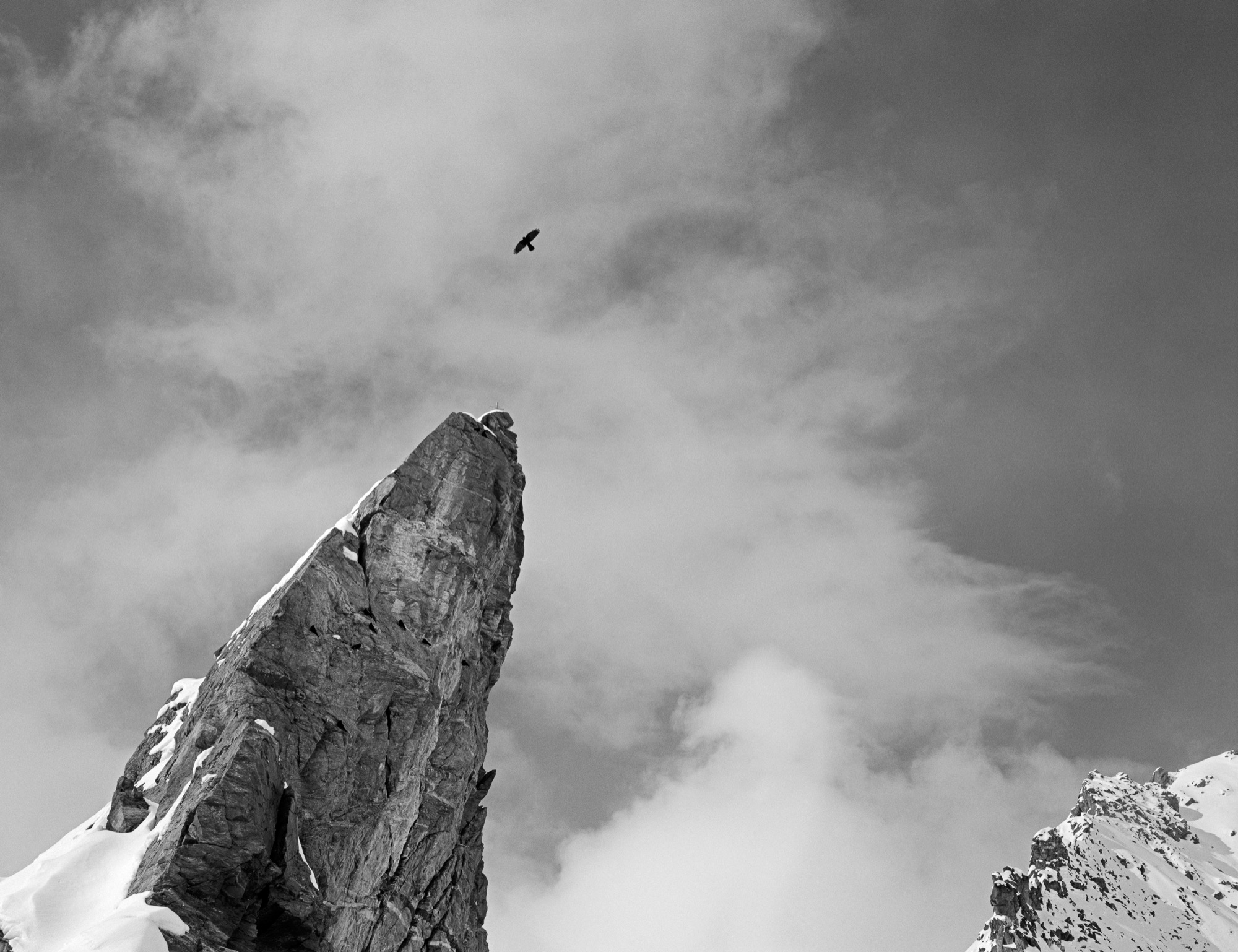
Once I’ve settled on an image, I take a deep breath and try to be as still as possible. High in the Swiss Alps, in the space between the breath and the click of the shutter, time slows to a stop.
"High in the Swiss Alps, in the space between the breath and the click of the shutter, time slows to a stop."
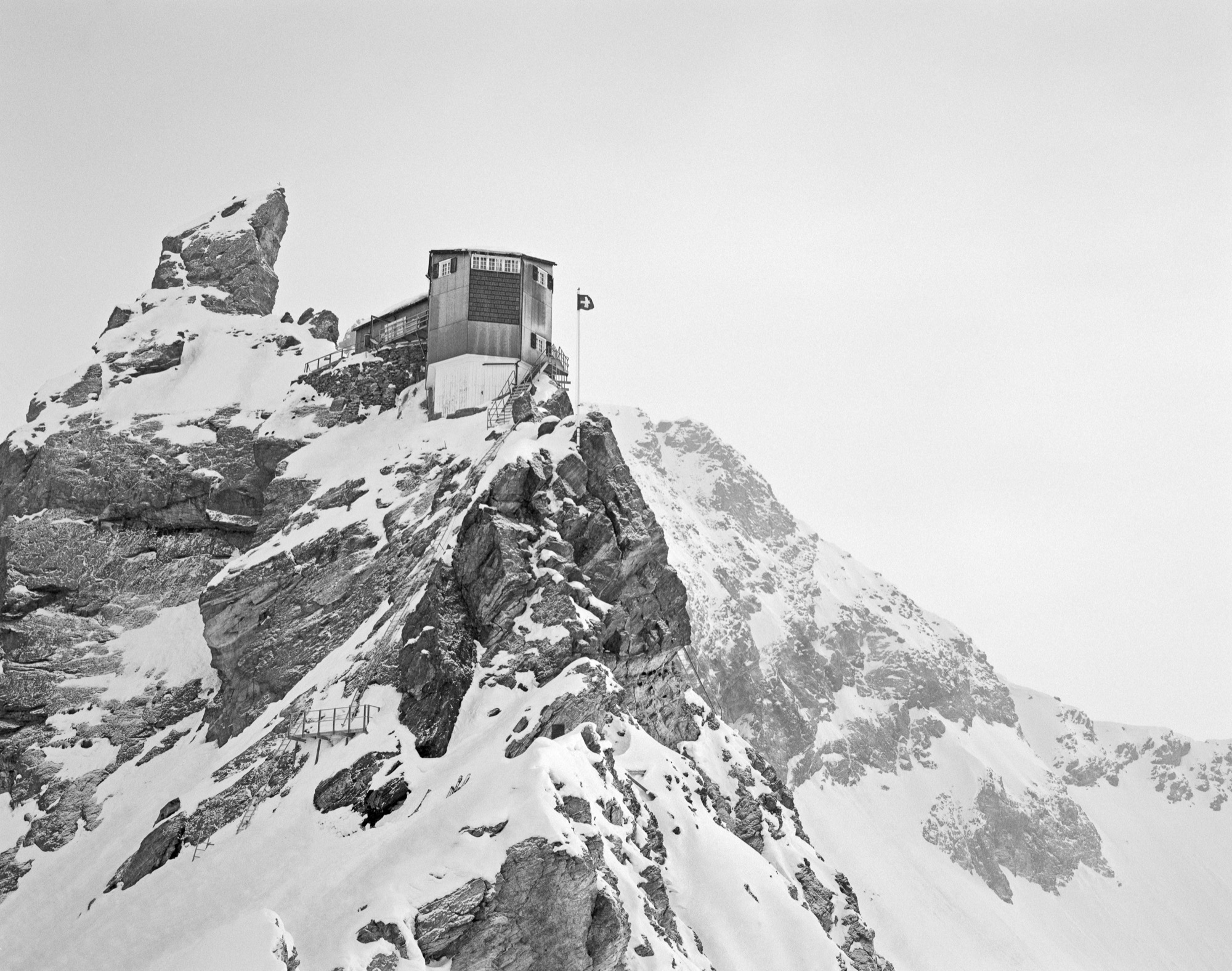
These images were made over the course of eight days, and selected from a total of 120 images, where just one exposure was allowed for each image. They have been minimally altered from their original form in order to stay true to the tonality of the film, and are the pure, unfiltered, timeless compositions that I’d been looking for. △
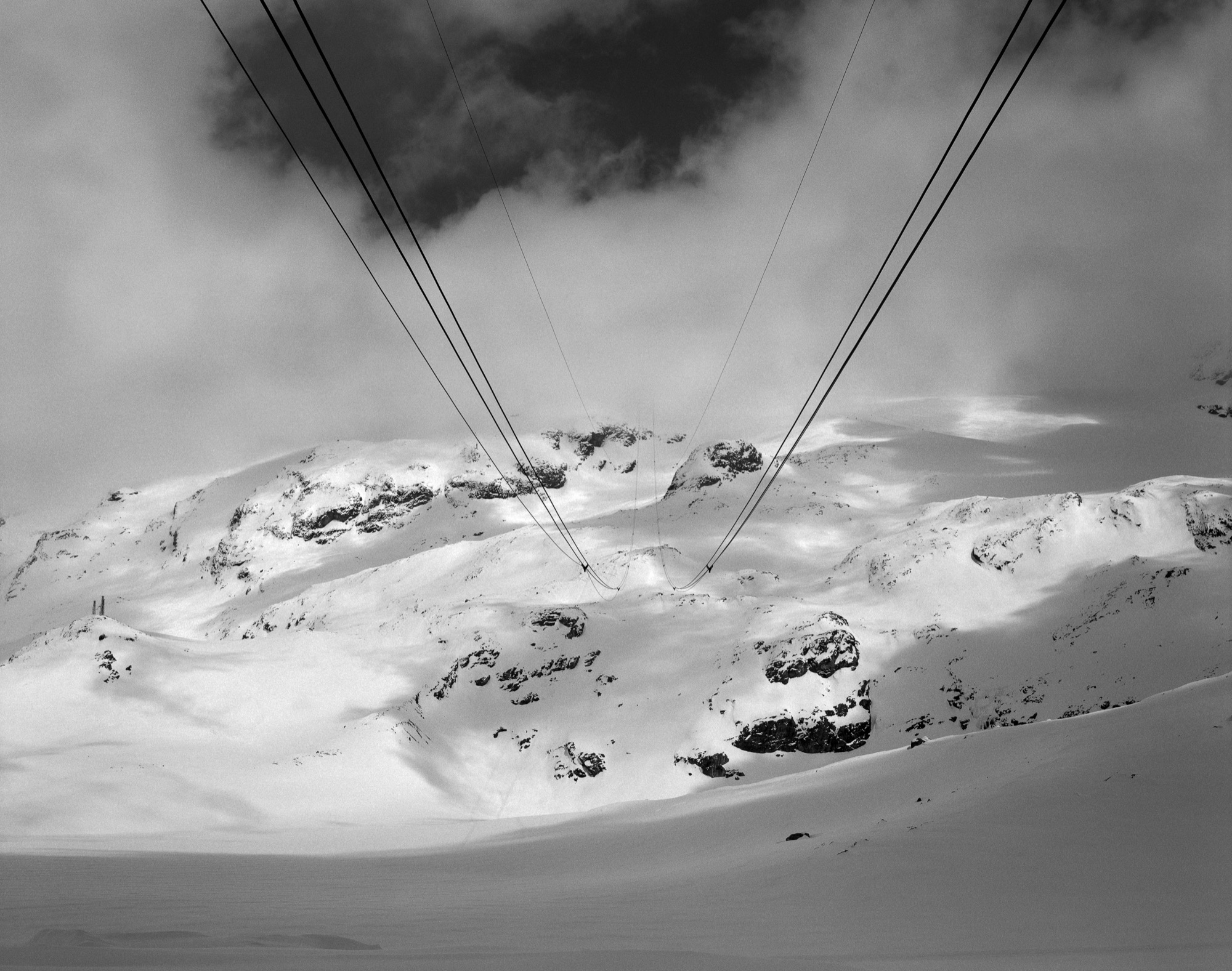
Fifteen and Focused on the World
Only fifteen years old, Joe Goldberg travels to explore the world through his camera lens. The photographer hopes his photos will inspire others to get out and see for themselves.
Upon returning from a life-changing trip to Costa Rica when he was only eleven years old, Joe Goldberg (joe_goldberg on Instagram) decided to spend his bar mitzvah money on his first camera. Now fifteen, the high schooler, who lives with his parents in Washington, D.C., expresses his teenage self through the art of photography.
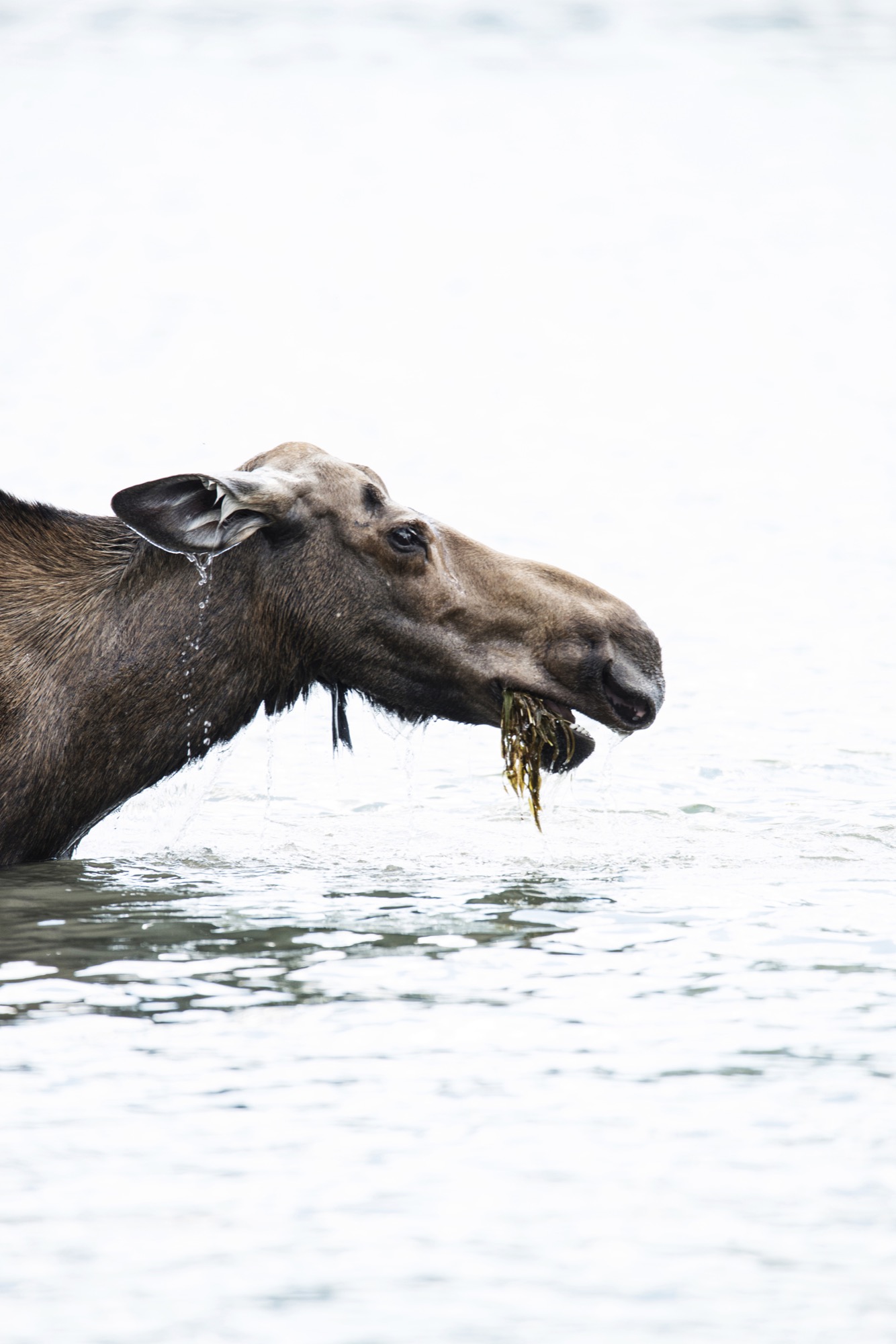
What’s more, the young adventurer wants to inspire others to travel and explore the world, too. At an age when his peers may search for their raison d'être on the Internet, this millennial gets out and uses photography to bring life into perspective.
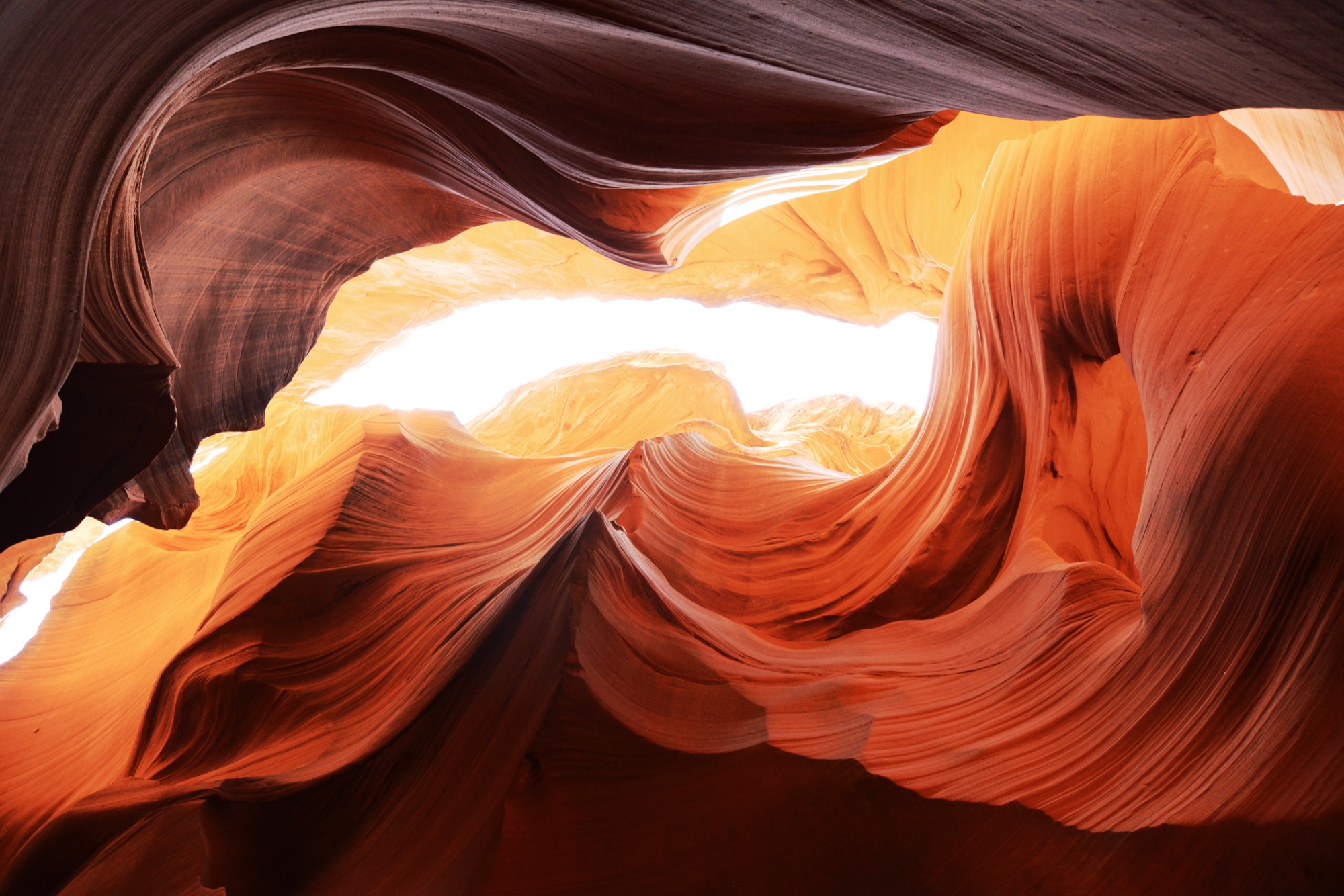
A conversation with teen photographer Joe Goldberg

AM Who are you in a nutshell?
JG I am a fun and energetic fifteen year old who loves to travel to the wildest places, take photos, and explore.
AM How did you find your way to photography?
JG I was eleven years old when I went to Costa Rica and really discovered some of the most natural beauty in the world. I then realized capturing memories with photography is a really cool thing. I realized how passionate I am about photography, so I decided to purchase a camera with the money I received after my bar mitzvah.
"I then realized capturing memories with photography is a really cool thing."
AM What does being fifteen mean for your creative work?
JG I think the role my young age plays in my creative work is having this constant urge as a young kid to travel and see things most people won’t be able to see in a lifetime.
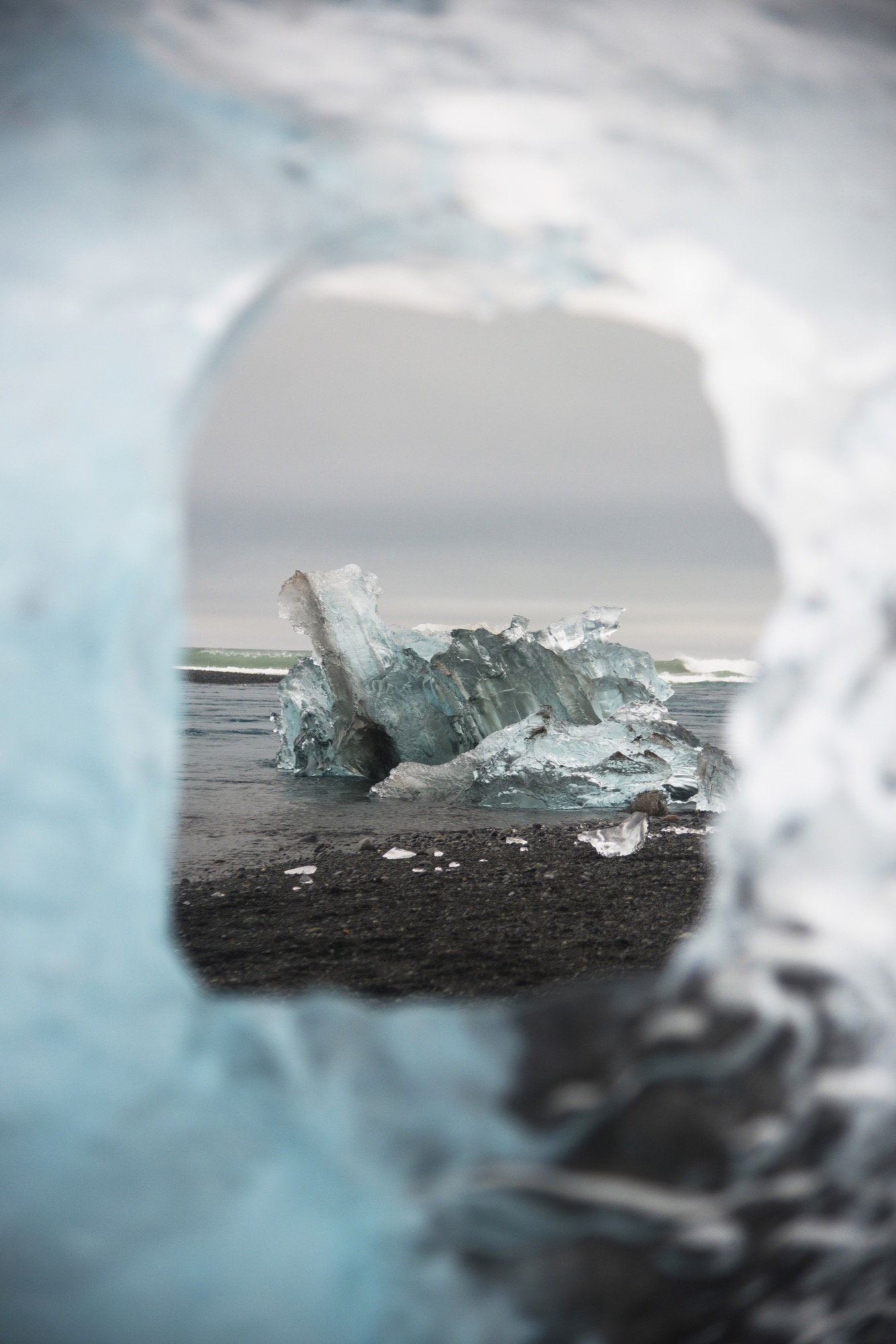
AM How do you balance school, teenage life, and your work as a pro photographer?
JG I attempt to get the best grades I can, so I can afford to miss a couple days of school here and there when I travel. I hang out with friends and family when I can. And when I get the chance to go out on an adventure, I will take the opportunity and then return to my normal, everyday life in Washington D.C.
AM What do the mountains mean to you?
JG The mountains play a big role in my photography. Probably, because I believe mountains make for the coolest photographs. My favorite activity also has to do with mountains, which is hiking. To see those insane views after a strenuous hike is one of the best feelings!
"I believe mountains make for the coolest photographs."

AM What inspires you in your work as photographer?
JG What inspires me is being able to share the beauty of the world with everyone. I love to capture memories and to look back on these incredible experiences I have been lucky enough to have. I love to hear how impressed people are with my work, which is a really big motivation to bring back the best work I can from these adventures I take. I also use my photos to try to encourage people to go out and explore.
AM What’s your favorite place in the world?
JG My favorite places I have been to have to be Iceland and Alberta. Alberta because the number of lakes and the abundant wildlife just blow my mind. You never know what to expect in the Canadian Rockies, and that is why I decided to go back over the summer after having gone during Spring Break. My other favorite place has to be Iceland. Every five minutes, you see a totally different landscape. I would love to return soon.

AM What’s most important to you in life?
JG The most important things in my life are my family and friends. However, being able to see the beauty in this world and pursue my dreams of being a the best professional photographer I can be is also something very important to me.
AM When are you the happiest?
JG I am the happiest when I am in nature, experiencing the amazing sights the world has to offer.
AM What are you up to next?
JG I just finished traveling to Iceland in October. Iceland is a place I wanted to go to for years now. The waterfalls, wildlife, volcanoes, glaciers, geysirs, unique landscapes, and the incredible Northern Lights are the reasons why it was on the top of my bucket list. △
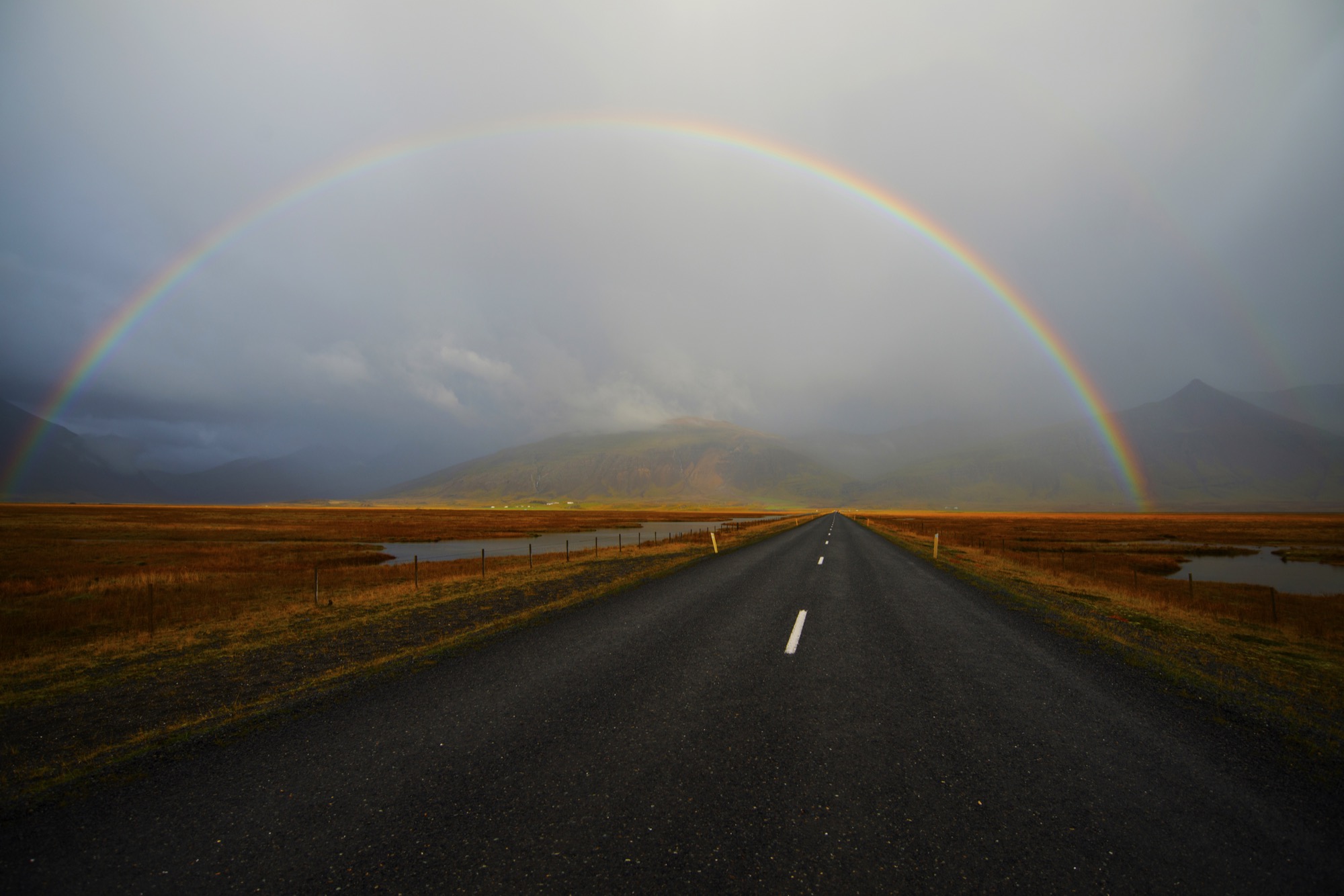
The Building Friendship
Friends since preschool and sharing a love for design and the mountains, the founders of MTN Lab, an experimental furniture and art studio in Colorado, have always been building things together
Harris Hine and Rudy Unrau have been best friends since preschool. Now both 27 years old, they have founded MTN Lab, an experimental furniture and art studio in Colorado. Growing up in Boulder, Colorado, the lifelong friends have been building things together since they can remember—skis, bikes, random projects. But it wasn’t until spring 2015 that the idea for MTN Lab was born. Both back in Boulder, Hine and Unrau began showing sculptures at Studio Como in Denver’s RiNo art district at the time. “Getting in there is what really materialized the company,” Unrau recalls. “That’s when we came up with our name and went from just building stuff to actually focusing on a business.”
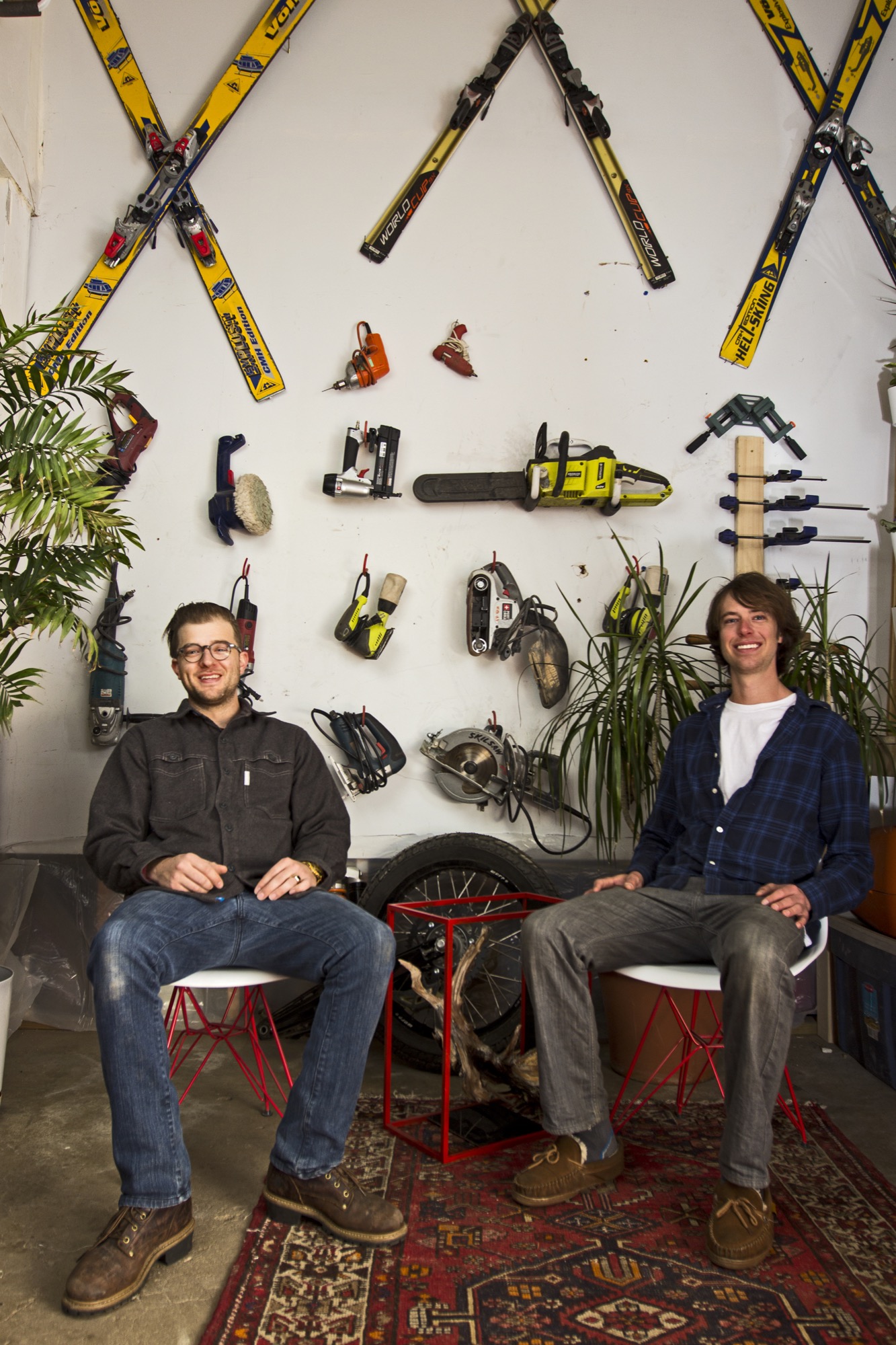
The two men, both quiet and reflective, share an ardent love for design and the mountains. Yet, they come together at MTN Lab—at the intersection of art and adventure—from opposite directions: Hine a trained designer and woodworker, Unrau a former professional mountain biker turned woodsman fighting wildfires for the Forest Service.
Harris Hine
Harris Hine grew up profoundly influenced by his father, Vienna-born modernist architect Harvey Hine, who founded HMH Architecture + Interiors in Boulder.
“I’ve always been torn between the design side of my personality and just wanting to be in the woods,” Hine shares. He went to school for design at Pratt Institute in Brooklyn before moving from New York City to Portland, Oregon, where he worked as industrial designer. “I didn’t find any fulfillment doing other people’s projects, and I didn’t really like the mass production side of product design,” he admits.
All those years, Hine pined for the woods, where his old friend was.
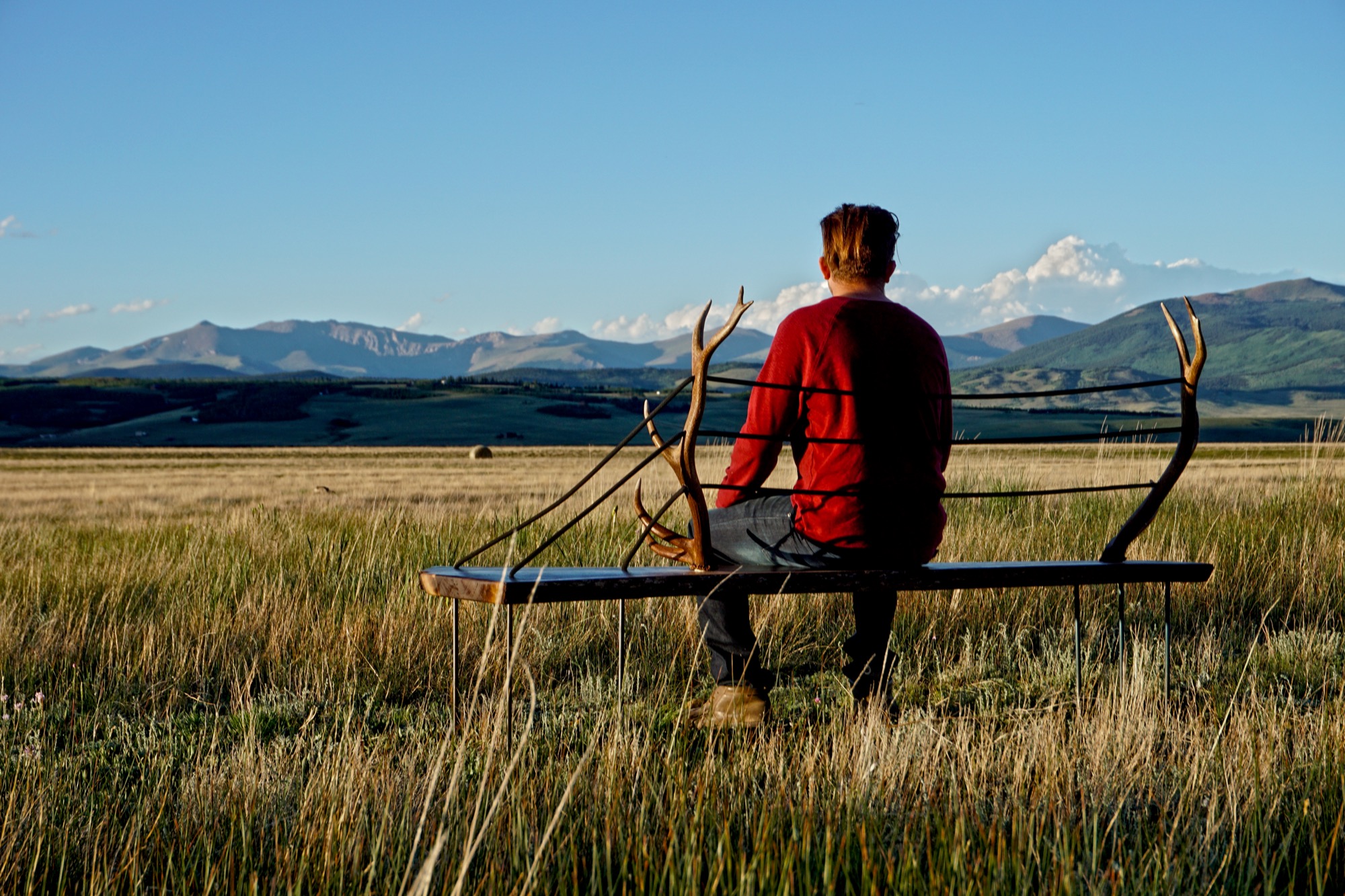
Rudy Unrau
Unrau, while attending college in Western Colorado, signed on with the United States Forest Service. “I was on track to becoming a smoke jumper, working for a helicopter crew down in Durango,” the long and lanky woodworker recounts. “It was a great setup because you work a ton in the summer, and then you get winter free to do whatever you want, like ski and move to Canada.”
Throughout those years, Unrau had been harboring the desire to return to making art. “Seeing the things you see when you get to fly around and travel the US and go to all of the mountain ranges... I had ideas emerge to work with the trees that had been burnt or partially burnt in fires because they get so twisted and cool.”
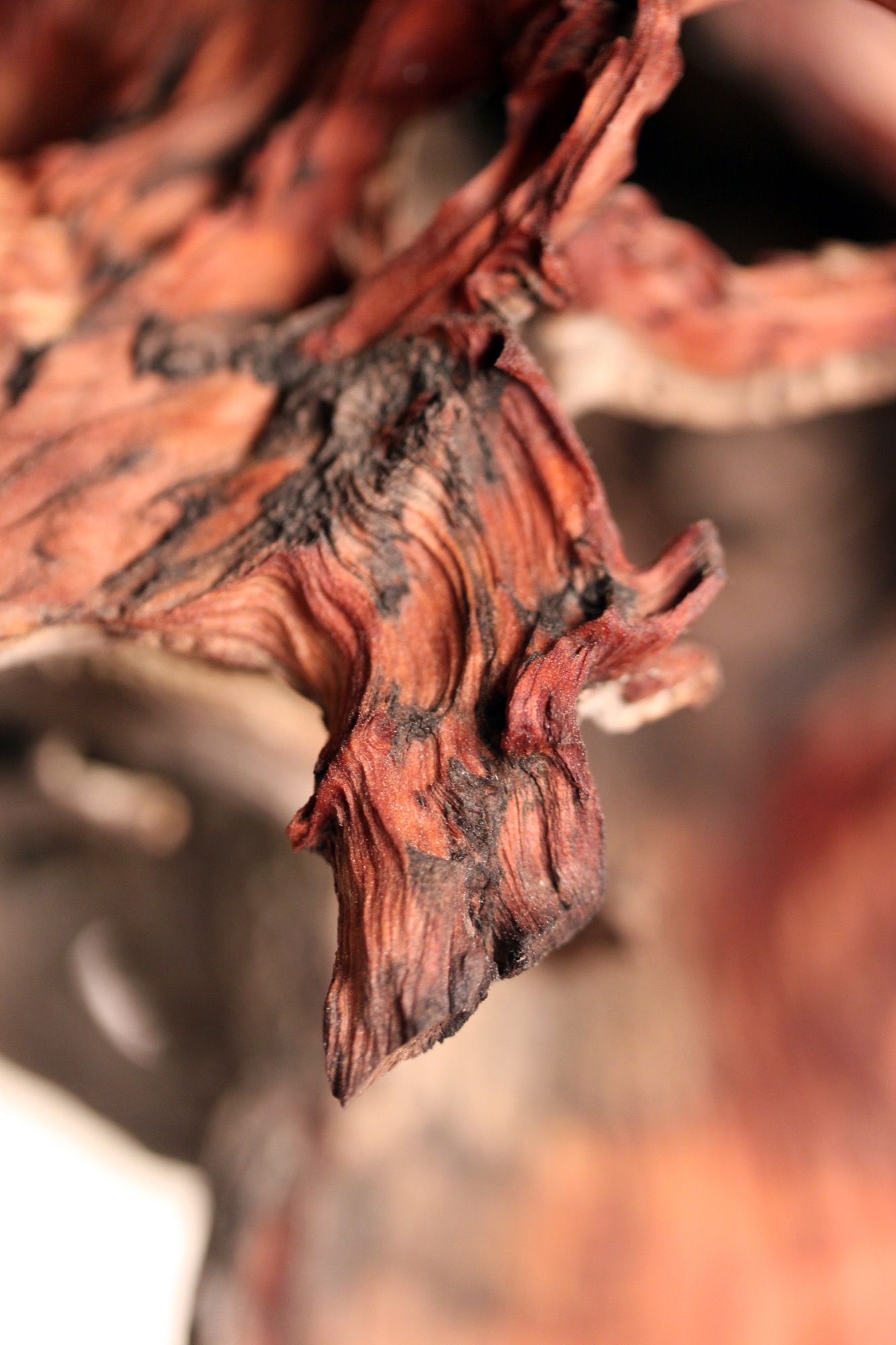
"I had ideas emerge to work with the trees that had been burnt or partially burnt in fires because they get so twisted and cool.”
Joint adventure up north
At last, one pivotal winter Hine and Unrau moved to British Columbia together to ski. Their close friendship and mutual influence would impact each man’s path. “Rudy was all in the woods,” Hine remembers, “Living together pulled him back into the design world and brought me back into the woods.”
Unrau agrees: “I’ve always been at home in the woods. Growing up, I really wanted to pursue mountain biking, so I raced mountain bikes professionally for quite a few years.” After the athlete got “a little bit tired” of mountain bike racing in world cups, he focused on skiing.
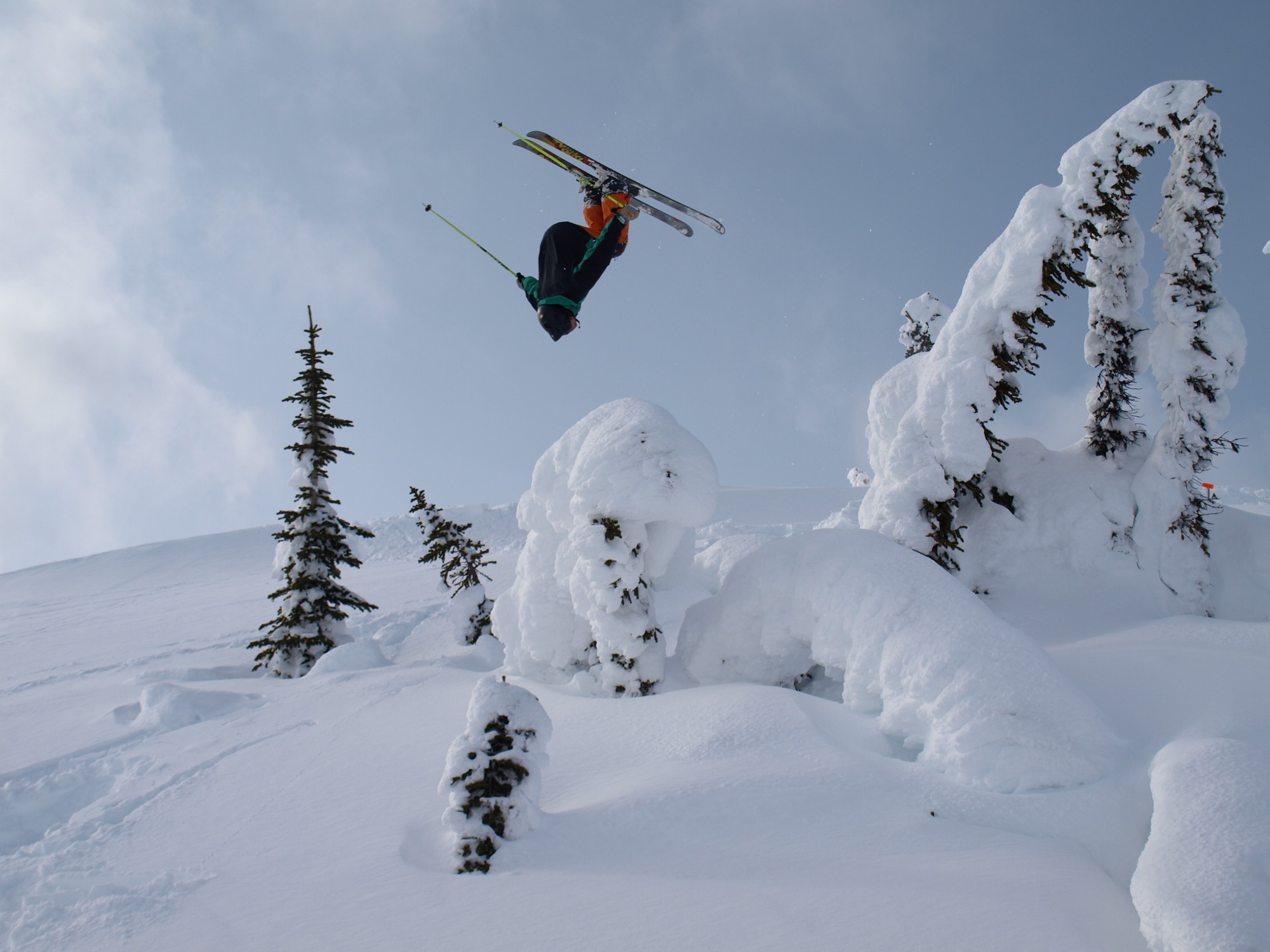
Skiing in Canada was good fun. Winter gone, however, Unrau planned to work another fire season. The outdoorsman envisioned himself carrying on that seasonal rhythm of demanding service and wild adventures in the snow for years until he had and his friend had their fill of youth and independence. “And... I crashed paragliding,” he tells, falling solemn all of a sudden. “I broke my back and almost died and spent half a year recovering.”
His loyal friend by his side, Unrau needed to reevaluate his future. “I realized, I wouldn’t be able to do fire again,” he says. “And then it was pretty natural the way MTN Lab came together—us getting our shop set up to where we could build.”
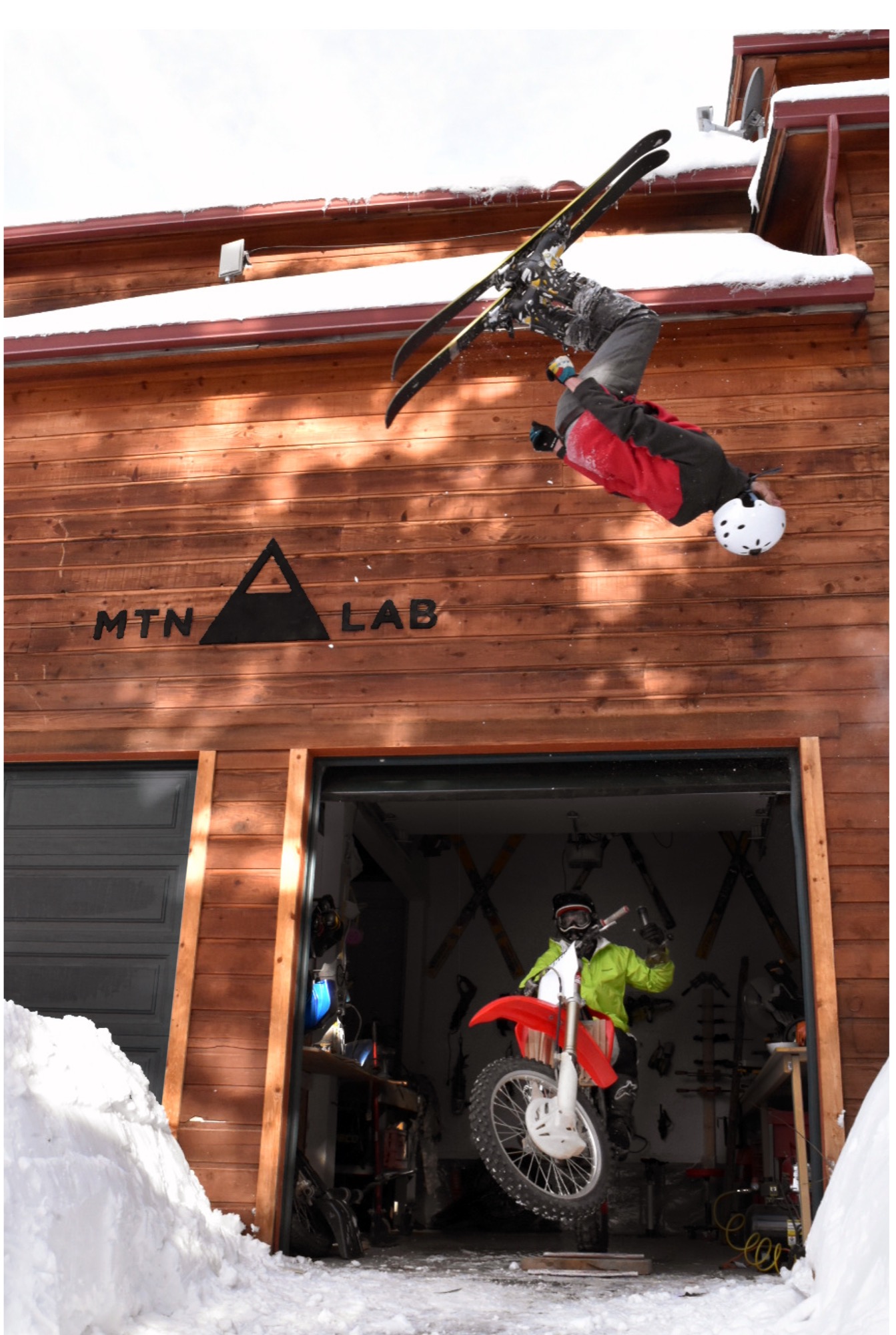
The MTN Lab process
Starting with sculptures, the duo soon began venturing into furniture. Their vision is to grow the Conifer studio into an art collective, with more creatives joining them. They are even planning to build a tiny house to accommodate visiting artists and designers.
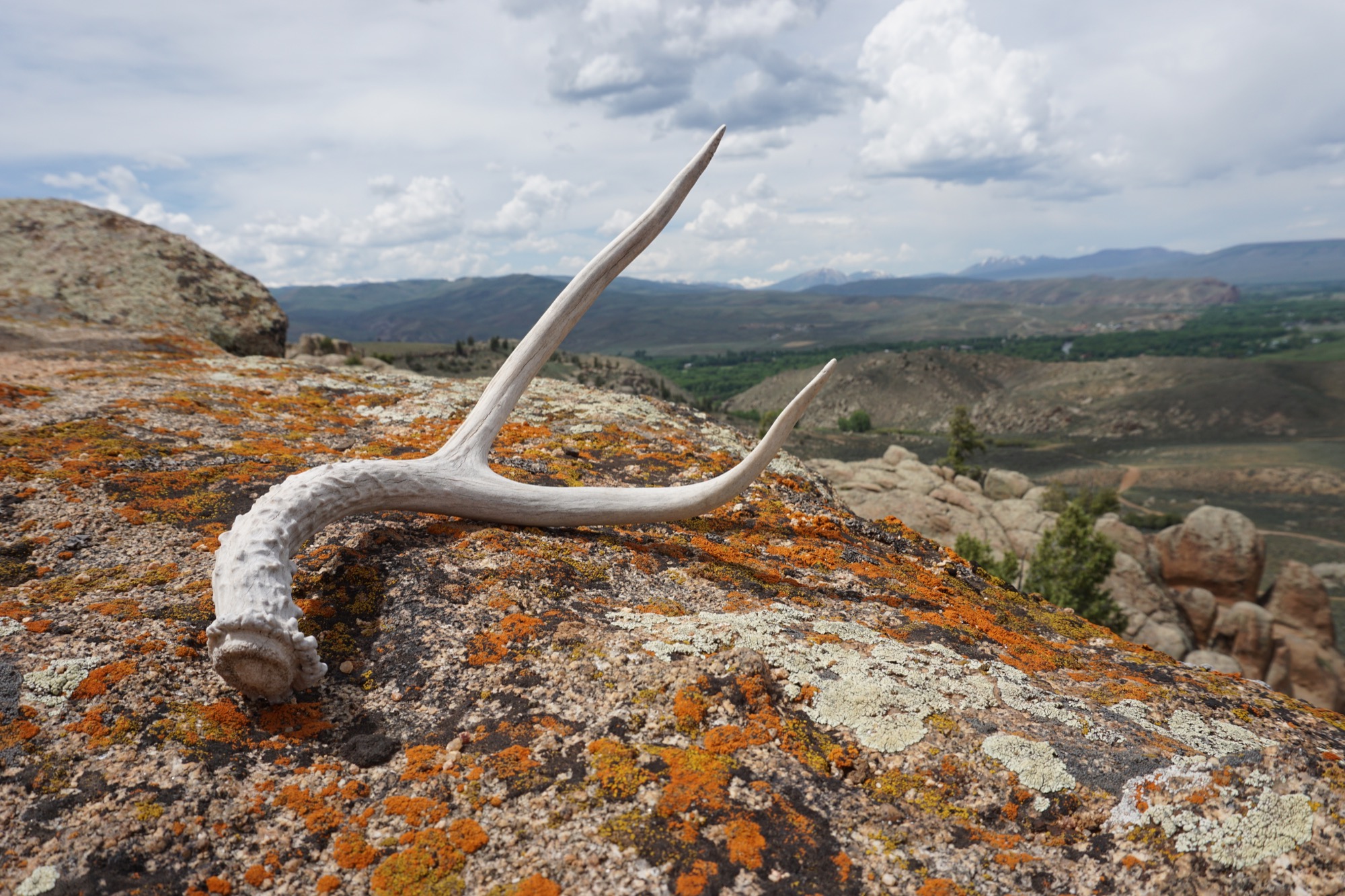
MTN Lab is as much a concept as it is a company. “Our process is the most indicative of what we make,” Hine explains. The founders source all of their materials themselves in the Colorado mountains. “We quarry our own stones to carve and collect our own wood.” Like it was for generations of makers in the mountains before them, MTN Lab’s workflow follows nature’s rhythmic swing. “Right now it’s the season for us to go get river stones because the flow just came down,” Hine tells me, when I sit down with him and his partner on that warm day in early September. “And we are doing antler stuff because we found a bunch of Elk sheds. That’s this flow that we follow.” Adds Unrau: “Our company is trying to do the whole process from sourcing, getting our materials, designing it, building it ourselves, photographing it ourselves.”
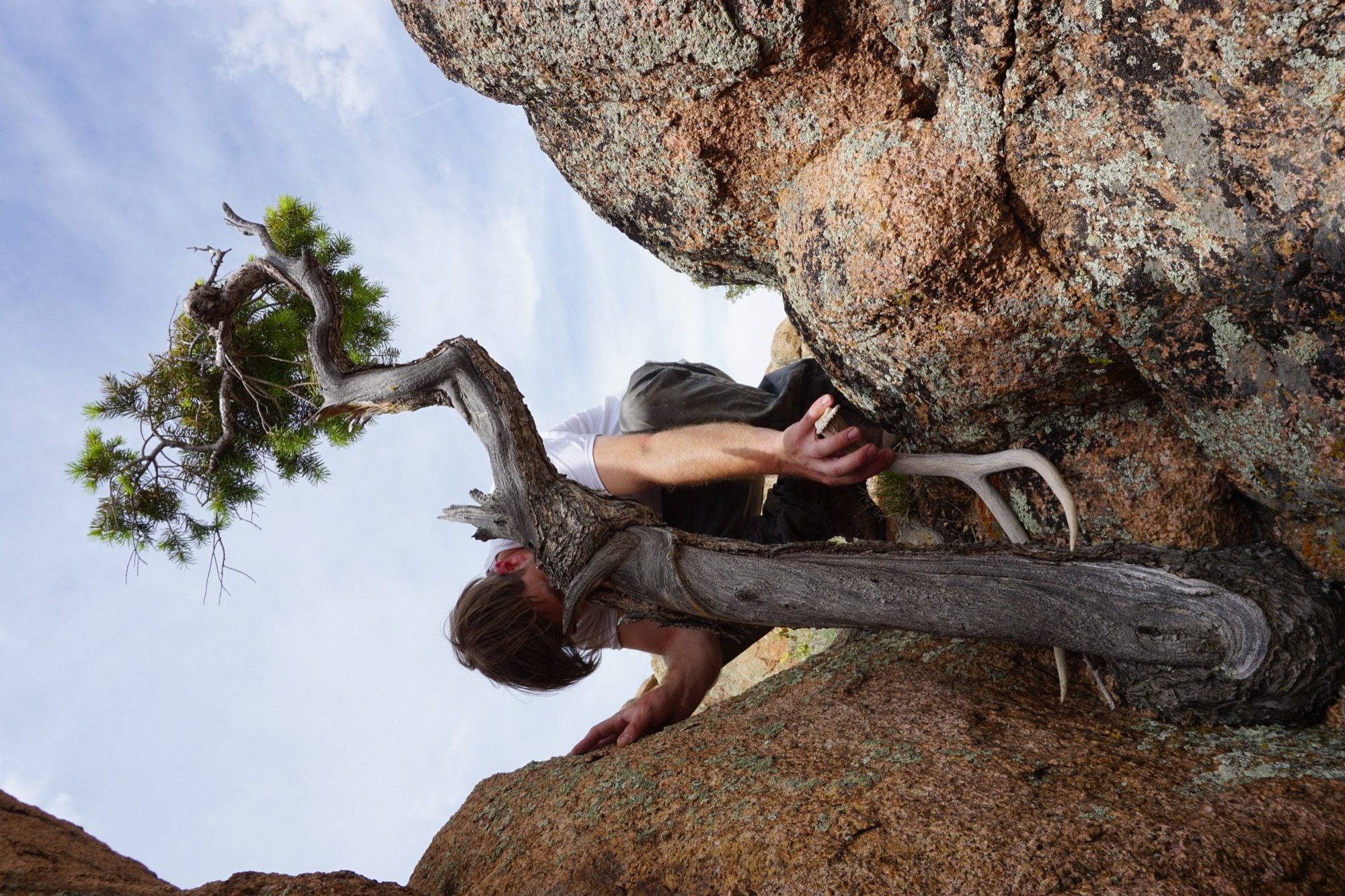
The friend believes having grown up in the mountains is what motivates them to see the entire process through, from beginning to end. “Spending all of your free time in the backcountry—you’re just so inspired by what you’re surrounded by,” Unrau says. “Initially, we were out there to ski, climbing to ski. We were dirt-biking. But when you spend that much time out there, it altered our perception of why we were there. And now it’s awesome because we get to ski, but that’s not the whole part of the process. The ski is the vessel for finding the materials—as well as the inspiration.”
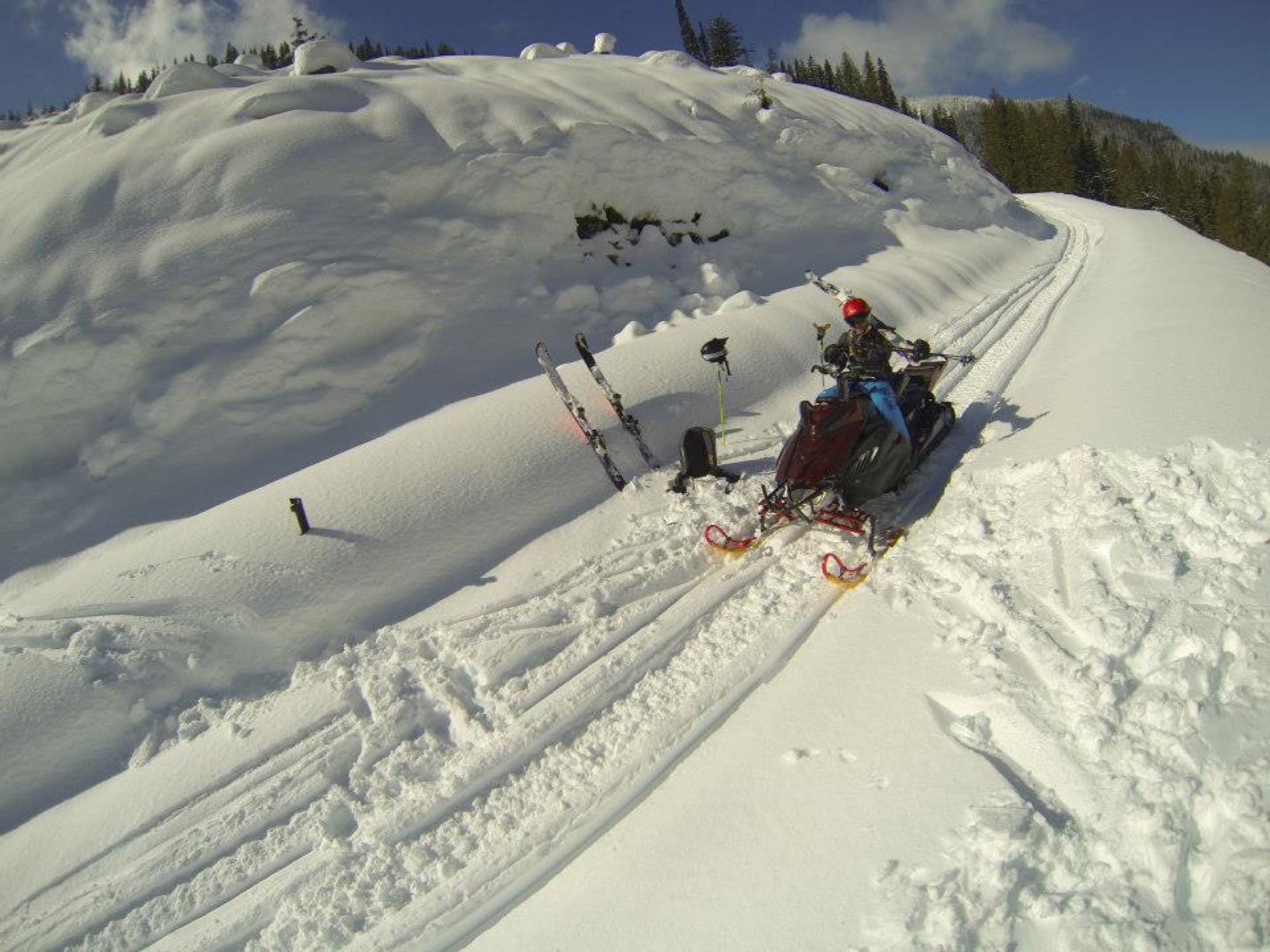
“The ski is the vessel for finding the materials—as well as the inspiration.”
Connecting nature and art
“I’ve always liked minimalist design, and I rarely see that done with natural materials,” Hine says. “You look at Bauhaus stuff, and it’s very industrialized. My dad being the modernist he is, half of me is always striving for that simplicity. But then there is the other part of me... the Colorado guy. And I see these cool pieces of wood and antlers and it naturally merged. In college, I was more on the industrial, clean-cut metal side of things, and my style has evolved more and more into a hybrid of rustic and modern.”
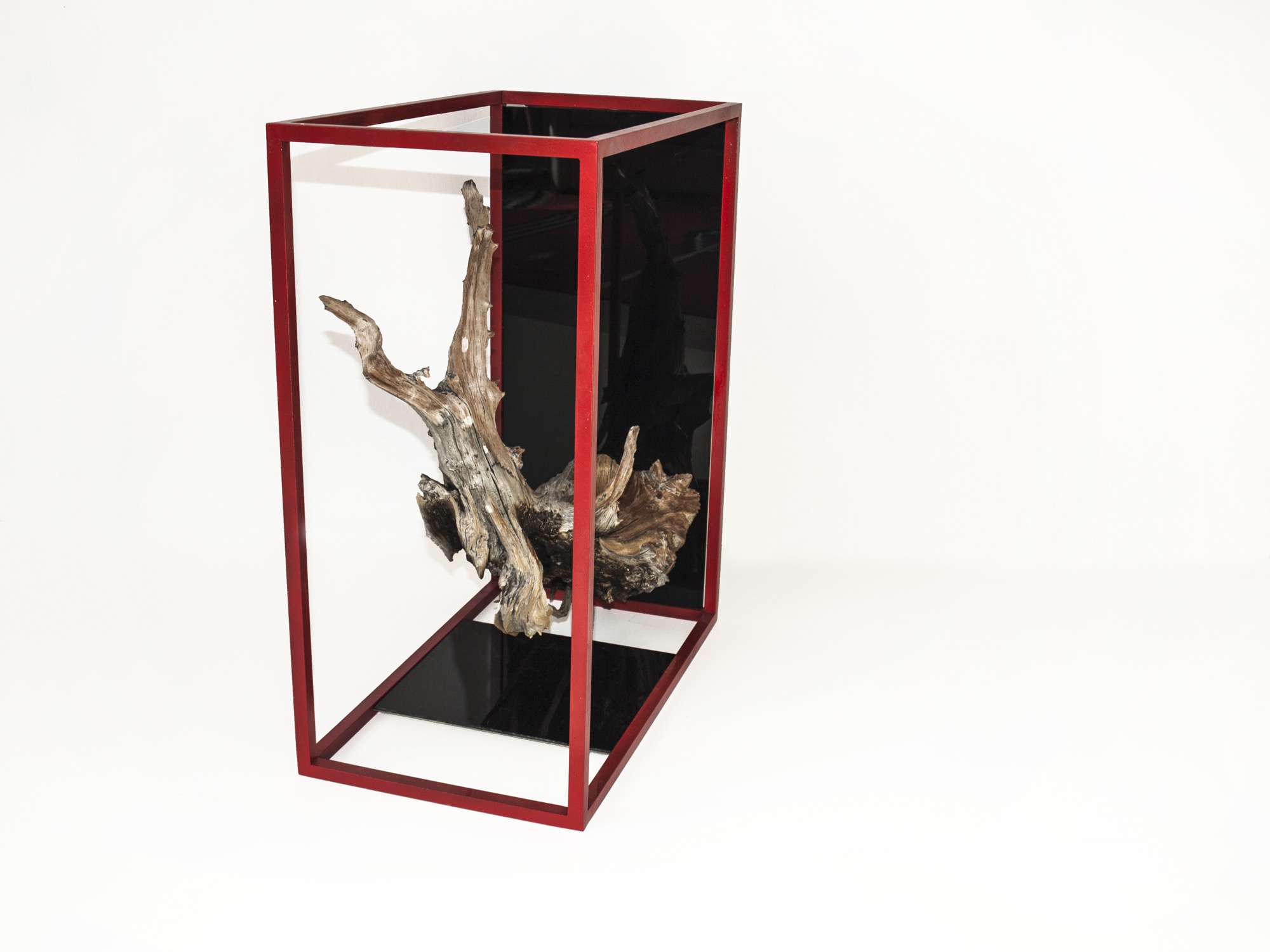
Unrau, for his part, never earned an art or design degree, nor does the lack of academic study in the field limit him in his current work. “We really do our designing when we’re out in the woods. We don’t sit down in an office to draw. We see the material, and the material almost dictates its design.”
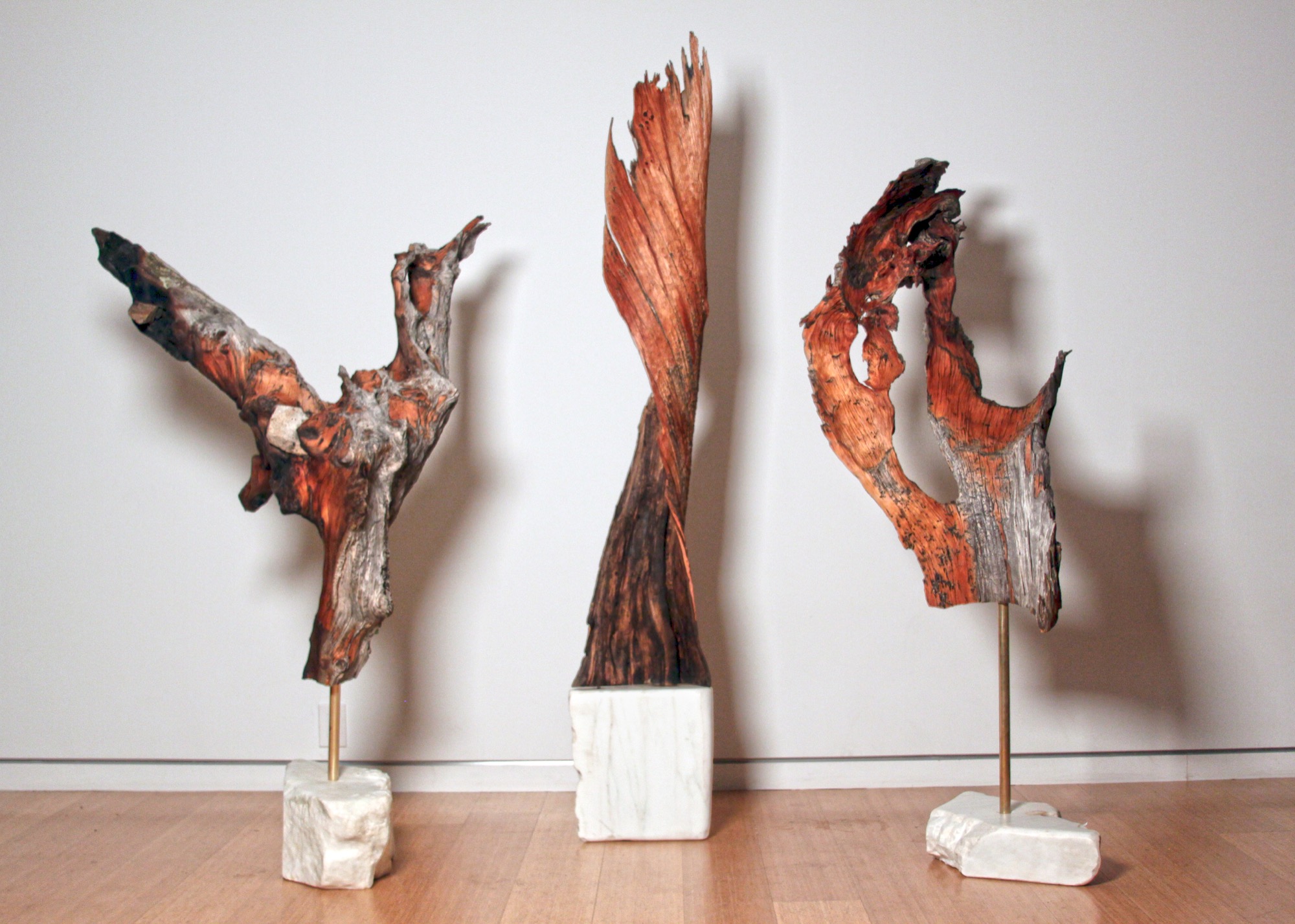
They usually know right away, if a piece of wood they come upon in the forest will transform into an art sculpture, a table, or something else entirely. Back at the studio, they combine found pieces of wood or elk shed with marble and often with contrasting metal. The final artwork or furniture piece comes together like a collage. While the sculptures are never drawn out, the furniture generally is. “We design our table bases, draw them by hand. Sometimes, we bring it into CAD.”
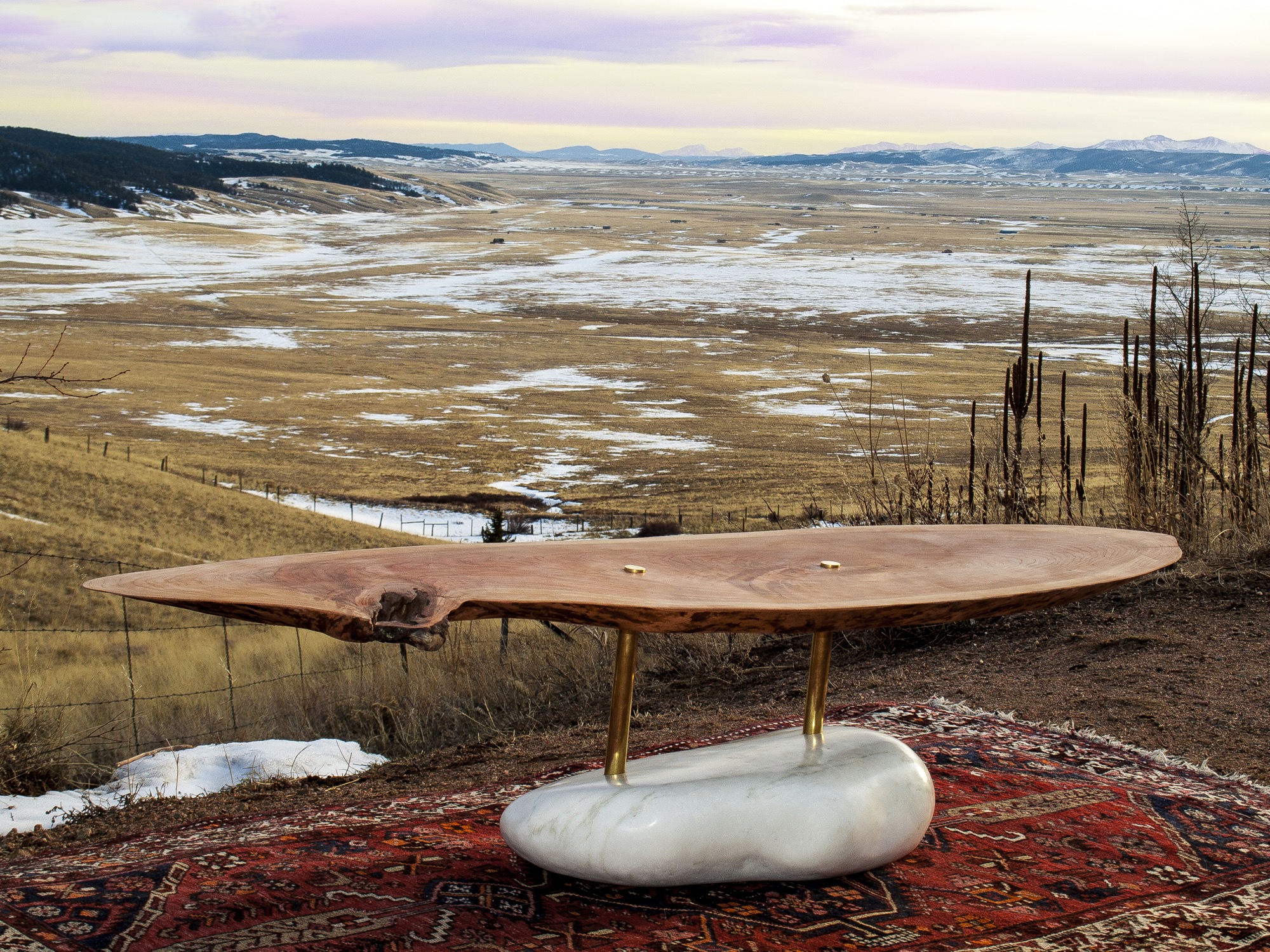
The day I met up with Unrau and Hine, they had come down from their studio above 8000 feet to deliver a piece of art they made for the Boulder Museum of Contemporary Art. “We had this mobile,” Hine begins, chuckling, “And then Rudy dropped it on the staircase, and we were like ‘Oh, no, we’re so crushed. And we had to quickly build it a second time yesterday, and it came out eight times better than the first. That process isn’t always easy to rely on, but sometimes when you make it again, it’s better. This is how we continuously design.”
Speaking about the synergy between Colorado’s magnificent nature, rich history and tradition, and progressive modern art, Hine notes that he is profoundly influenced by the stone carvings of American artist and landscape architect Isamu Noguchi. “It’s that blend of leaving these big natural boulders and polishing one face of it.”
Rustic designs with wood and stone are ubiquitous. “But it’s hard to find someone who has done them simple enough so that these materials individually speak for themselves,” hine says. “Antler furniture is really something we have been experimenting with, because it’s hard to find a simple antler-anything. All the chandeliers are the same hunter antler cluster. And all of a sudden, you are appreciating the simplicity of the singular antler as a sculptural element. That’s what makes it alpine modern, and not just alpine.”
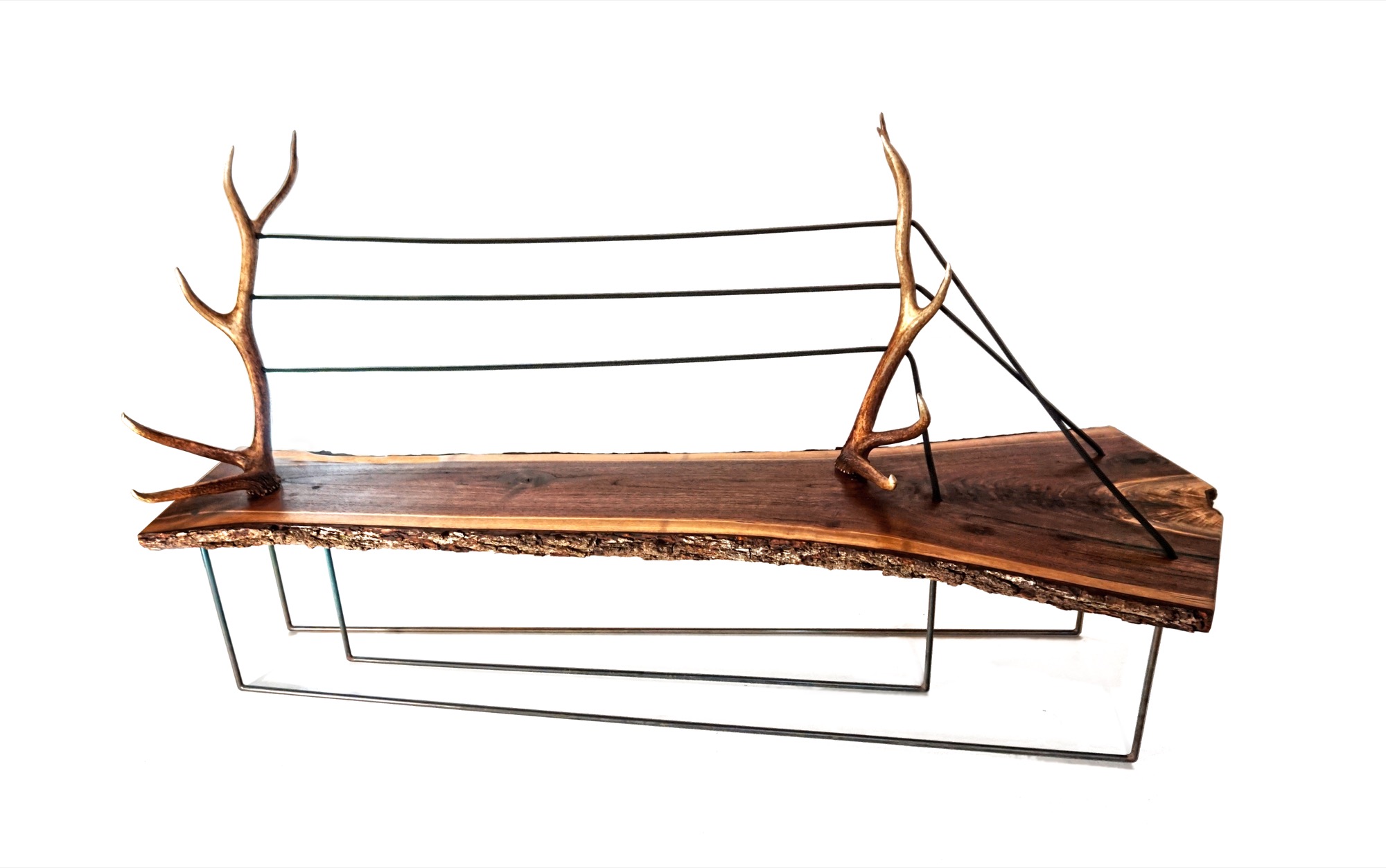
“And all of a sudden, you are appreciating the simplicity of the singular antler as a sculptural element. That’s what makes it alpine modern, and not just alpine.”
A modernists at heart, Hine still looks to the arts and crafts movement for inspiration. “Not stylistically but the whole concept of it is huge, especially since my education is in mass production and industrial design and product development. And going back to actually hand-building one-off pieces from the found materials we use, you can’t really build the same piece twice. It’s almost like we’re in an arts and crafts revival, which is weird for me because that’s the antithesis of the Bauhaus influence, of going from craft to industrial production.”
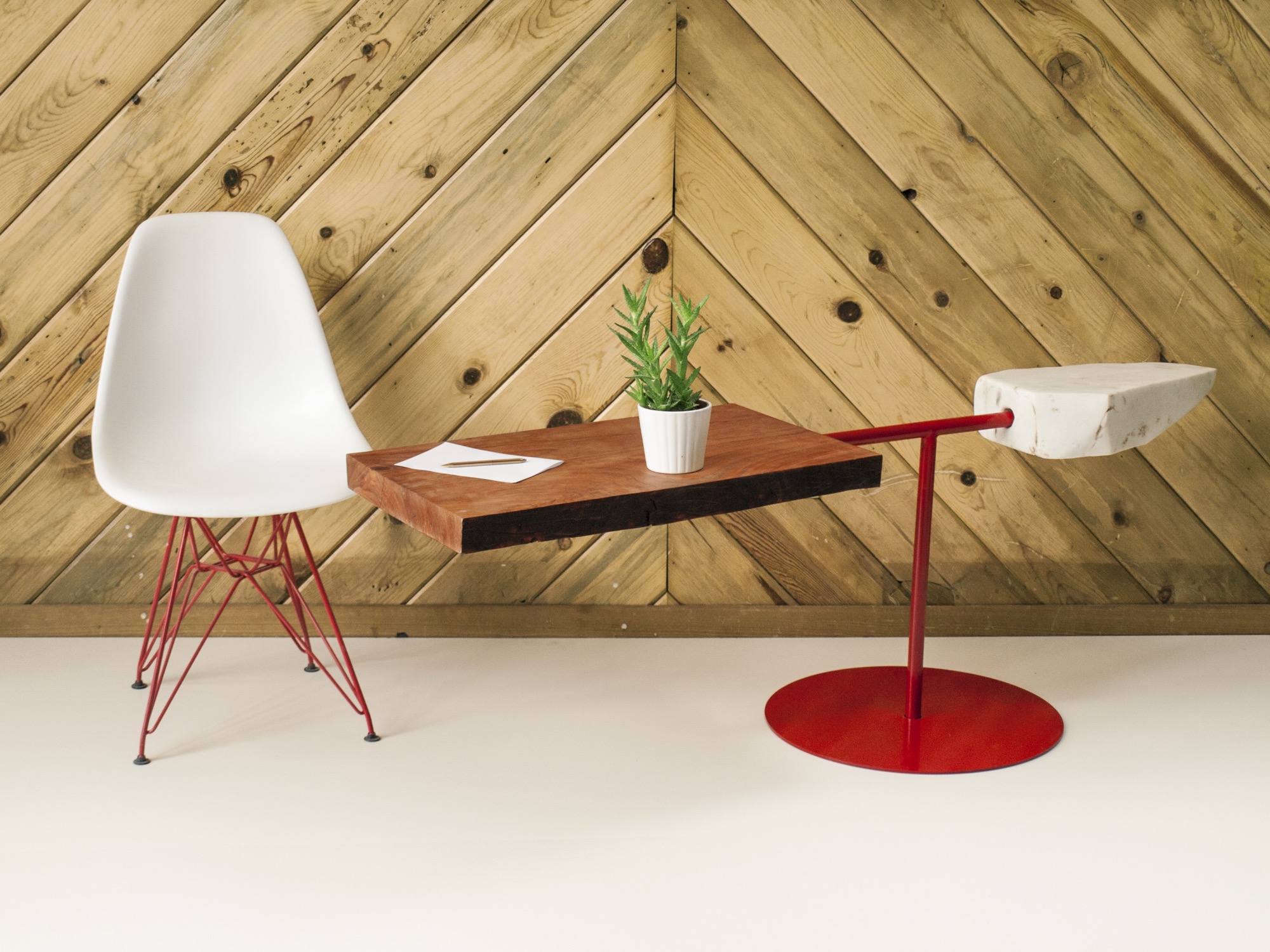
Our conversation later on reveals that the two 27 year olds are somewhat of an antithesis, too—to their fellow millennials. The Internet, they admit tittering, is their shortcoming. “Neither of us really enjoys social media, self promotion, or even doing the sales part,” Hine says. “It’s the cliché artist who doesn’t sell his stuff. We just are either in the woods or in the shop. It never feels like were working.”
MTN Lab projects
Each MTN Lab piece embodies a story of adventure and friendship.

For example, Unrau says seventy years ago, many trees were cut down to make room for high-voltage lines to Fairplay, south of Breckenridge, Colorado. “The company just left them, so these big old-growth rounds have been drying up there all these years,” he says. MTN Lab milled the pine rounds into table tops. “That’s our next big design push, designing bases for those tables,” he says. “Or the motorcycle, which is a lifelong dream we’ve shared since we were little kids.”
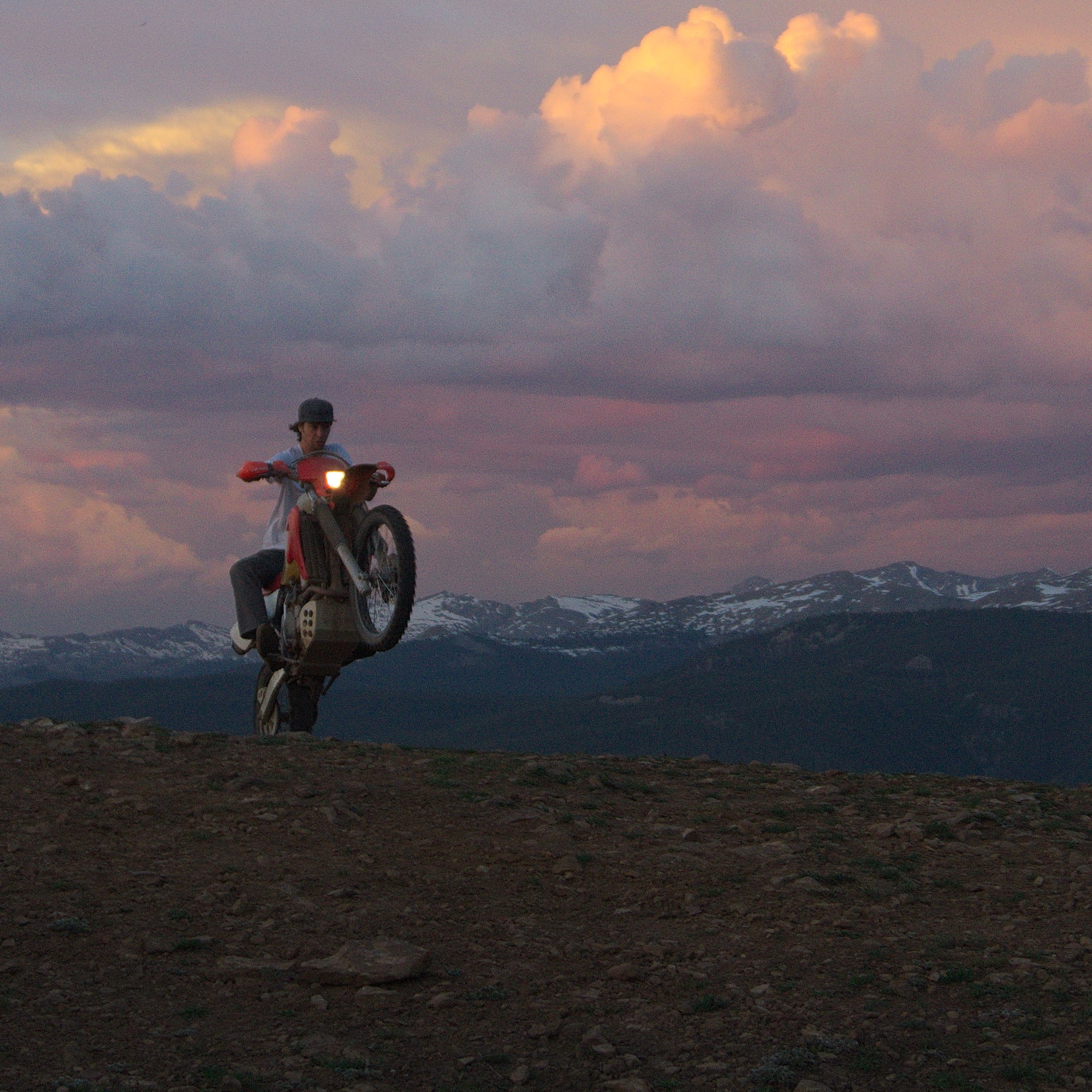
Indeed, Hine and Unrau want to build a motorcycle entirely from scratch, the back end made hand-carved in wood. Before winter, they even want to experiment with producing their our own steel, from mining the rock to crushing and melting it. Whether the resulting material will in fact be usable won’t matter as much: “At least we will be able to appreciate the process when we go to the store and buy steel.”
“The motorcycle is going to be very much like our furniture and our sculptures,” Unrau says. “I would describe it as an art bike. It’s going to be functional. It’s going to ride very well, but it’s not going to look like a conventional motorcycle. I don’t know if we’re going to be willing to sell it.” The business partners are also debating whether they will ever have the heart to sell the 1960s Airstream that once belonged to Unrau’s grandfather and they just finished restoring. “I never want to sell any of our stuff,” Unrau admits, laughing. “It’s hopeless.” △
Retreat and Return
An essay on escaping to anywhere but here, getting messy in nature, and connecting to what is real
If you stand in the middle of an empty Downing Street, around 30th Avenue, in Denver and look straight ahead, you will see a light-rail station jettisoned beside the street and some low level buildings that litter the periphery as a long stretch of asphalt leads the eye to the horizon. Miles away, two grayish, 1980s skyscrapers frame a view of the foothills. You can make out the patches of snow and tree lines along the ridge and grasp for them. This glimpse of the mountains through the frame of the city, surrounded by civilization and commodity, creates the desire to run from the banal into the still, quiet reserves of solitude. Civilization and solitude, city and wilderness, the balance and distinctions can often be so tenuous and vague. Where does one start and one begin?
Filter of escape
When I think of escape, it’s about an ethereal atmosphere: where the light sending shafts across your face is just right, words fall with a satisfying poignancy; it’s very poetic and meaningful. It is the sort of moment where you imagine that you could probably write a play, or a memoir. It is often meticulously calculated and captured on social media. It’s this dream I sometimes have: his face clear amongst a hazy backdrop, and there is a golden glowing that moves warmly across his lips as they move. It is late summertime. I do not know what he is saying, but I feel the meaning of the words. There is a way that our photographs make things much softer, much more beautiful, much more inhabitable than they really are.
“It is the sort of moment where you imagine that you could probably write a play, or a memoir.”
How do we value the observing and interacting within landscapes without resulting in the dreamy nostalgia of escapism? What is the danger of over-romanticizing our nature, our hideaways?
Historically, “escape” denoted fleeing towards liberty, freed from an irksome or controlling reality. It was only in the 1930s that escape began to be used etymologically as a method for retreating from reality. To “escape” became “escapism”: the tendency to seek distraction and relief from unpleasant realities, especially by seeking entertainment or engaging in fantasy, modeled by escapist literature that provided a refuge for those harried by the changes in modernism.
Similarly, in the 1800s, the noun “hideaway” denoted a person running away or a fugitive but shifted in the 1900s to primarily be used to describe a place of concealment or retreat.
Modern escapism
Research on “escapism” began in the 40s and 50s, a post-war mentality in which escape was a necessity, and researchers examined the connections between media consumption and life satisfaction. In 1996, Peter Vorderer described escapism as the desire most people have, in unsatisfying circumstances, to flee reality in a cognitive, physical, or emotional way.
Geographer-cum-philosopher Yi-Fu Tuan’s book Escapism is a dazzling exploration on cultural manifestations of this desire. In Neolithic times, our ancestors may have built shelters and plated crops to escape nature’s harshness, but now we escape the urban for the suburban lawns and parks. Tuan speaks of Disneyland, glass-towers, ivory towers, and malls—all tenuous monuments to the dream, away from the uncertainties of life, often imposed by a nature we still cannot yet control. At what point, Tuan argues, is escape inescapable? How is escapism hardwired into our human makeup? If to escape reality is to create a malleable nature, then what aspect of culture is not escape?
“If to escape reality is to create a malleable nature, then what aspect of culture is not escape?”
Away, away
“The grass is greener on the other side,” runs the clichéd motto. I often search for discounted plane tickets the night before a large deadline or after a particularly nasty fight. I could move somewhere else; I could start over. I would not need to worry about these things if I ran. A sudden urge to sprint until I’m panting, until all the air has dispelled from my chest, to use my body, overcomes me. It reminds me of an Avett Brothers refrain:
The weight of lies will bring you down And follow you to every town 'cause Nothing happens here that doesn't happen there So, when you run make sure you run To something and not away from 'cause Lies don't need an aeroplane to chase you anywhere
Plainly, People want to “get away,” and I fully understand the desire. Ecotourism has exploded. We put rails along the edges of cliffs and commercialize Yosemite, all the while promoting an Airbnb in the middle of nowhere. Advertisements show us quiet beaches, toes in the sand, and shimmering waters devoid of noise and other tourists. We would be much better people, we are sure, if it were not for the distractions. A friend once told me, “Iceland is the one place on earth that looks the least like earth.” Beautiful, stark waterfalls and geysers against a backdrop of light yellows and green, an unearthly landscape, an utterly foreign nature. A place that seems to scream clarity from its minimalist landscapes. We escape to a place least like Earth; we want to stay there and soak in this alien feeling forever. We want to easily escape to places that are difficult to reach.
The desire to escape to simple and easy landscapes stems from a “milk and honey” mentality of the Promised Land that came to fruition in the literary genre of the pastoral. We’ve all heard the lines in our high school English courses from Marvell:
“Come lay with me and be my love and we will all the pleasures prove.”
Pastoral paradise
Scholars have condemned the pastoral for its flights of fancy and its tendency to oversimplify complex societal situations for a romanticized and reductionist nature. A genre predicated upon escapism, the pastoral offered a comfortable landscape to run to when society grew too weary or complex. Centered upon the notion of “Arcadia,” there was a landscape and realm of nature that remained untouched, primitive, and pure from the ravages of civilization where utopian harmony and balance reigned supreme. The shepherd sang of a “Garden,” a lost Edenic form of existence in nature. Raymond Williams, a key pastoral critic, argued that the pastoral rests upon the notion that the industrialized city has removed us from the peaceful existence we once had in the country. For him, this is “myth functioning as memory,” remembering a false past that our ideals have created, where the present looks back toward a decline of simple life in the past. We have all heard it, thought it, felt it: “Life was so much simpler back then.”
We want to escape back to the simple, when we were carefree and life had no troubles. When all we had to do during the day was watch a river lazily float by us. My friend and I plan trips to Moab, plan trips to Zion, plan trips to Yosemite. We think of the tiny homes we could purchase, the vans we could remodel, and slowly tweak our plans to escape from the grid.
“We think of the tiny homes we could purchase, the vans we could remodel, and slowly tweak our plans to escape from the grid.”
Which world is blasé?
At its core, escapism hinges on the question of the “real.” What is reality and what is fantasy? The critics tell us to blur the lines and mix them up; virtual reality asserts that these questions are passé.
But, rather, might they be blasé? Blasé came into linguistic fashion 1913 to denote when the ability to tell the distinction between particular things is lost. A haziness of atmosphere descends and mixes it all up. I often find that my escapist fantasies are dreamy: edges are blurry and details are vague, what I am reaching for isn’t concrete but an atmosphere, a feeling, that my memory has recreated for me. I am always confusing myself with my real life and the life I live in my head, the lives I could live and the person that I could be. It is easy to escape to the mind space where I have it all together; where I am writing my next work from the porch of my secluded mountain cabin.
“It is easy to escape to the mind space where I have it all together; where I am writing my next work from the porch of my secluded mountain cabin.”
Experiencing within context
When scientists speak of one’s ability to perceive, they talk about “enframing.” As we view a site or landscape, we are compelled to frame and categorize it. Our site defines our reality—we may know that other things exist because we have seen them before, but, at every moment, we are only capable of perceiving and understanding what the widths of our eyes allow us. Yi-Fu Tuan argues that modern men and women, living amongst aspiration and pretension, suffer from Milan Kundera’s “unbearable lightness of being.” Life up so high doesn’t seem so real. We want something material, something to come into contact with.
“Life up so high doesn’t seem so real.”
For Tuan, the “real” is the impact, sensation, and felt pressure of nature: callouses on feet at the end of a long, arduous hike; sweat lining our brows; dirt under our finger nails. The real exerts a feeling of “aliveness,” where habits are shaken up. It’s to come close to the ground. The Greek origin of the word humiliation stems from hummus and in its literal terminology meant “to come close to the earth,” mirroring the story of Anteaus, a Herculean type man whose strength only persisted as long as he was touching the ground. Bring Anteaus to the heights and he was helpless.
If, as Tuan argues, human restlessness looks for relief in geographical mobility, our desire to move closer to nature is a natural one. We search to escape to a place of lucidity that comes from simplification. For Tuan, if an experience brings clarity rather than just simplification, one can arguably say that they have encountered the real. This is the difference between appreciating moments, atmospheres, and landscapes, and escaping from the pressures to a “blank page.” What one needs is not escapism, but rather a middle landscape that stays in touch with the raw reality of the natural world that remembers the connection to civilization as well. False divides have never helped us. When we retreat to nature, we are never going to blank spaces, but places with a palpable, experiential essence—ecosystems with existence long before we imposed our imagination upon theses places.
What moves escapism toward the notion of retreat and return? Action, honest encounters with nature. Escapism rarely translates into action. It is usually a state of mind we hide in. Retreat, however, requires movement and action, relying on a balance between wilderness and civilization. When we only dream of escapism or see landscapes like National Parks as the locale of our get-aways, we create an abstraction that makes it easy to exploit other landscapes.
“Retreat, however, requires movement and action, relying on a balance between wilderness and civilization.”
Return with clarification
Thoreau may have secluded himself to retreat to Walden, but he returned with an answer, a prophecy for a complex and frazzled society, teetering on the uncertain brink of industrialism. George Puttenham, one of the first pastoral theorists, did not see the form as merely recording the escape to a more rustic form of life, but as a serious guise for societal discourse. It had a didactic duty to return with clarification for modern life. It was about bringing back balance between the wild and the human.
What we need is a return to dirt, to the messy physicality of nature experiences. Not the coziness that we seek to escape to, but places of deep meaning that we return to for the quiet balance we desire. As William Cronnon argues about wilderness theory: If we imagine that our true “home” is a wilderness we can escape to, we often forgive ourselves for exploiting the land that we actually live on. Instead, a quality of “wildness” might be instilled in all the landscapes we inhabit, not just the sublime we want to run away to. Escapism, in this way, can be a dangerous nostalgia: despising the real in favor for the imagined. Escapism operates off a dissatisfaction and false dualism that can actually subtly encourage environmental exploitation: instead of seeing nature, wildness, as something that continually surrounds us, we escape to “wild” places, while leaving the urban to continue to die. We forget to gently tend our gardens, when the goal of our relationship with landscape is the task of making a fulfilling home within it.
“What we need is a return to dirt, to the messy physicality of nature experiences.”
“If we imagine that our true ‘home’ is a wilderness we can escape to, we often forgive ourselves for exploiting the land that we actually live on.”
It’s the difference between a dreamy pasture and the dirt. In the dirt, there is a beauty that has forgiven its sense of idealism. It is not about the ease, though this can be a benefit. While the reconstruction of the event can be nostalgic, often the journey in the wilderness is not: one sweats, scrapes their knees, huddles under a tree from a thunderstorm, or comes into contact with an animal much larger and more powerful. What we reclaim in a retreat and return is real action and the sense of our bodies—the sense of touch, of reconnecting with the environs that surround us. The retreat into nature can remind us to be consciously aware that we are not separate from nature but a part of and subject to it. We are wrapped up, intertwined within it—where then can we escape from ourselves?
“In the dirt, there is a beauty that has forgiven its sense of idealism.”
Wilderness therapy
There are countless organizations today that rely on this sort of wilderness therapy—bringing people out into nature as an opportunity to disconnect from the virtual and remember the real. While not all of us are ready to live in a van or fend for ourselves in the wild, retreating and returning gives us the pros of a connection with landscape without falling back onto distraction, selfishness, and a misconstruction of nature. Retreating away for solace, meditation, and a clean slate, remembering the environment and mountains that sustain us, and returning to tend for others in a harried society is the beauty of the soil.
In Norway, Arne Naess, the father of the Deep Ecology movement, pioneered the “Friluftsliv” movement—a conviction that an outdoor life can provide an antidote to the stresses of urban conditions. It’s not about an either/or but a both/and. A hideaway, a landscape, an escape that connects you to the “real” can never be escapism. It is an experience that connects you to materiality, a grounding that comes closer to the earth, an eye that recognizes beauty in the particular.
So here’s to the weekend warrior, the backcountry skier, the Chautauqua walker, and the Rocky Mountain National Park junky. Here’s to the gardener, the climber-conservationist, and the trail runner. Here’s to the people who aren’t afraid to shove their hands in the dirt, who aren’t desperate for a chance to run away but longing for a connection to the still, quiet moments of reality. Here’s to the mountains that are always beckoning us to come closer, get humiliated, and find contentment. △
Dirt
Antaeus reveled in the materiality
of his strength
which became humiliation
like its root hummus
like to come close
to the level of the ridge
and feel the terra.
To know that aspens
are rhizomes,
interconnected,
roots woven through soil,
nothing left out.
To hideaway from
the dirt is to
drift toward the sun,
risking a heavy pitch
downward, mutually assured destruction.
I am trying to get close to the reality of taxonomy,
the soil, the naming, the root.
Here is best I can say,
far from despair:
From dirt we came
and dirt we shall return.
Poem by Haley Littleton / Illustration by Ben O'Brien
Over the Edge
French filmmaker Sébastien Montaz-Rosset goes to vertiginous hights to tell extreme athletes' heart-stopping adventure stories
French filmmaker Sébastien Montaz-Rosset dangles off cliffs and races across mountaintops to capture his swashbuckling subjects’ daring stunts but also to convey an intimate look at their fears, failures, and triumphs.
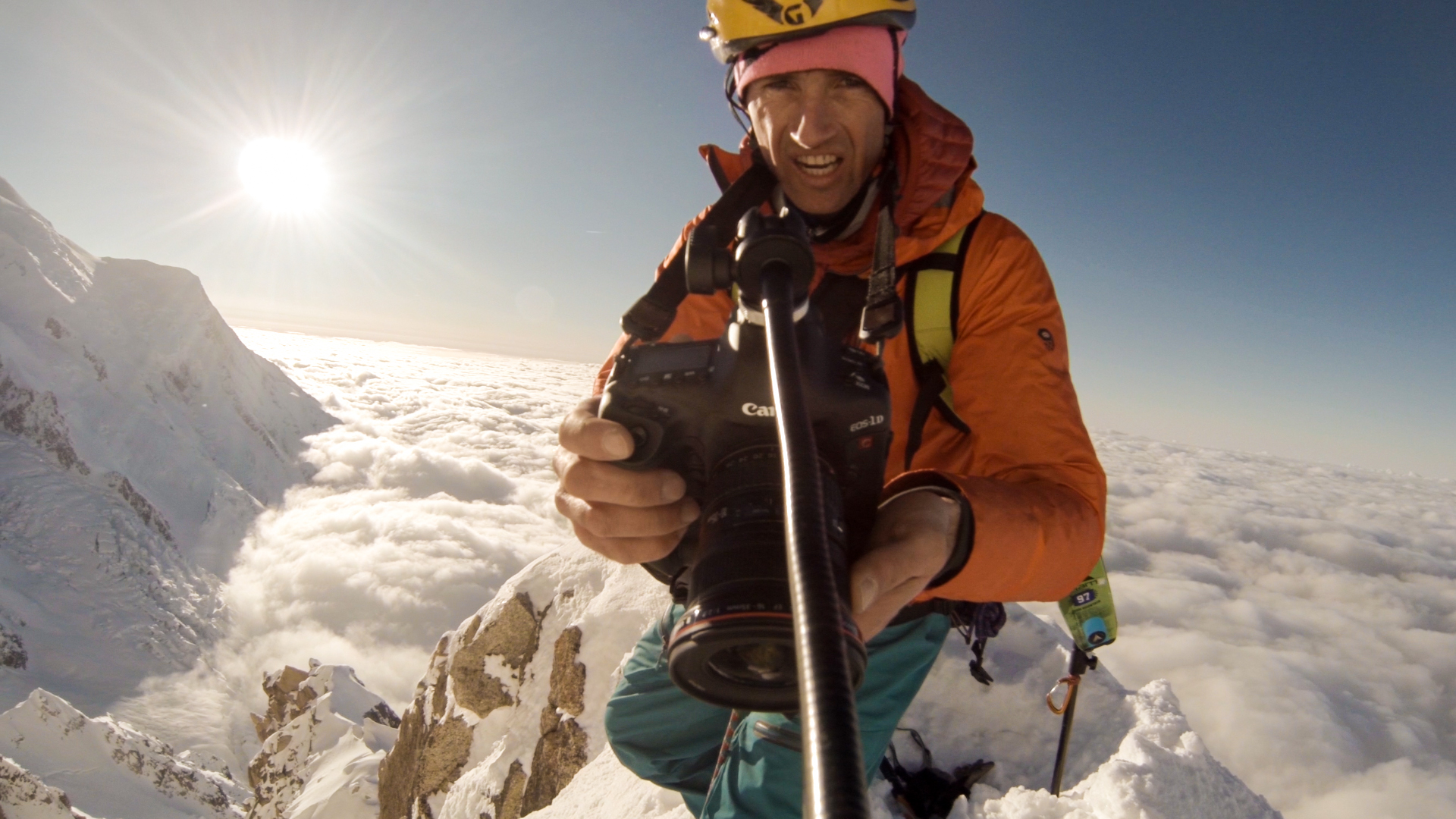
Watching the spellbinding work of French filmmaker Sébastien Montaz-Rosset, you want to cover your eyes but can’t look away all the same. The majestic mountaintop views immediately draw you in. But what mercilessly demands your soul and every fiber of your body is the heart-pounding terror that comes from witnessing death-taunting stunts; his subjects flirt with doom at every turn. This action-adventure-extreme-sports filmmaker captures shots from breathtaking angles most other filmmakers would never even dream of—say, dangling off a cliff or running along steep alpine ridges at full tilt. An athlete himself, Montaz-Rosset climbs—alongside his daredevil subjects—to virtually inaccessible locations thought to be beyond the realms of possibility.

High skill
That Montaz-Rosset is a passionate mountaineer, rock climber, runner, and skier goes along with the territory. It takes a high level of outdoor expertise and mountaineering skills coupled with innovative equipment to allow him to accompany people on their enthralling journeys. His work has been steadily gaining worldwide attention, most notably in the category of highlining, a combination of rock climbing, slacklining, and tightrope walking at treacherous heights, such as between two skyscrapers or mountain peaks. To slackliners, this is the pinnacle of the sport and something that’s attempted only after years of experience. Any small shift in weight or wind can easily send the cord into trampoline-like motion. Swift falls happen often, and while some use a fall leash to tether them to the main line, others pack only a small parachute as protection. The filmmaker and his athletes can’t plan ahead too much as the troupe pioneers this new evolution of the sport. Montaz-Rosset’s work requires quick thinking, improvising, and a remarkable amount of knowledge and training in wilderness safety.
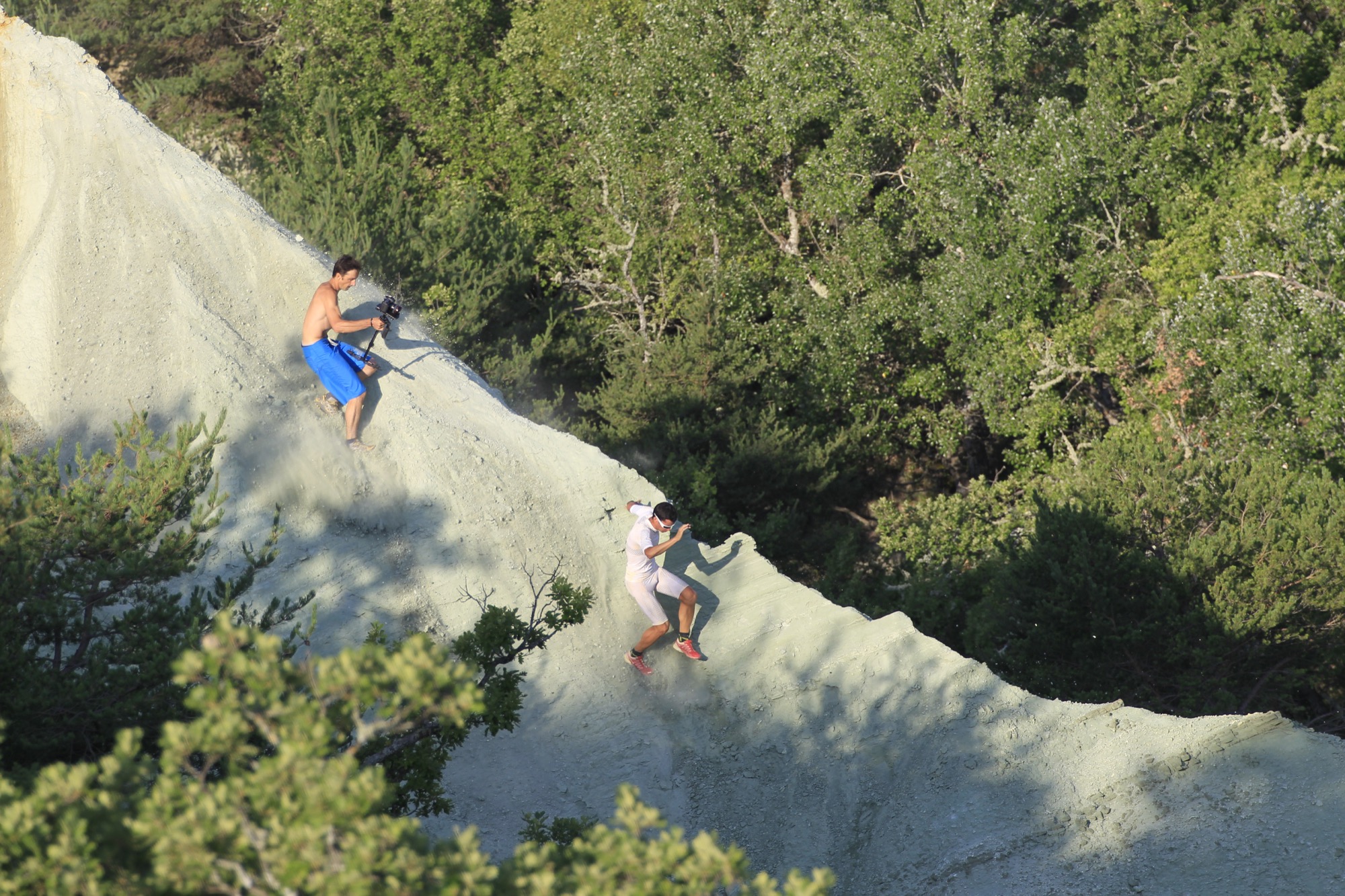
The mountain guide turned adventure filmmaker got his start shooting clients during mountain excursions in France. “I was born in Les Arcs in the French Alps and have always lived in the mountains. Skiing and climbing was what we all did growing up, and I became a mountain guide and ski instructor, like a lot of people who grow up in these areas,” says Montaz-Rosset.
Telling stories of triumph, fear, and failure
In addition to shooting commercials, Montaz-Rosset also recently filmed the first-ever attempt at suspending a highline between two hot-air balloons high above the Pyrenees. He strives to tell extraordinary stories about real people performing acts that trigger an avalanche of emotions in the athletes and their spectators. His work is aesthetically breathtaking, but it runs much deeper than thrilling action shots. It’s about letting the viewer behind the curtain to see the laughter, fear, triumphs, and failures. It’s about finding the strength to pursue aspirations. The filmmaker’s trick is to show the athletes’ point of view—the passion—so the viewer has an emotional connection while watching their gut-wrenching maneuvers; and sheer, raw vivaciousness bleeds into every frame of his films.
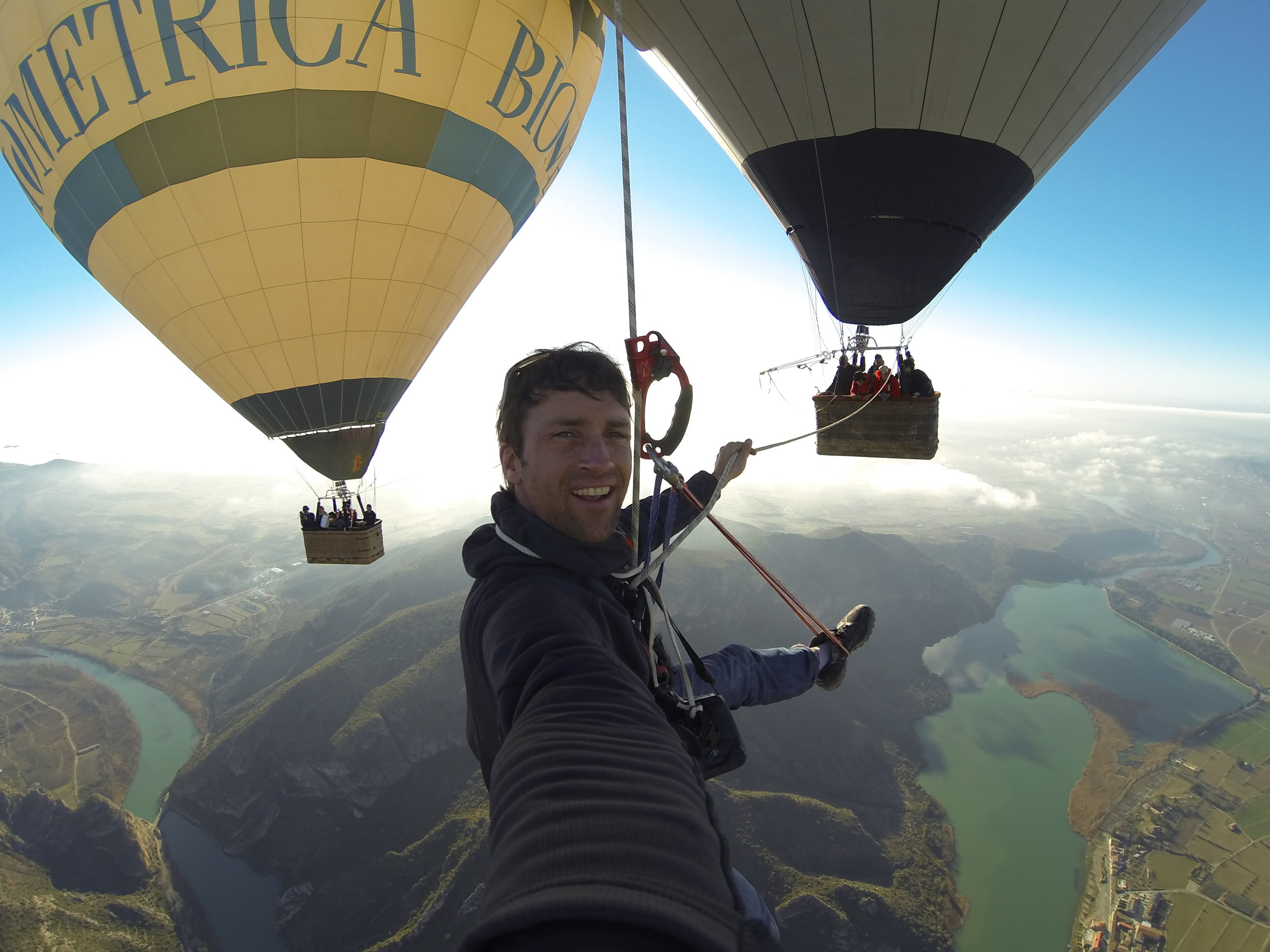
While high anxiety is a natural element of any extreme sport, Montaz-Rosset’s films show how the athletes react to and embrace it. “The people I film are so expert at what they do, fear isn’t really a big factor. It’s always present, but it helps you to concentrate on what you’re doing...it brings focus.”
“The people I film are so expert at what they do, fear isn’t really a big factor. It’s always present, but it helps you to concentrate on what you’re doing...it brings focus.”
The twist is that the athletes themselves don’t know if their stunt will be successful or not. The films are about the attempt and all the internal and external obstacles that go along with the journey. “I love telling stories, and I get inspired wherever there’s an interesting and different story to tell. It doesn’t have to be adventure sports, but that’s the environment I’ve grown up and live in, so the stories I tell are about the people in this environment,” he says.
The Flying Frenchies
So who are the subjects who fuel this high-octane artwork? Enter The Flying Frenchies, a wild and gregarious bunch of twenty or so lively, flamboyant characters. All are entertainers in their own right; each is equipped with her or his own skill and zeal. Performance art marries adventure sport in Montaz-Rosset’s film The Flying Frenchies: Back to the Fjords, where this gang of extreme athletes and performers bands together to create an outdoor alpine extravaganza like no other.
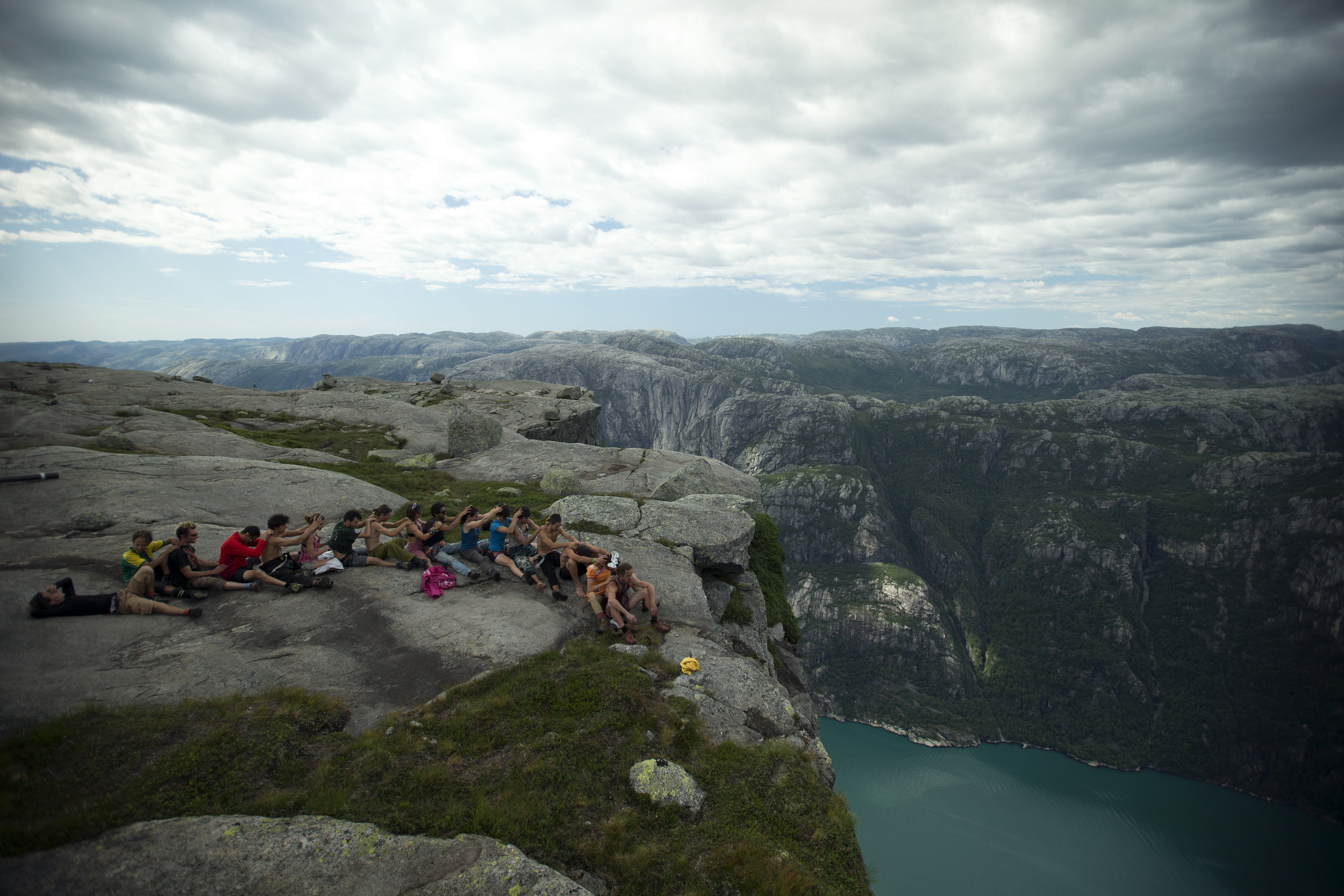
“These guys are always thinking up new ideas for stunts and things to push themselves in what they do. Several of them are circus performers, or they’re climbers and mountaineers, essentially. So what I’ve filmed is just a small part of what they do.”
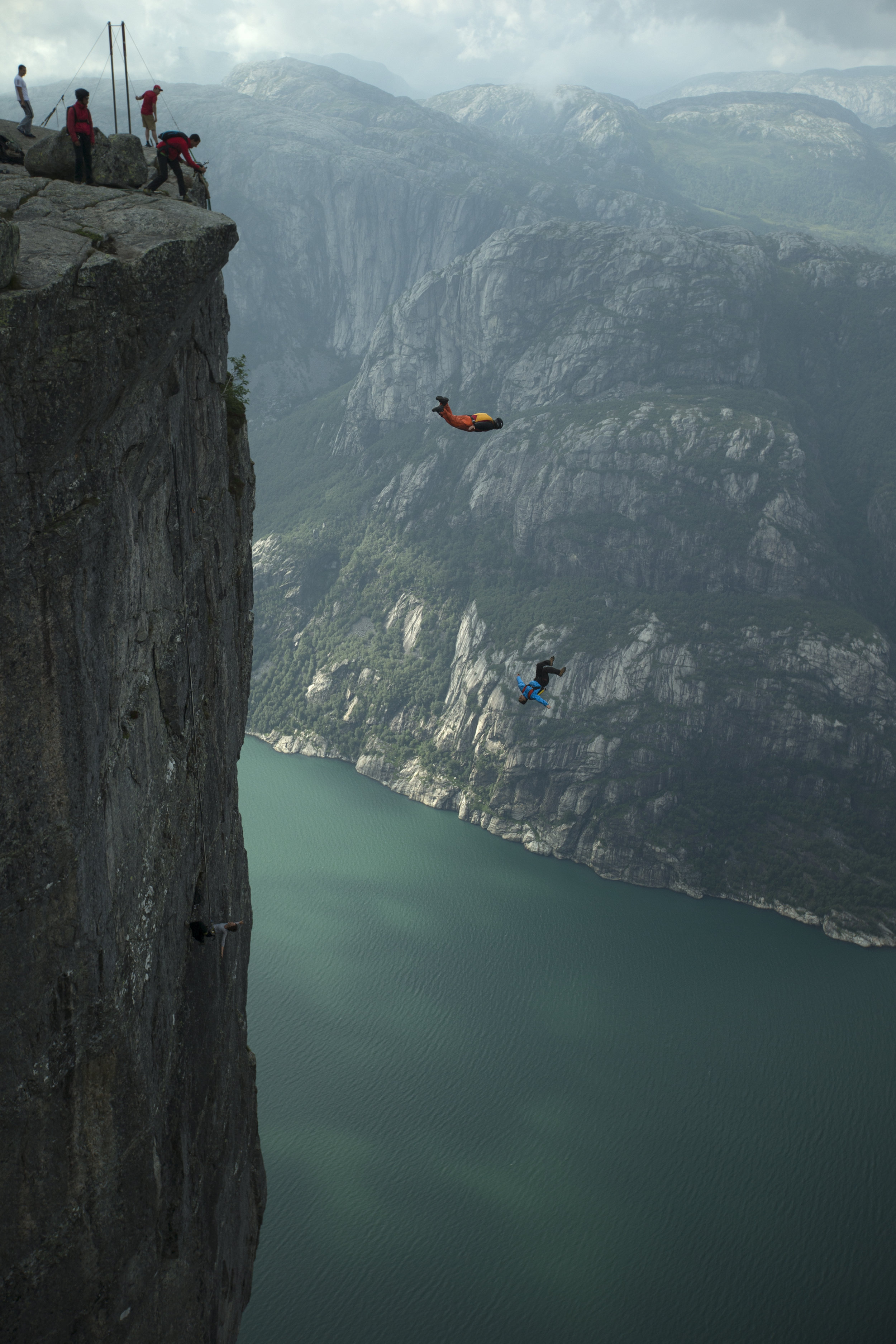
Engineers, along with BASE jumpers, wingsuiters, and musicians, make up the colorful pack. In Montaz-Rosset’s film, he follows the group as they travel through the fjords of Norway on a monthlong trip, embarking on various new extreme-sport-style adventures. Although at first glance it all feels very whimsical and impulsive—perhaps because they intermittently don clown costumes and props—months of painstaking preparation have gone into planning the journey, including intricate mathematical calculations and rigorous testing phases.
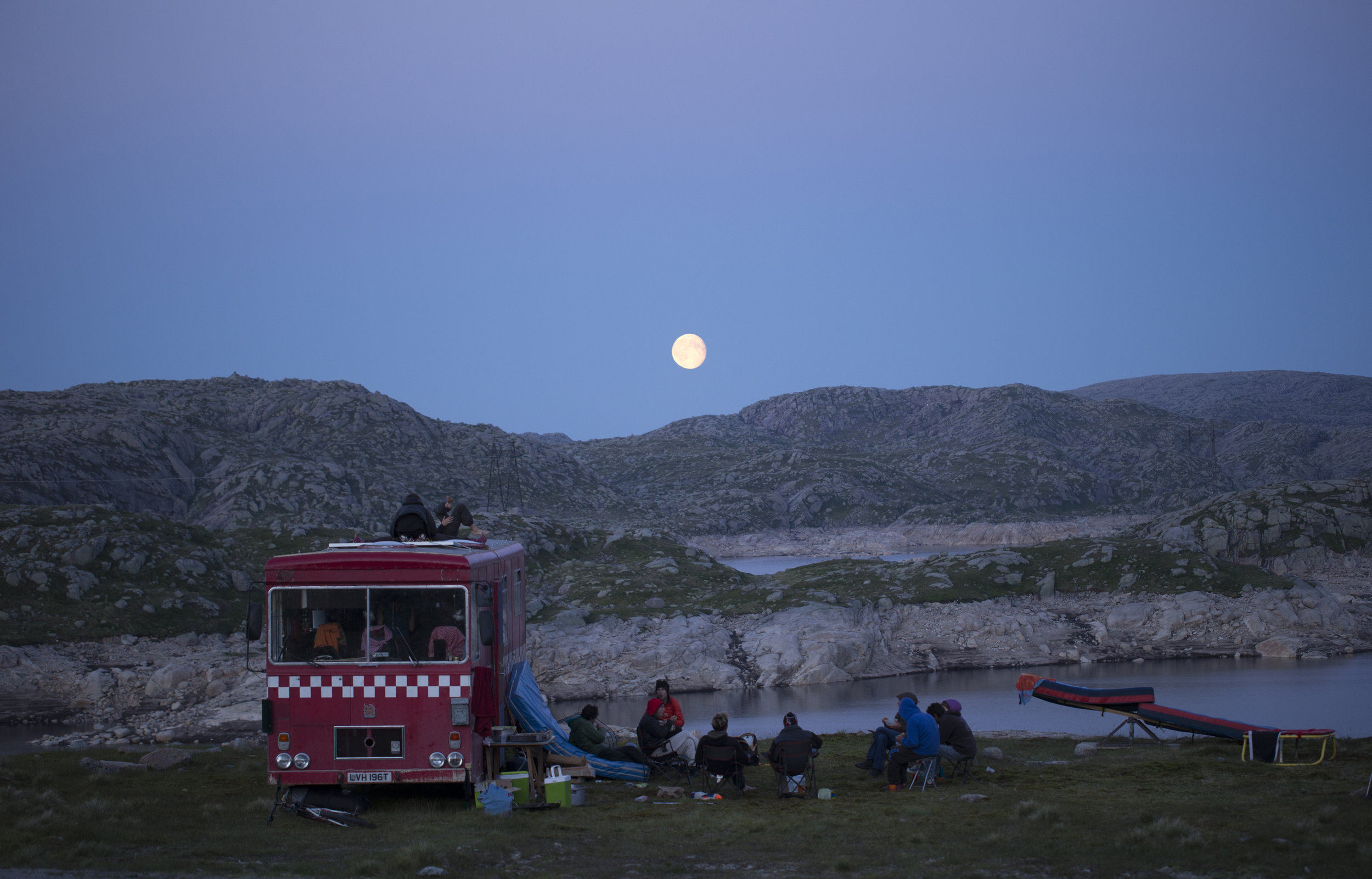
The Flying Frenchies travel across the country in a vintage red circus bus that has been renovated and packed to the gills with enough food for roughly a month. They also strongly value leaving zero waste as they go along, which takes additional planning. At night, the crew sleeps in tents, battling wind and rain and sometimes unexpectedly harsh elements. Montaz-Rosset captures outbursts of laughter and impromptu dancing, juxtaposing those scenes against hushed moments of stomach-knotting stunts in progress. On one rough night, gusting winds hurled a tent filled with camera equipment off the top of the mountain. “It was more of a setback timewise...we lost some things, but there was enough gear to be able to replace what was lost,” he says.

Artistry and athleticism
The worlds of performance and mountain sports collide when filming visually stunning footage of athletes running and cartwheeling off the mountain’s edge before parachuting down into the valley. Beautifully blending artistry and athleticism, the film embodies—and embraces—doing the impossible. Clowns and acrobats climb peaks; other performers BASE jump off slacklines. It’s about watching people push themselves to the brink of their physical and mental abilities—to witness what unleashes a landslide of emotion from within their souls and sets their spirits free—that we feel an incredible, intangible connection to them. “I just let them do their thing and try and be as unobtrusive as possible. You never know what you’re going to get filming them, so it’s always fun,” says Montaz-Rosset.
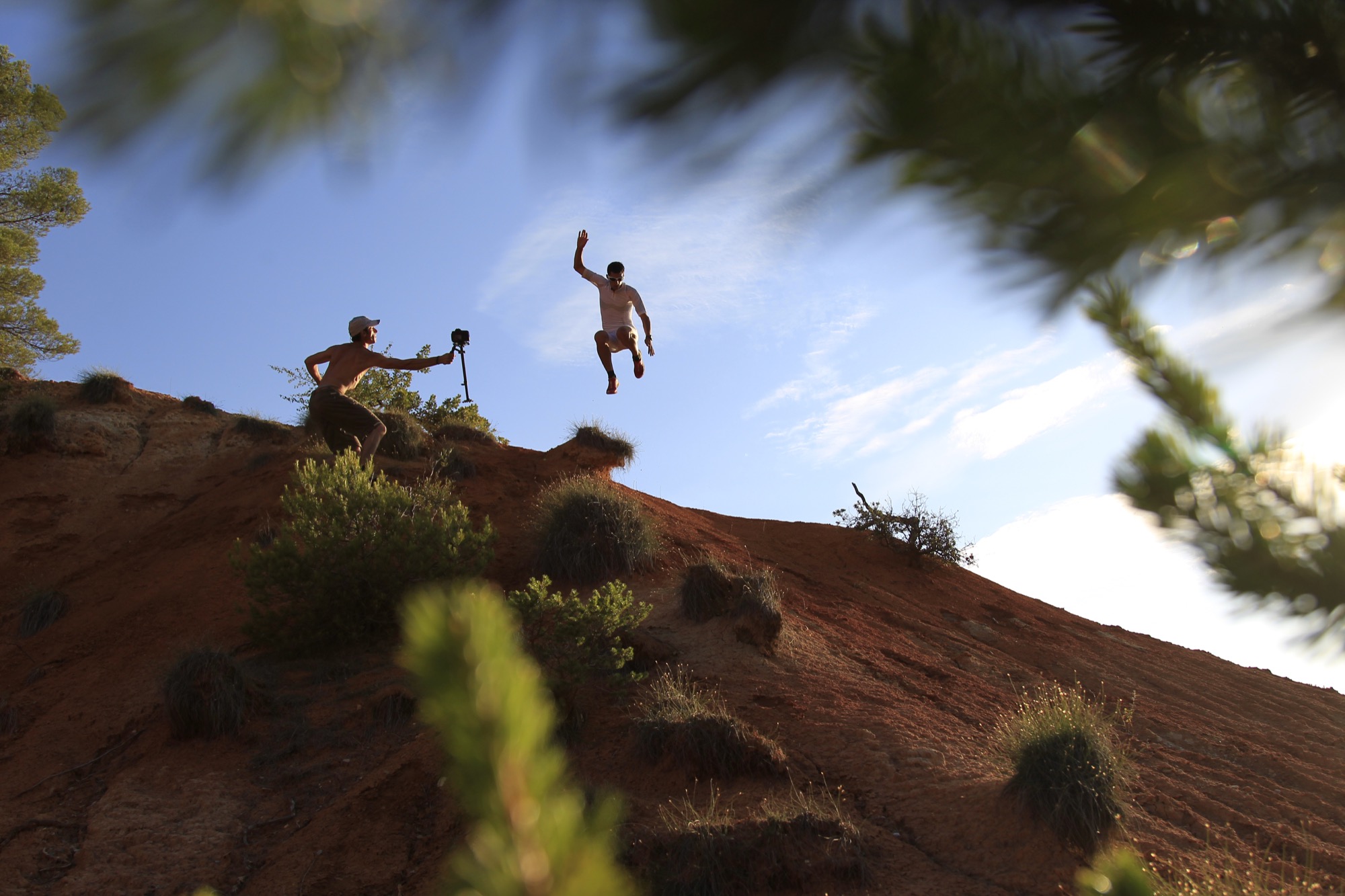
The summit of the adventure in Back to the Fjords occurs when The Flying Frenchies assemble and test an enormous human catapult they’ve dreamed up and meticulously engineered to launch each other off the mountain. It’s carried piece by piece up to the peak and assembled near the edge, a colossal experiment. The vision was to shoot performers skyward—all the while hoping they wouldn’t pass out from bearing up against 10 Gs—so they’d still be able to safely deploy their parachutes to float down to the valley below.
The filmmaker says, “Most of the people I film are people I know as friends, or have gotten to know from working and living in the mountains. The extreme sports are what they do, but it isn’t who they are...so filming the sports is a way of telling their stories. And, of course, these sports have a big visual impact.” There is intimacy in watching someone embark on the unknown. The viewer feels the sensation of being set free along with the performer and can experience, in tandem, a refreshing jolt of the liberation that comes from propelling at breakneck speed through the air, arms and legs flailing about.
“The extreme sports are what they do, but it isn’t who they are...so filming the sports is a way of telling their stories.”
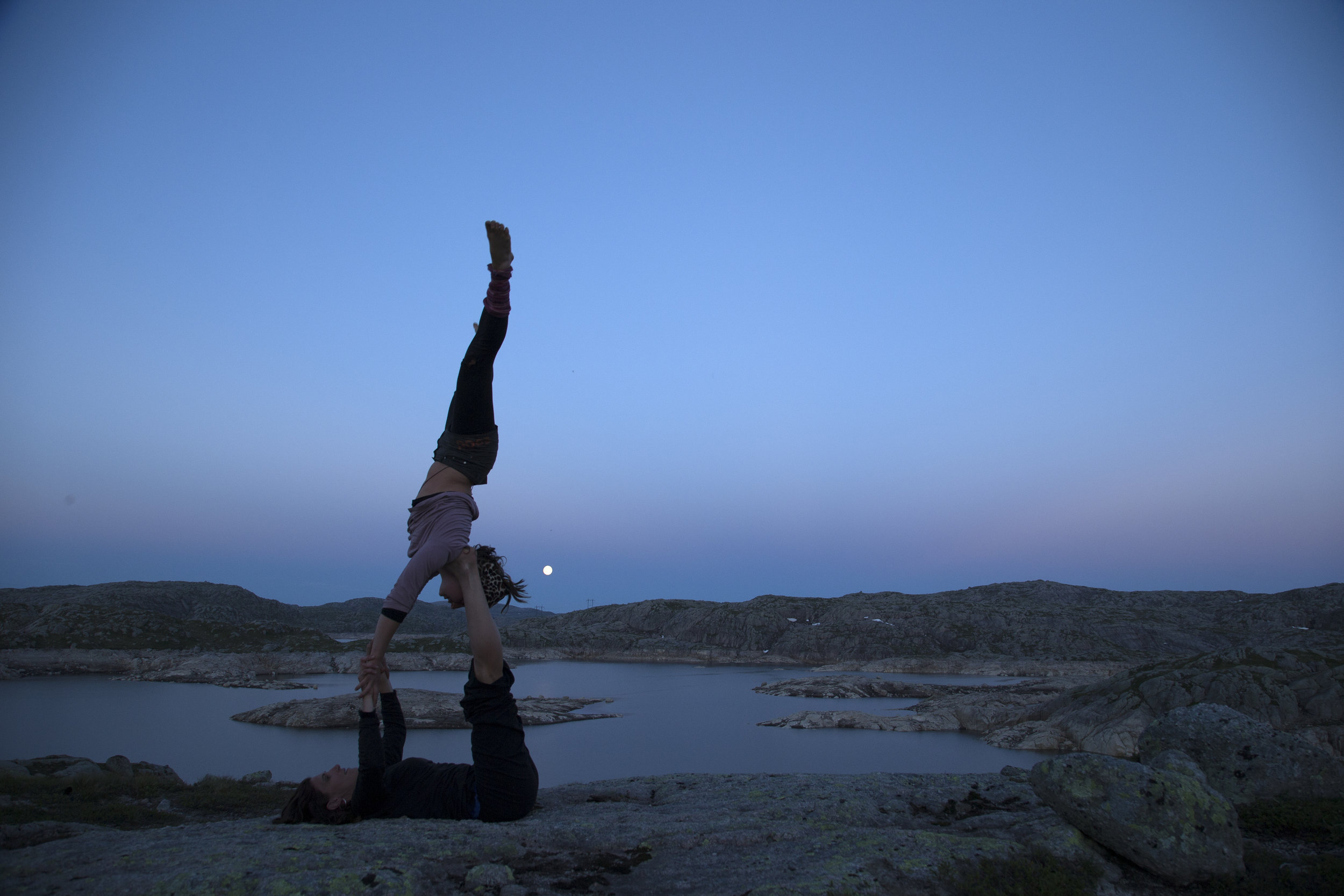
Seeing The Frenchies feed off and inspire one another, their sense of camaraderie and friendship is palpable. Montaz-Rosset shows how these friends test the boundaries of their bodies and their relationships. The filmmaker and his subjects together push the confines of their sport and their personal lives. Pioneers in adventure-filmmaking and new sports, they transform viewers by manifesting that the impossible is possible. △
In Memoriam Tancrède Melet
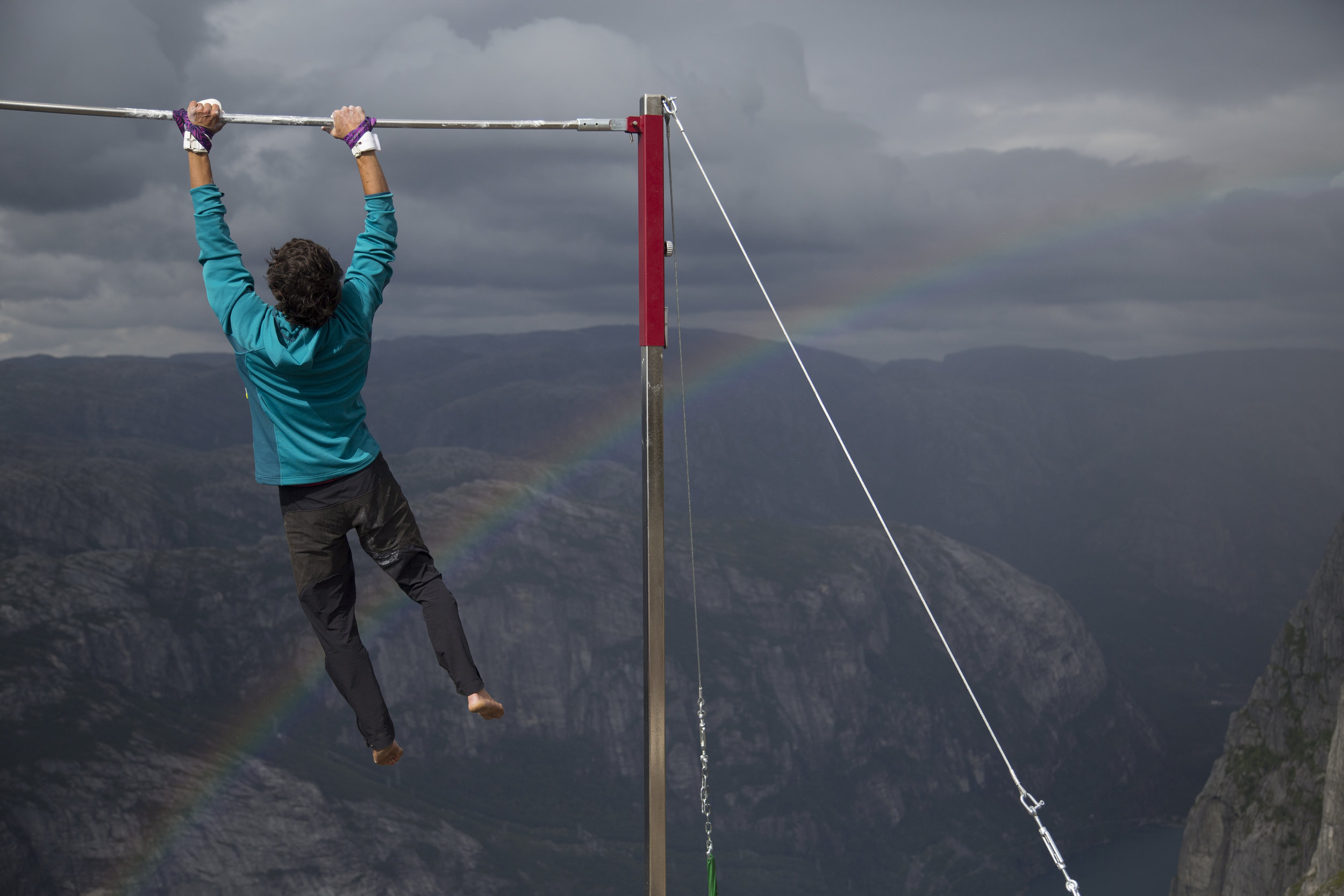
With the heaviest of hearts, we are sharing with you that shortly after this story was written, we learned Flying Frenchie Tancrède Melet died while preparing for a hot-air balloon stunt in Drôme, France, in January. The 32-year-old expert slackliner, BASE jumper, and wingsuiter accidentally fell approximately 100 feet (ca. 30 meters) when the bal- loon abruptly sprang off the ground. Melet leaves behind a life companion and a young daughter. His death is a stark reminder of how all too fragile life truly is and that no matter how trained we are, how meticulous, how dynamic, how invaluable to others—the unthinkable still happens.
Quietly Technical
A conversation with Aether Apparel founders Palmer West and Jonah Smith about fashion, functionality and travel
Springboarding off a career in coproducing independent films (Requiem for a Dream, Religulous), world travelers and urban explorers Palmer West and Jonah Smith founded the clothing label Aether Apparel on their shared adventure spirit and passion for functional, modern design.
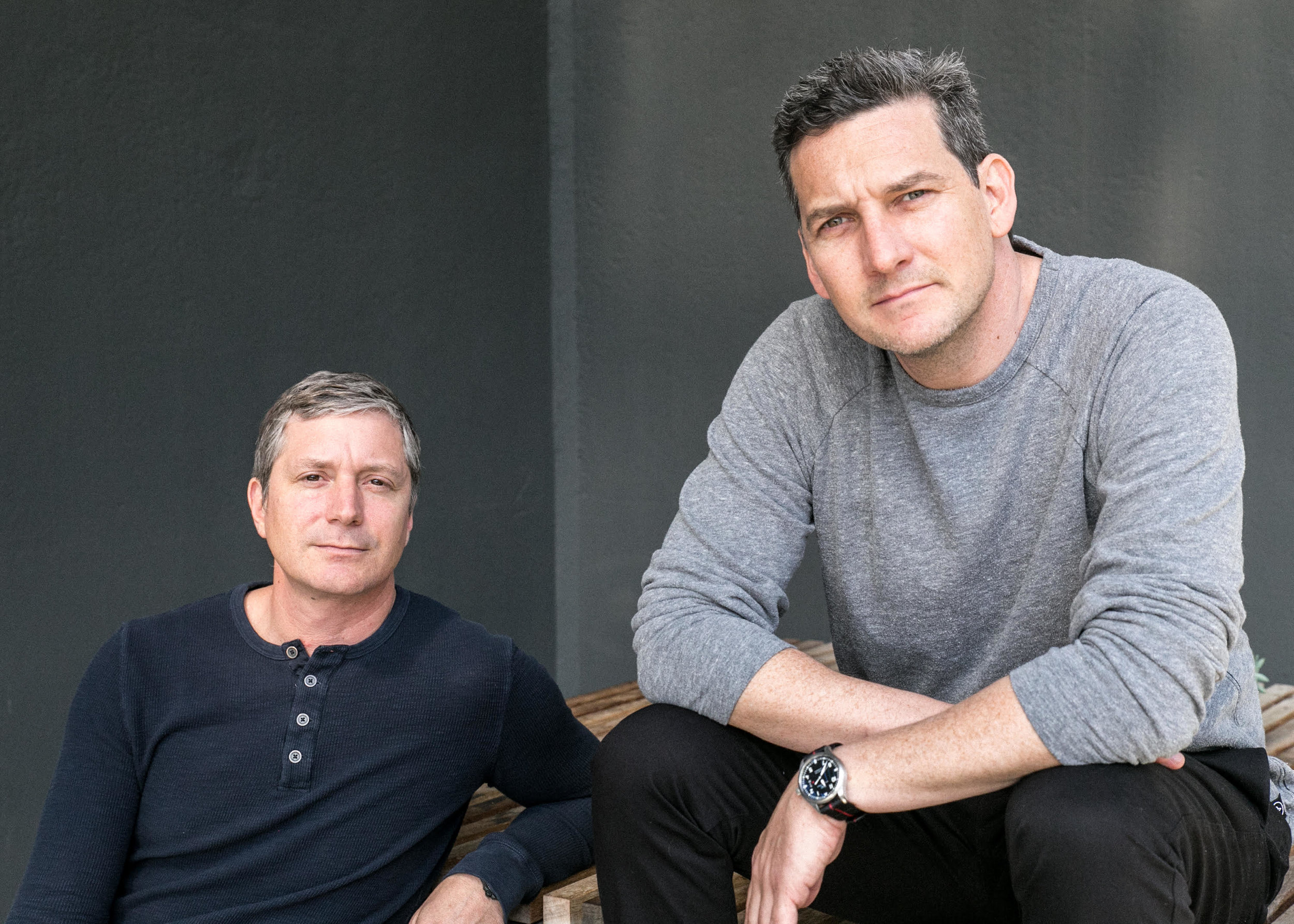
AM What inspired you to embark on this new endeavor of starting your own clothing brand?
JS Palmer and I had been working together in the film industry and had produced ten movies together over a ten-year period. We were growing tired of film and knew we wanted to do something else. Also, we were in our mid-thirties and were re-evaluating our priorities.
PW We liked working together, and we started looking for another business to start. We wanted a business that would interest us, and we set up parameters that fit our creative desires and supported a lifestyle we wanted to live.
JS As “weekend warriors,” we were tired of the clothing options we found available, and the idea of developing a clothing line resonated with us. There was nothing sophisticated enough that we could wear both out of town on the weekend and back at home in the city. We started looking around and we found a void in the marketplace—there was a big distinction between fashion and what you could find at REI.
“We found a void in the marketplace—there was a big distinction between fashion and what you could find at REI.”
PW When Jonah and I made movies, we said we strived to only make movies we would want to see on opening night. We’ve always wanted to be fans of what we do, and we’ve kept the same mantra—we build things that we will use. It helps us stay true to a singular vision. We build what we believe in.
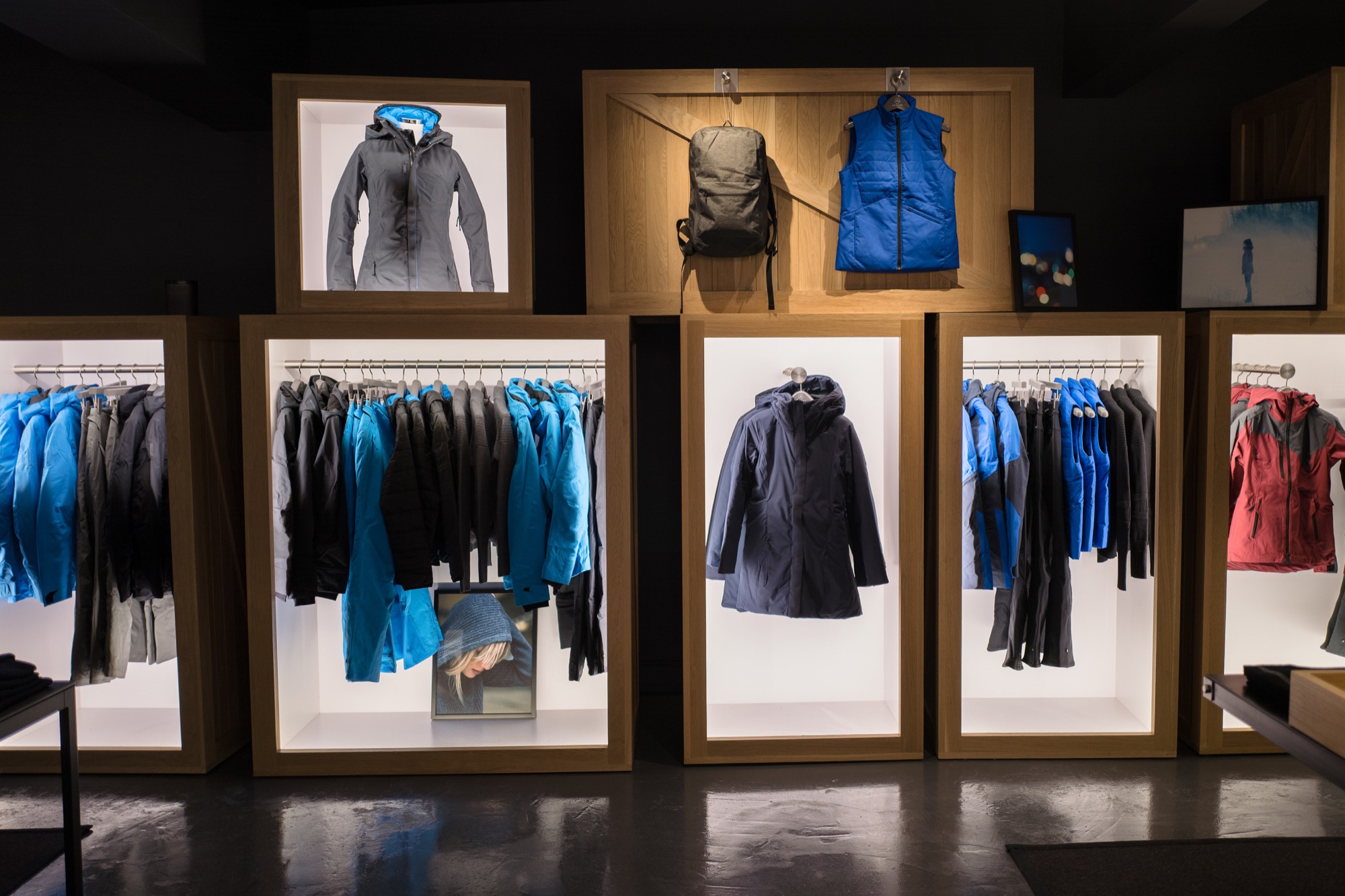
“We’ve always wanted to be fans of what we do. We build things that we will use. It helps us stay true to a singular vision. We build what we believe in.”
AM What’s your idea of a great adventure?
PW We struggle with what most people think of as adventure. For us, adventure and travel also evoke city, not just the backcountry. Adventure in the city can also be awesome.
Adventure is stuck in a box. One destination. Being a citizen of the world requires flexibility. You’re not just one person, nor are we asking you to be one.
AM What’s your vision for the brand?
JS We are building something—an aspirational brand with imagery and travel. We’re not hippy crunchy and we’re not high fashion—we’re in between. Design and functionality is important to us, and we are trying to make a brand that’s authentic and real. We are in the space between those.
“For us, adventure and travel also evoke city, not just the backcountry.”
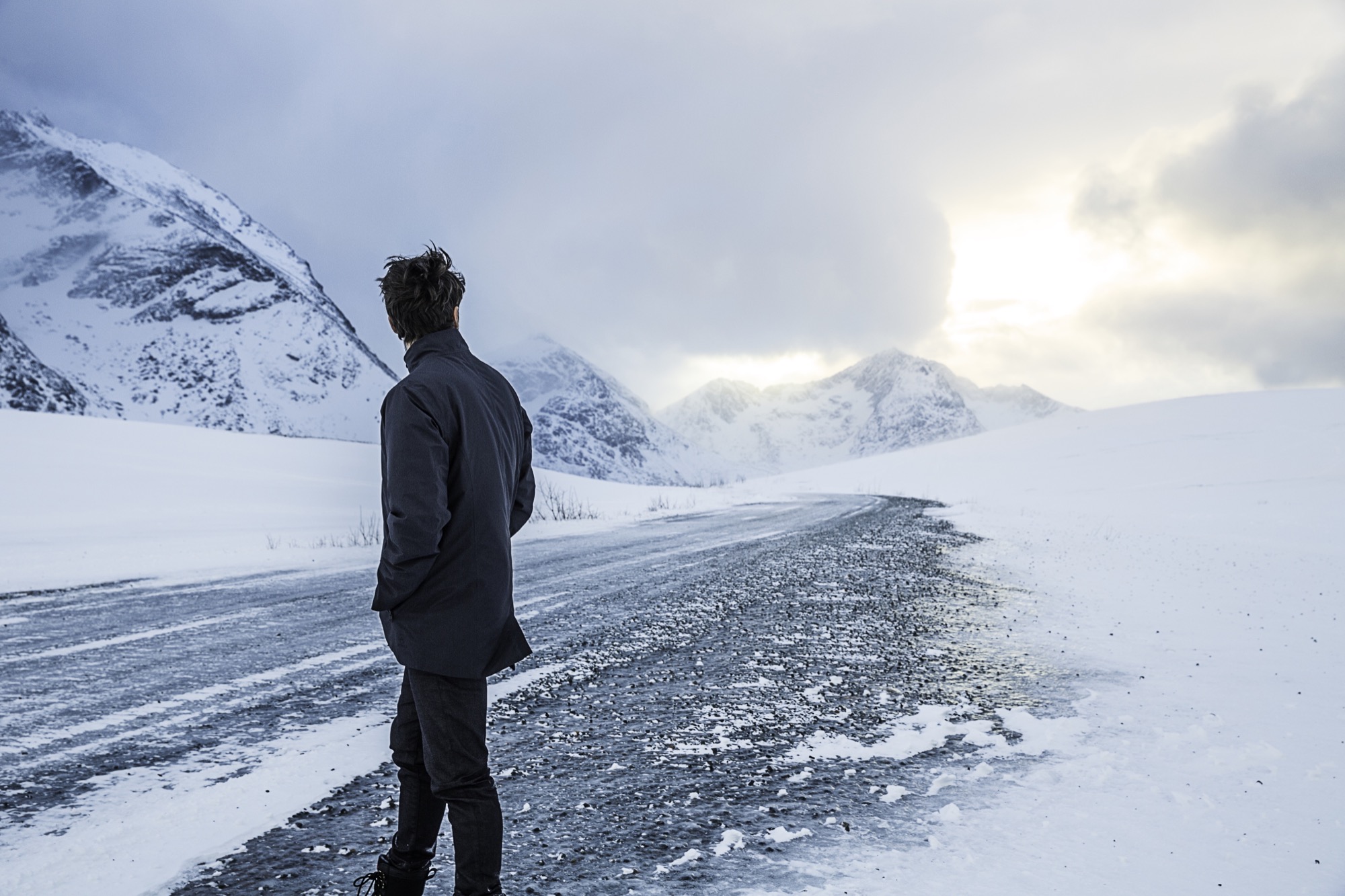
AM Who are you, and for whom do you design?
PW We represent the traveled individual—someone who is young at heart, with an adventurous spirit.
We use imagery to connect with people. We want people to see these images and think, “Where was that?” We want to reach out to people and have them experience the places we love.
AM Talk about your passion for exploration and discovery...
JS We want to go to new places, experience new things, and we support the adventurous spirit in others. We share our stories and images to inspire this spirit of adventure. We often talk to customers who ask for input or suggestions on trips they are planning or tell us we’ve inspired them to visit a location. This is our passion.
PW Functional design inspires us. We make clothing that is built for adventure but still looks good at home. You don’t have to have a separate wardrobe. Clothing can be beautiful but doesn’t reek of utilitarianism. It’s quietly technical.
“Clothing can be beautiful but doesn’t reek of utilitarianism. It’s quietly technical.”
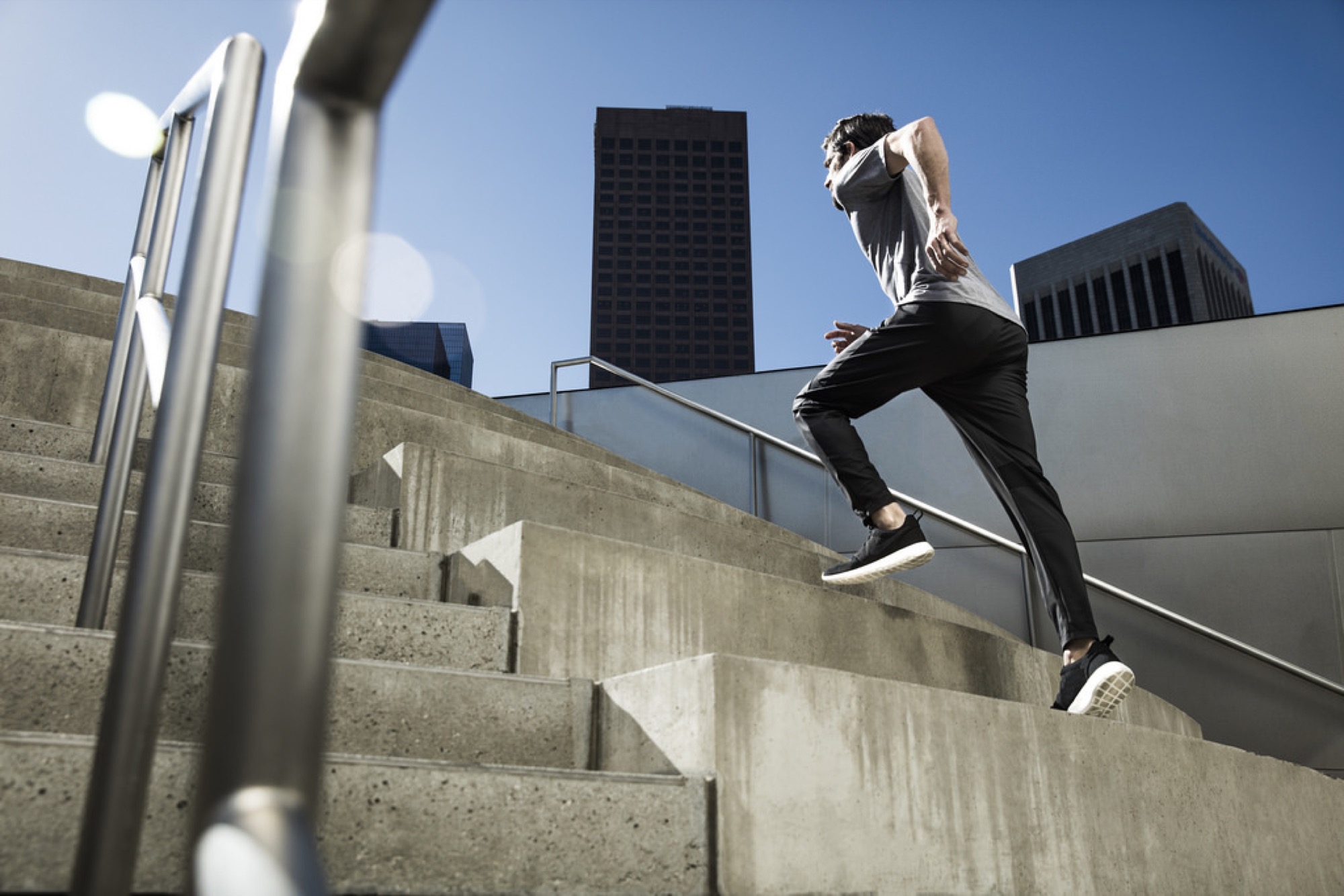
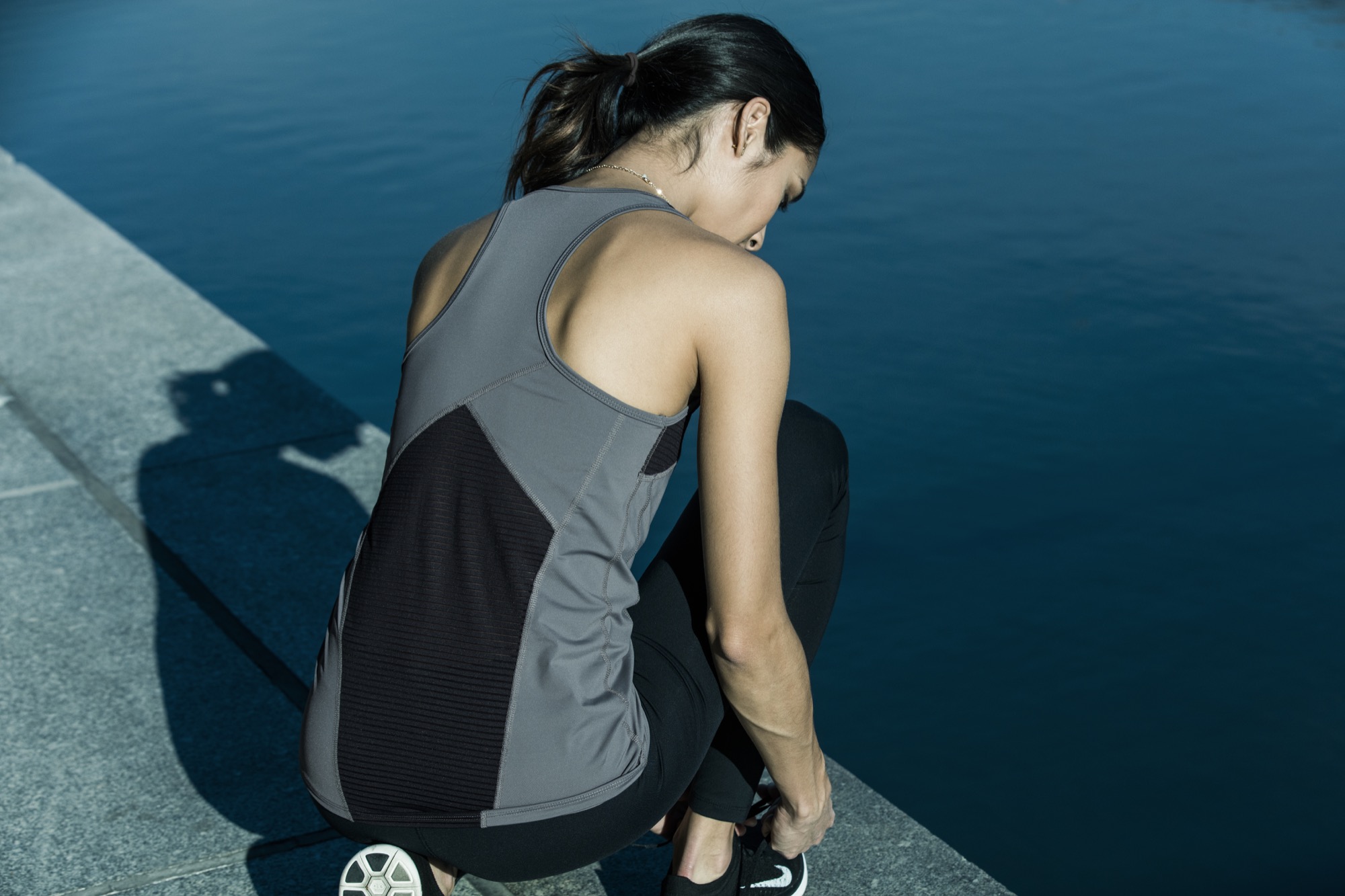
AM How did your background in film prepare you for starting a clothing company?
JS We came into this business being consumers. We came with opinions and with personal needs for our wardrobe.
Being a film producer, you’re the contractor. You hire people, resolve problems and then produce and execute.
“We came into this business being consumers. We came with opinions and with personal needs for our wardrobe.”
PW Producing movies and making clothing is the same thing: There are hundreds of balls in the air. You have to come in on budget and on time. You have to come together and on point. The “production hat” is very similar. You need a clear vision and then deliver it.
“Producing movies and making clothing is the same thing—there are hundreds of balls in the air.”
The film industry is visually driven, and it was easy for us to tell our story. In fact, we want to tell the story... without making us the central character. Our goal is to be true to who we are and speak to this. We tell our story through imagery.
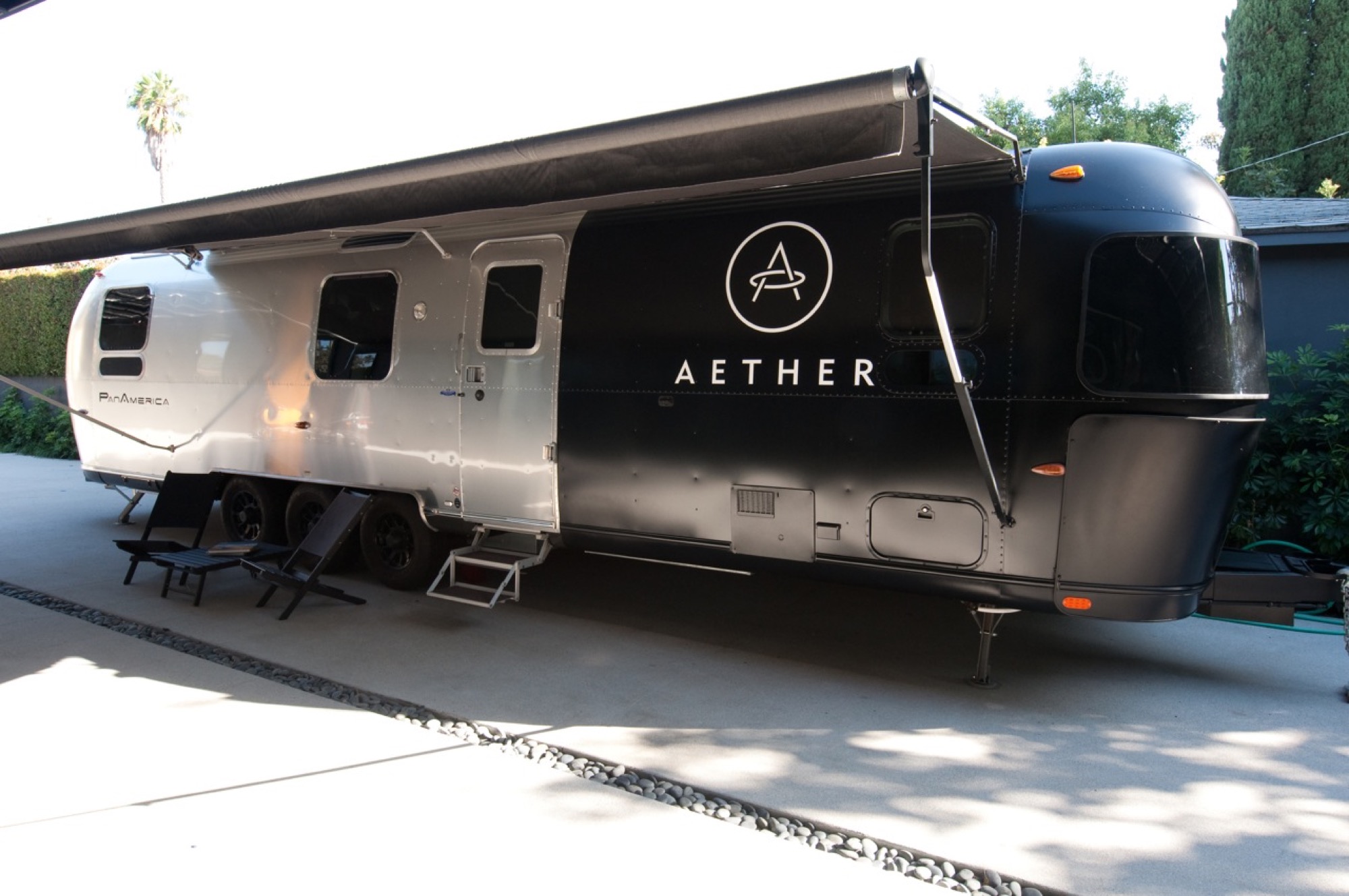
AM What makes a great design partnership? Describe your collaboration. What does each of you bring to the table?
PW We get this question a lot. We’ve worked together for twenty years, and what makes a great partnership is a similar vision and knowing that we are going to the same place.
JS We look at things completely differently, but we compliment each other. There’s a freshness in looking at someone else’s perspective. If you have enough faith and trust in each other’s viewpoint, you can get to the next level.
AM The architecture of the Aether Apparel locations is truly distinctive. What role does the design of your stores play in telling your story?
JS Our film background is two- or three-dimensional, and we wanted to build an interactive environment to display our product. We trusted that if we built our stores in a way that embraces industrial and modern, and if you like our stores, you will like our clothes.
Our San Francisco location is made from three shipping containers stacked on top of one another and has a custom-designed dry cleaner’s conveyor belt running the height of the store to get clothes from storage on the third level.
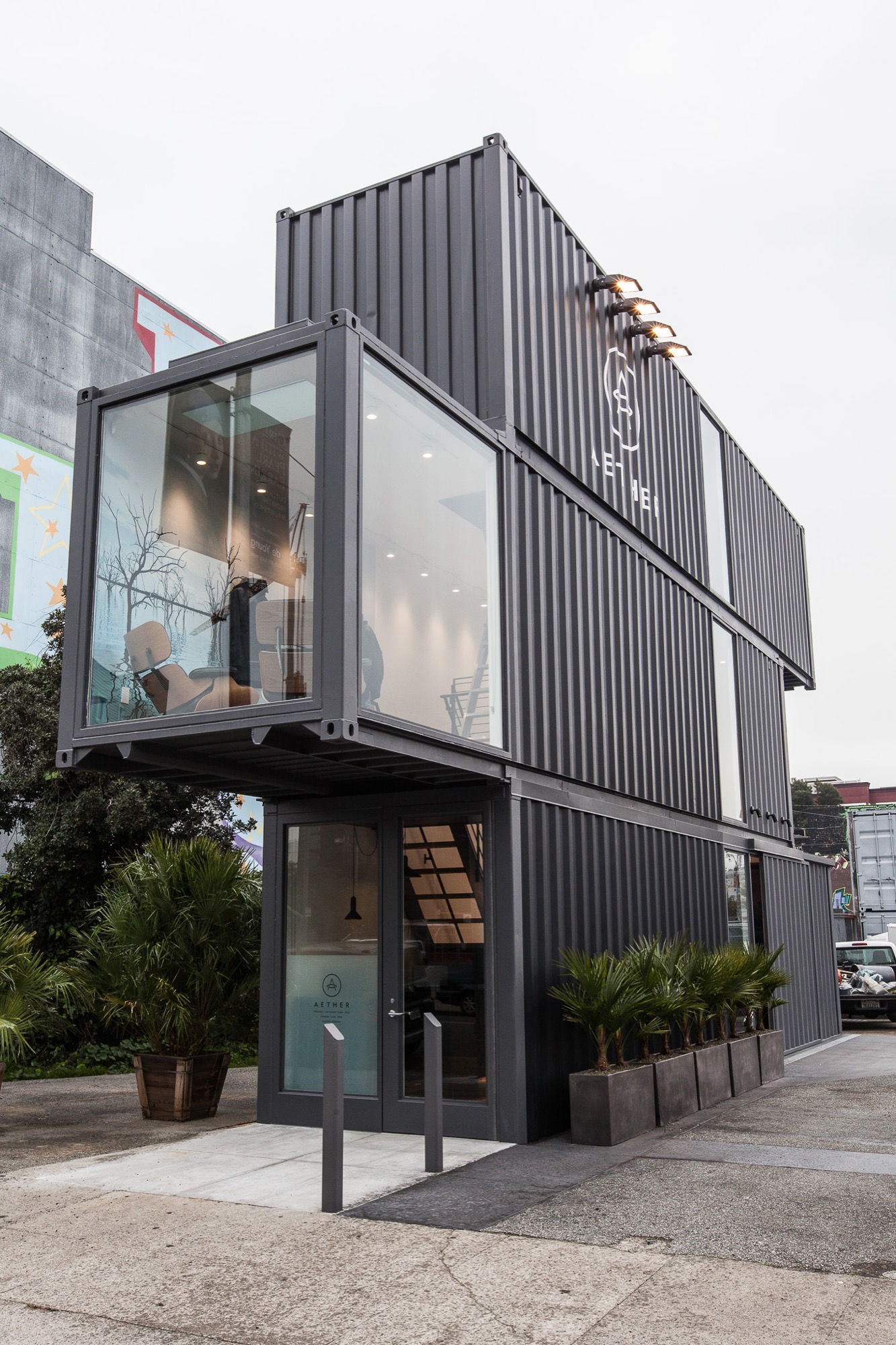
Our other locations—New York, Los Angeles, and Aspen—have elements of the San Francisco location. However, the big component in these stores is large wood containers displaying product lit from within.
PW These large containers are modular boxes that are flexible, fluid spaces. Nothing is built into the brick and mortar of the location.
We were inspired by the idea of a nomadic life, when you would pack all your stuff and move. We like the flexibility to move things around, and besides, it hints at our spirit of adventure.
It’s about curation and presentation. You need to interact with our staff. It’s important that it feels authentic. △
“We were inspired by the idea of a nomadic life, when you would pack all your stuff and move.”
Aether Apparel lookbook Winter 2015/16 & Summer 2016
Photography by Ian Allen

